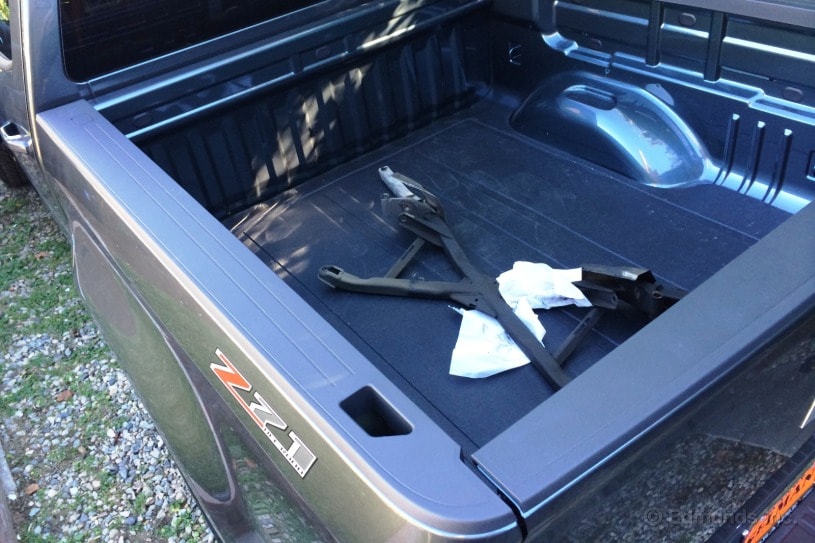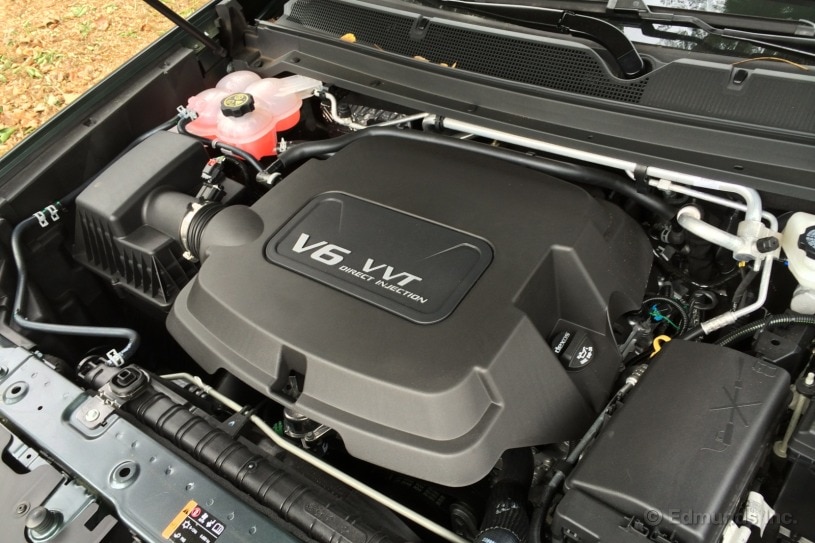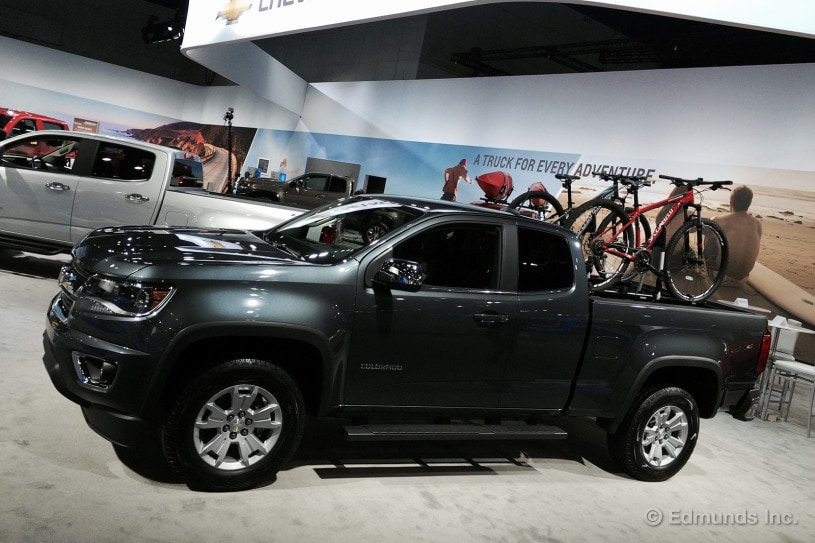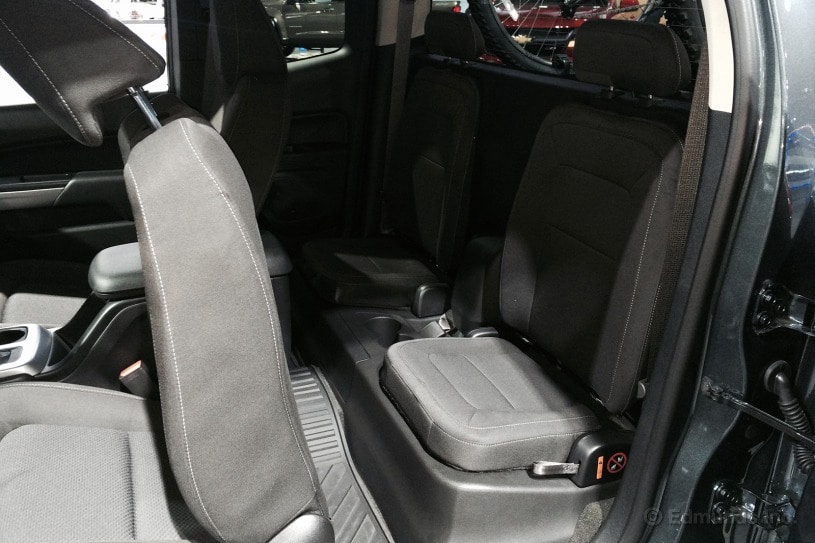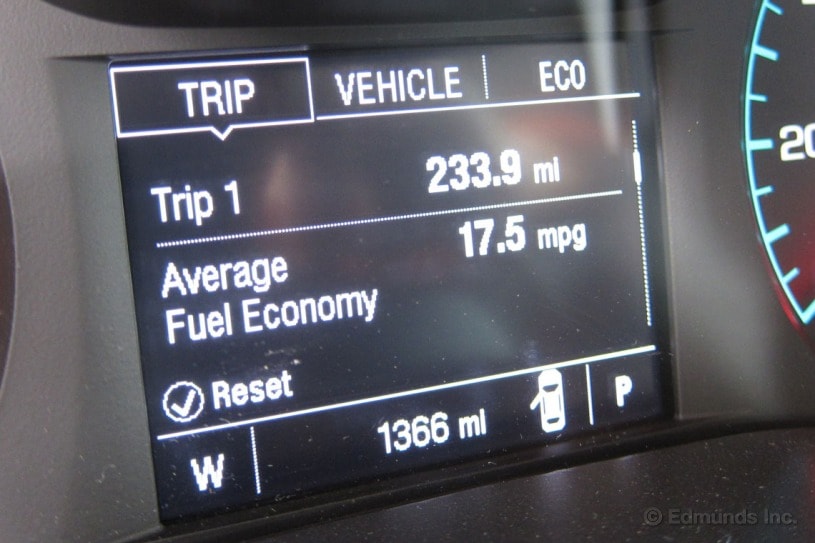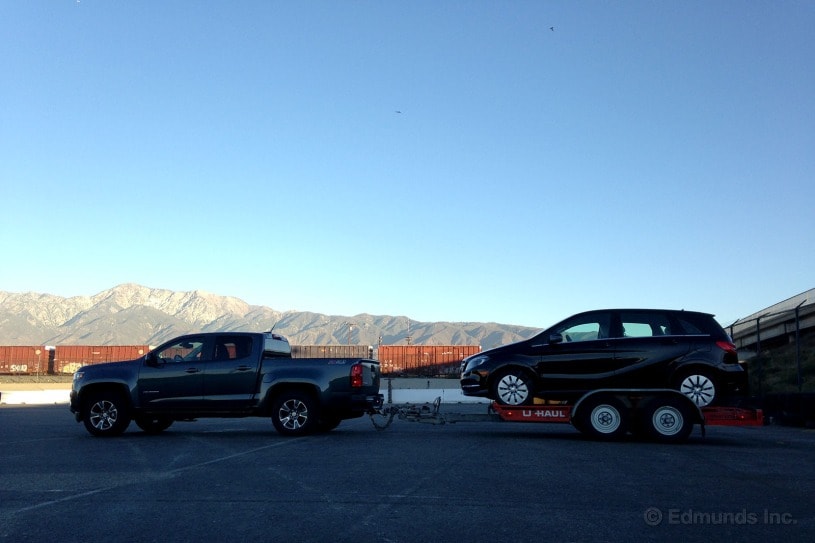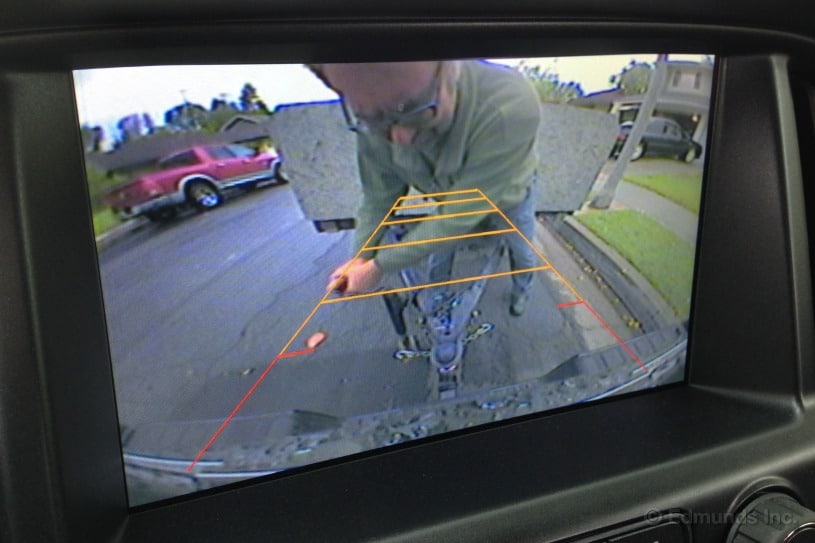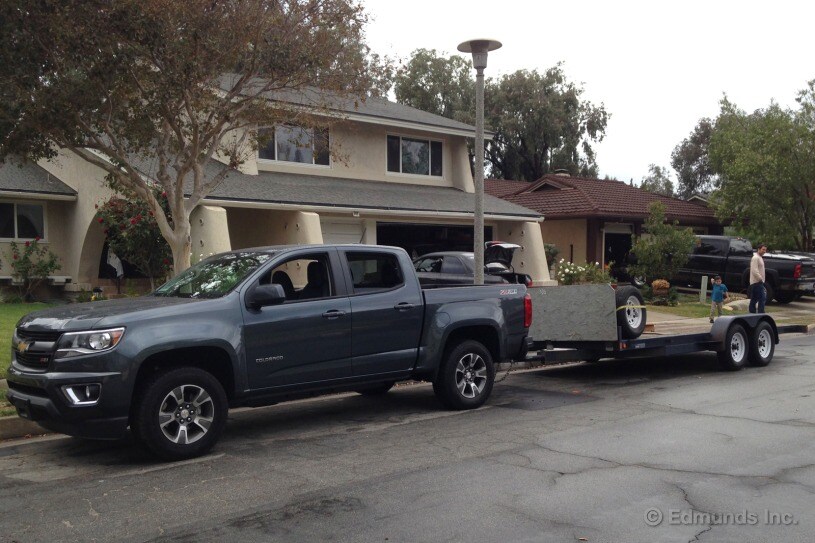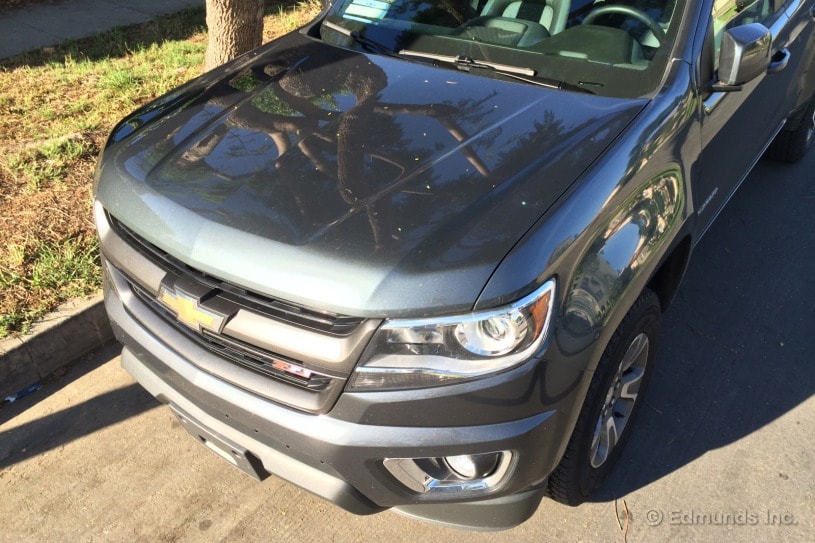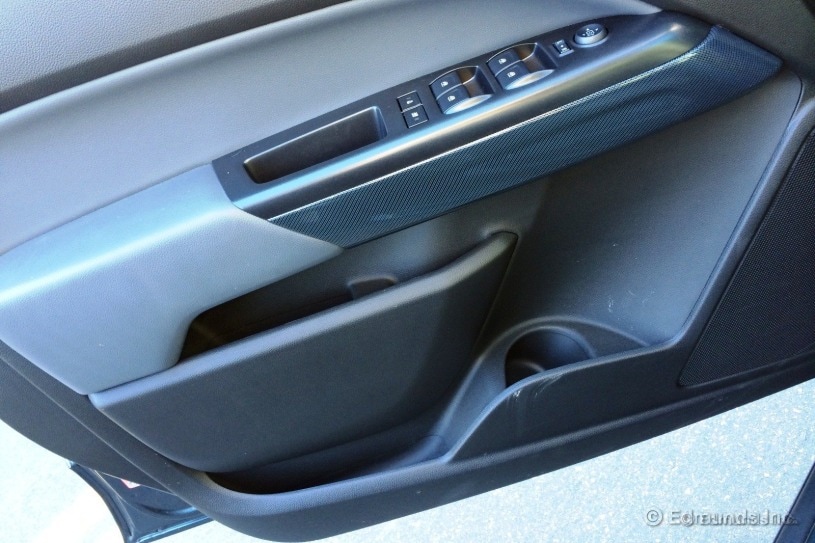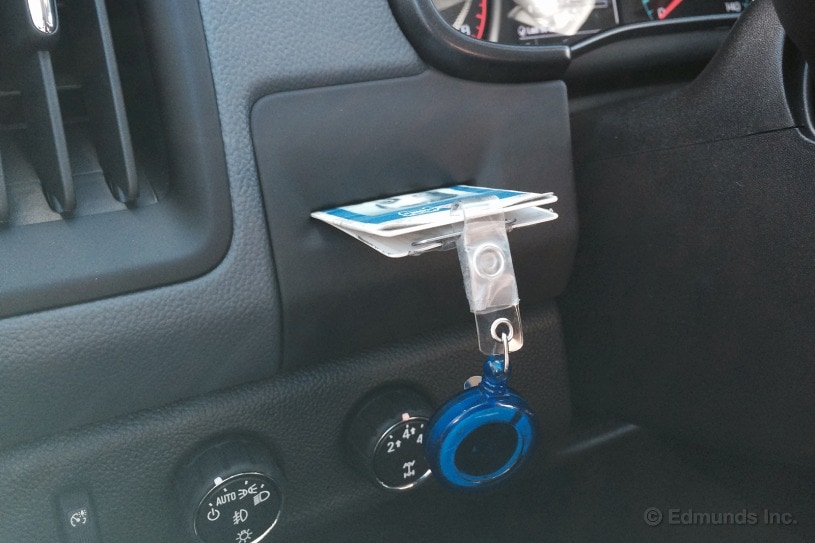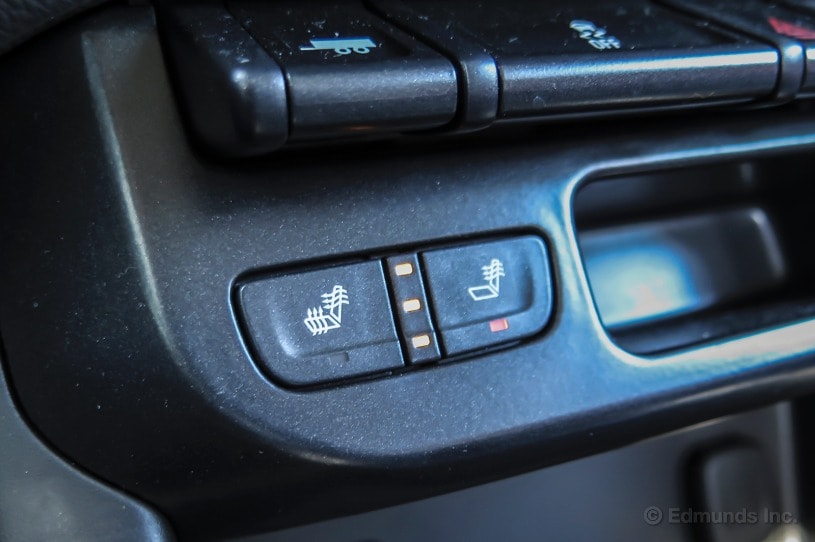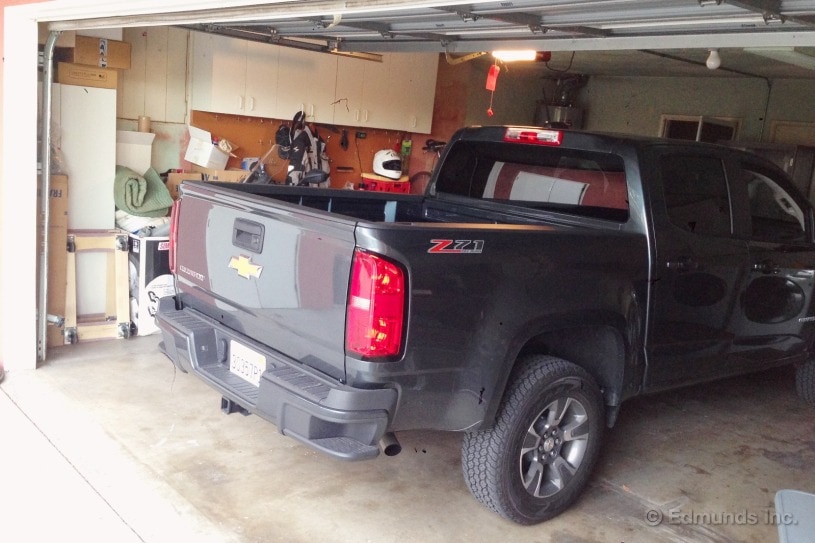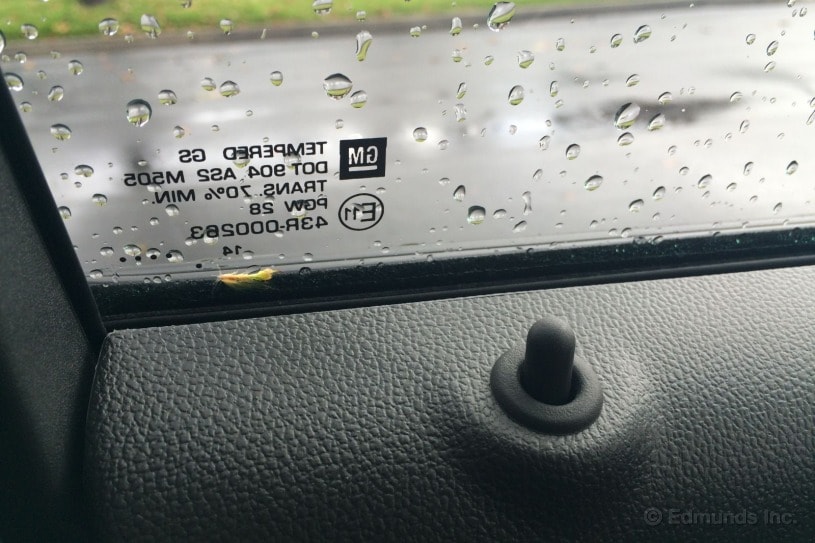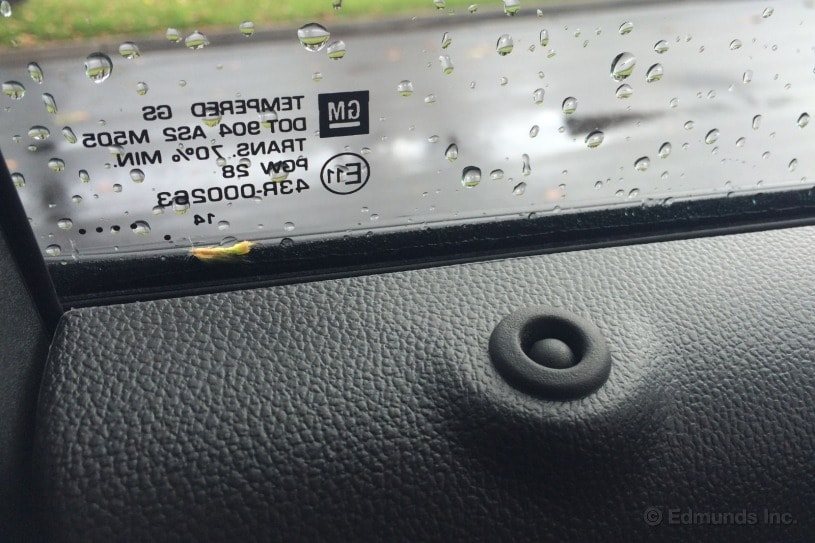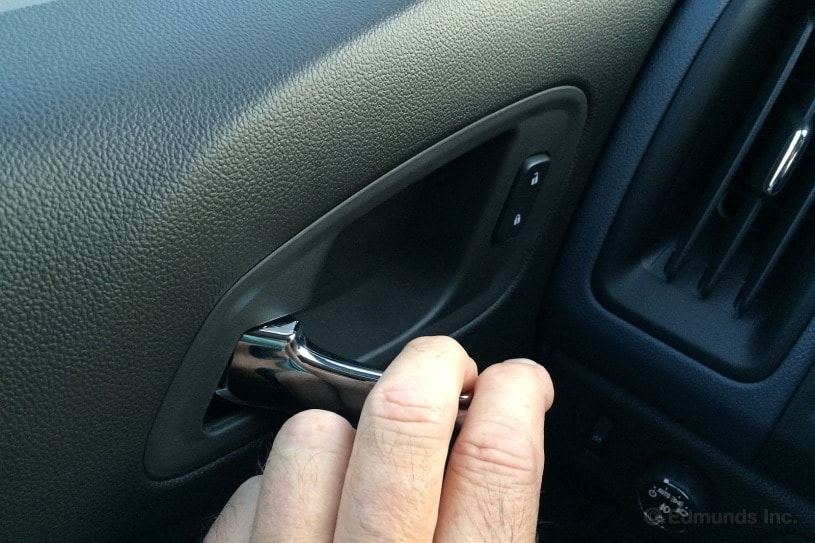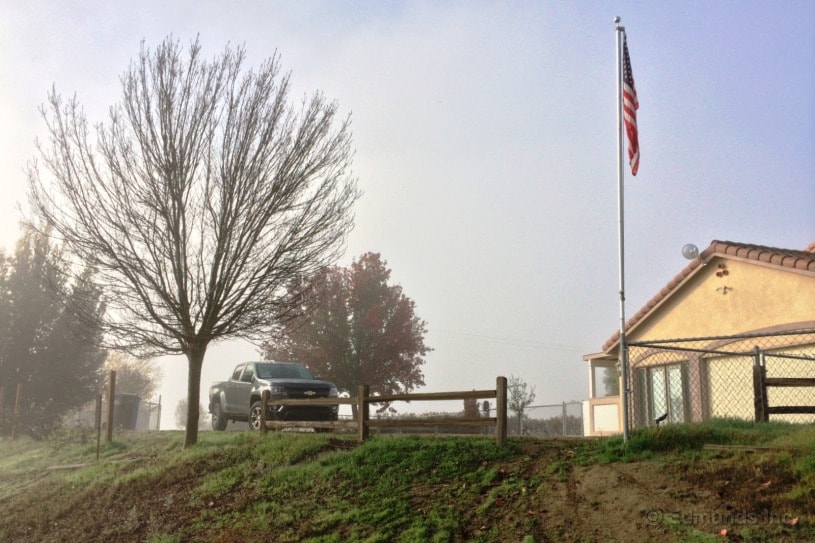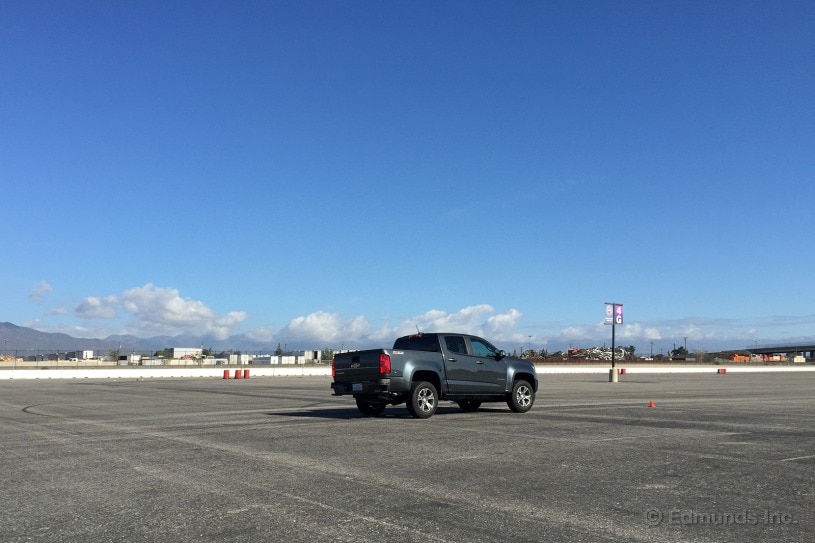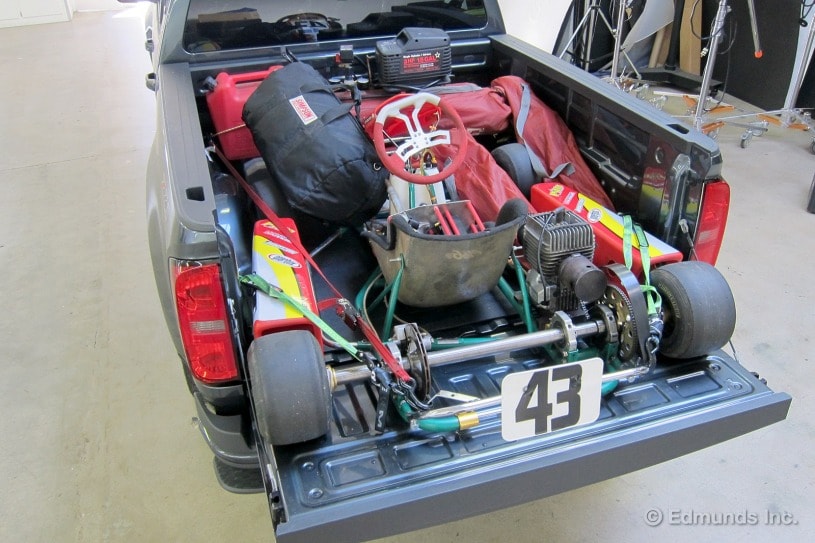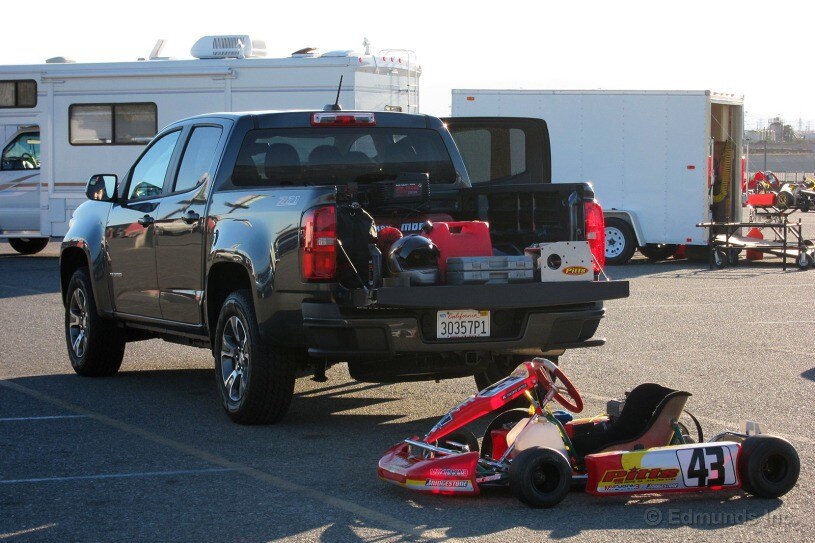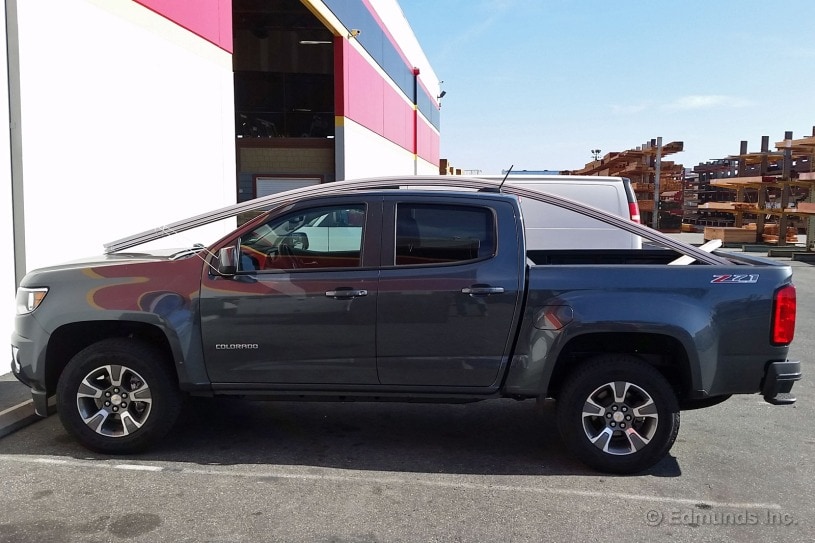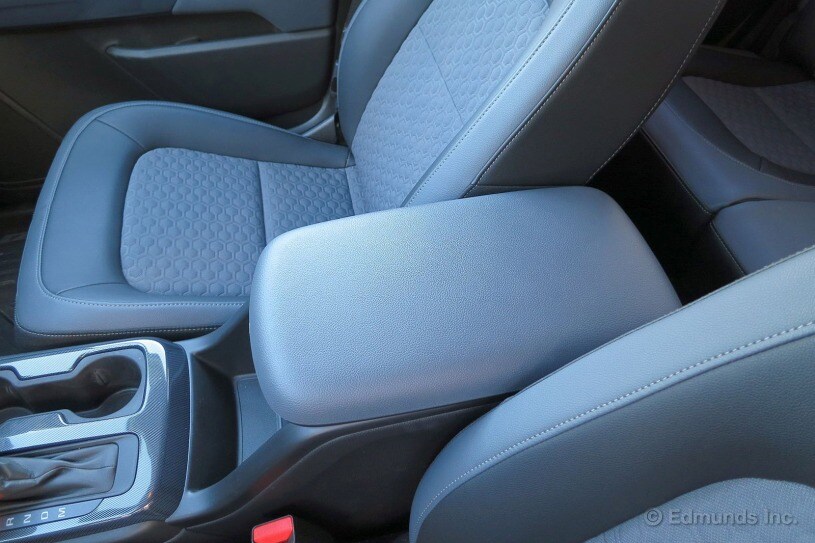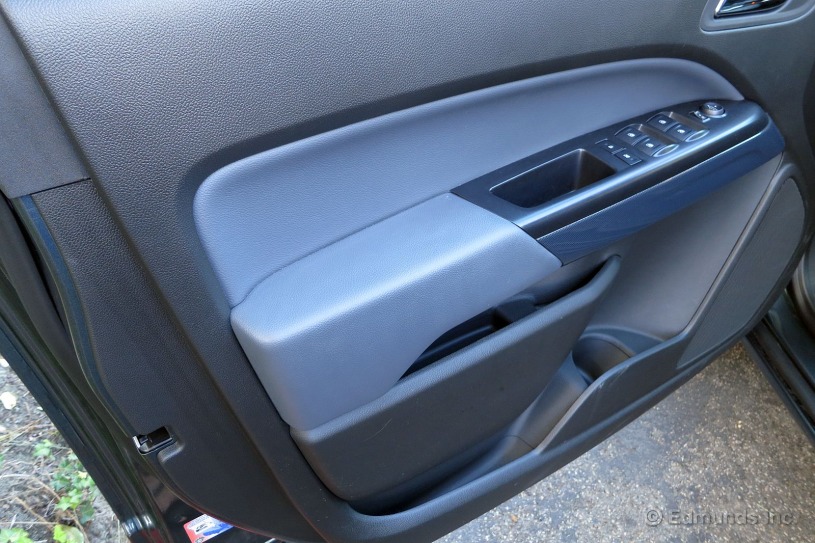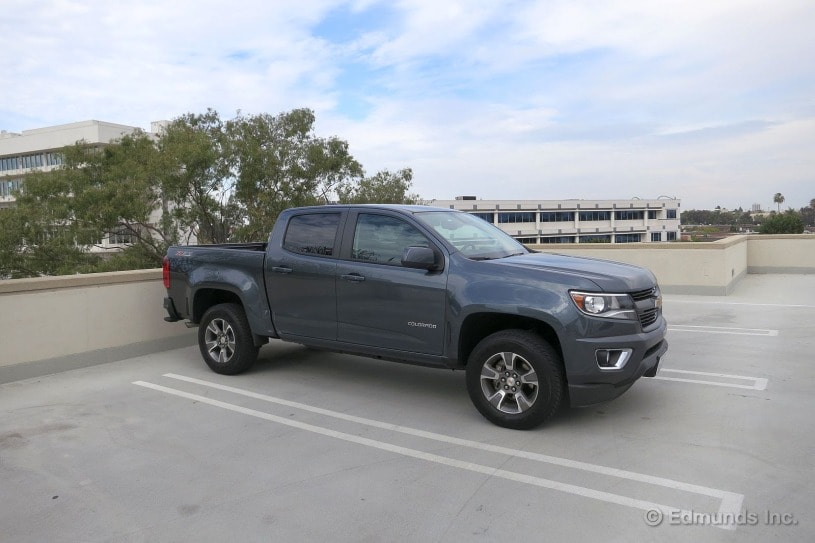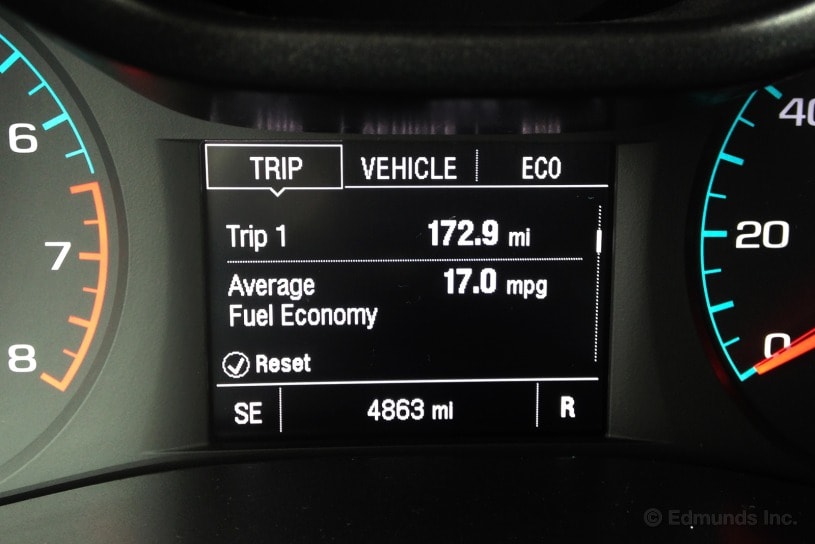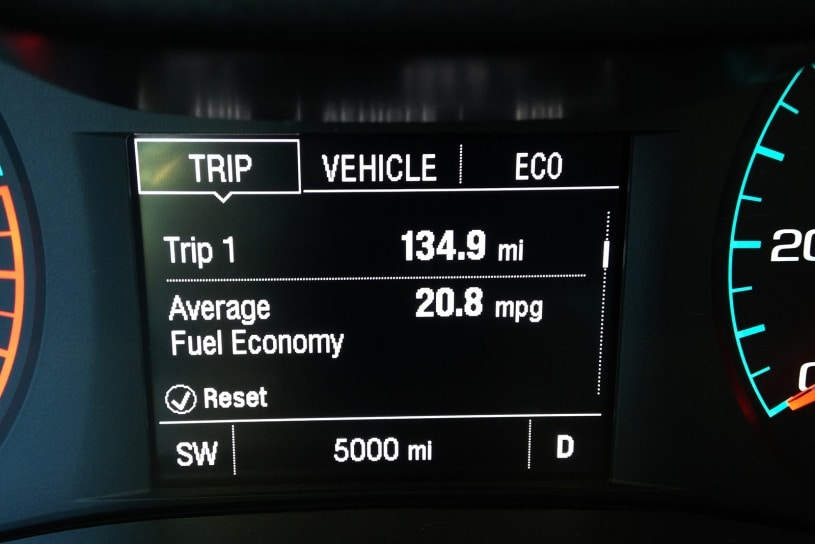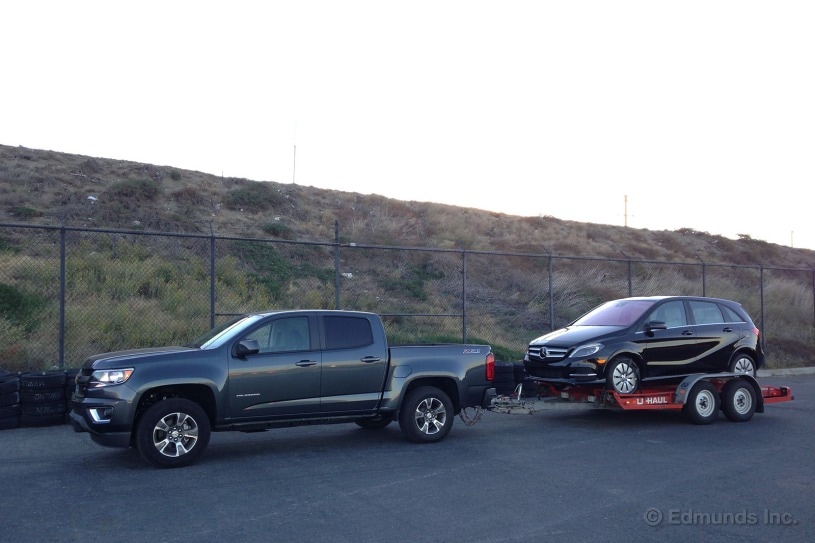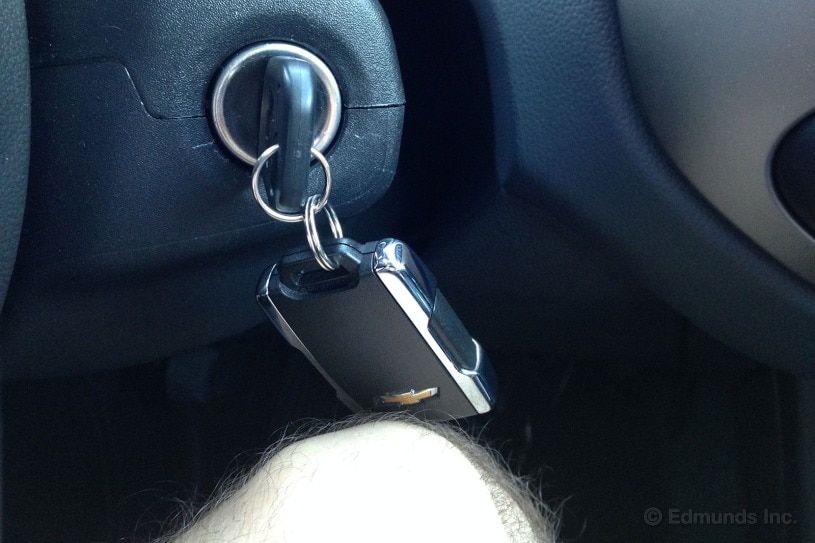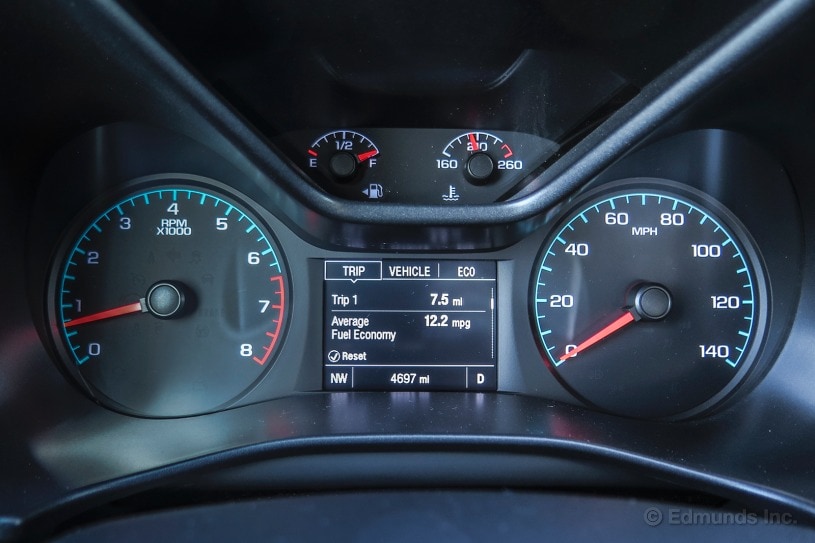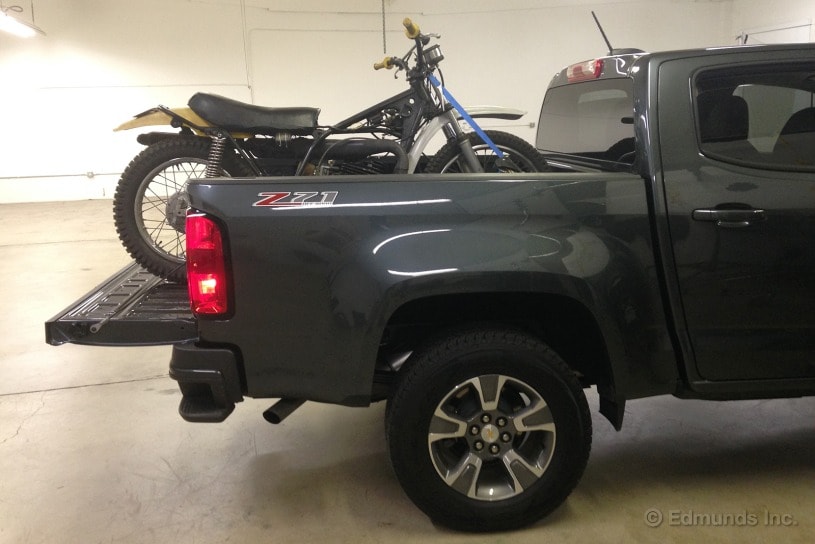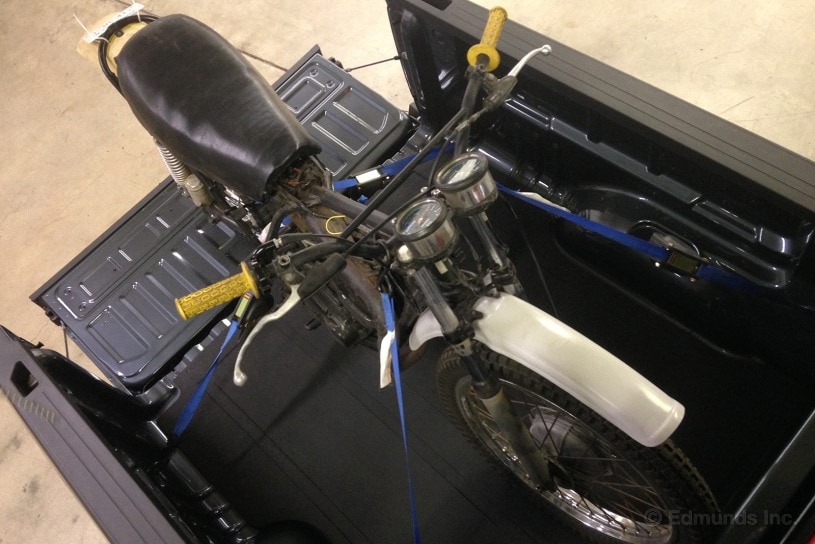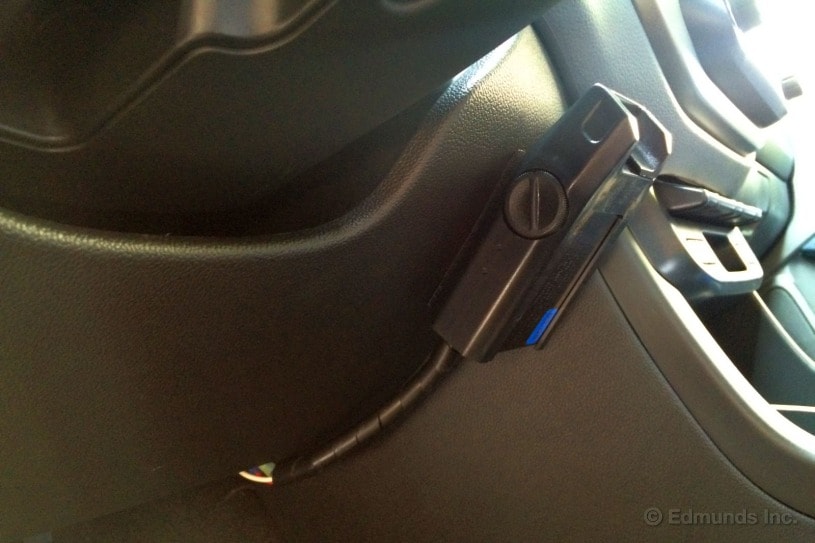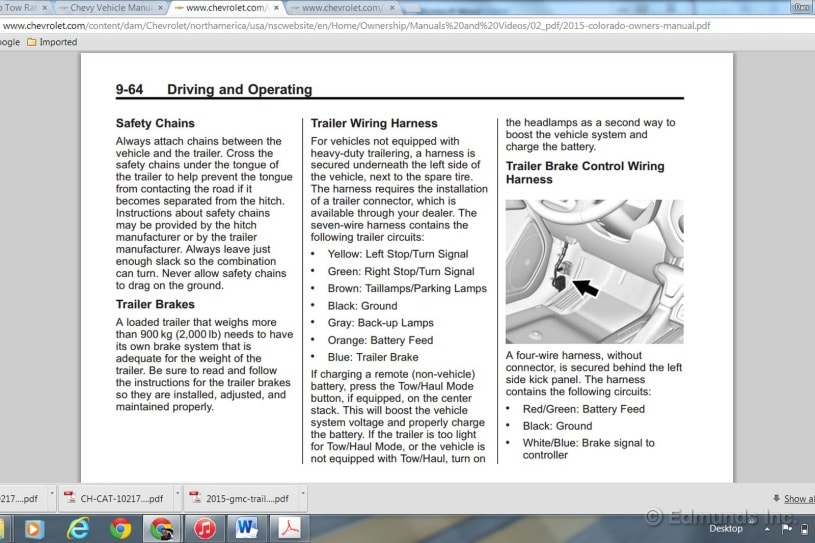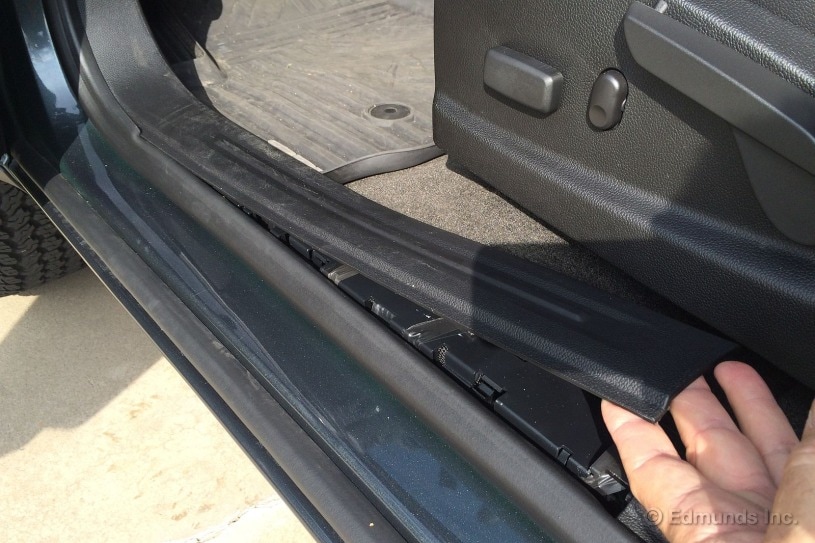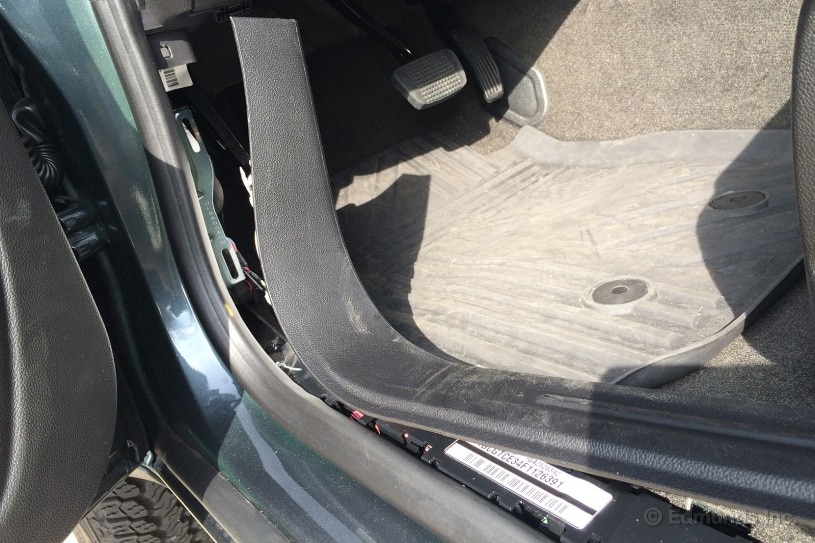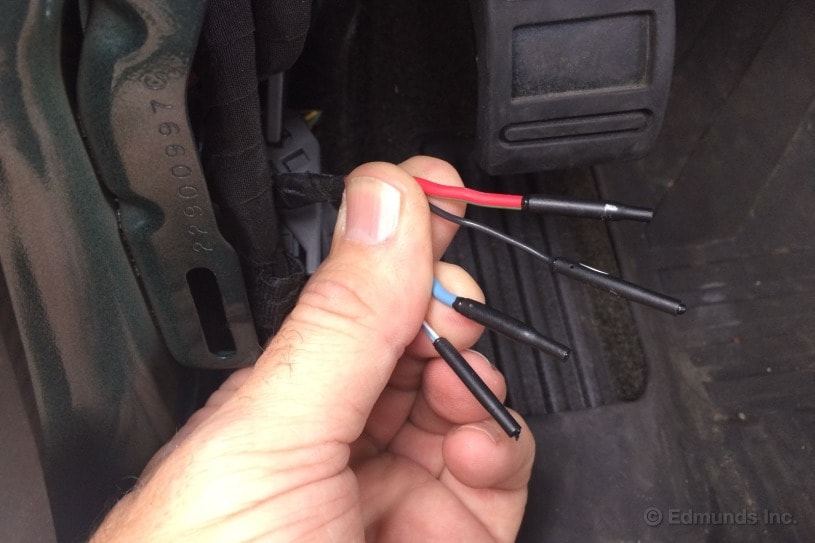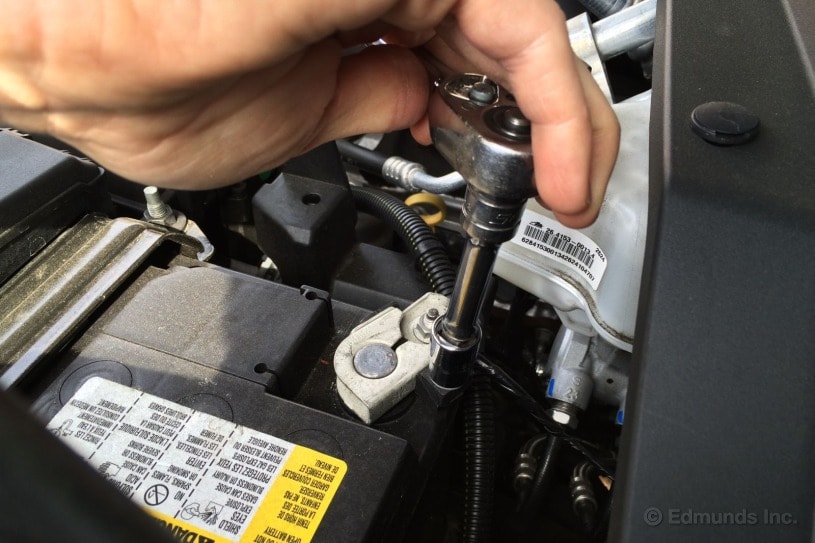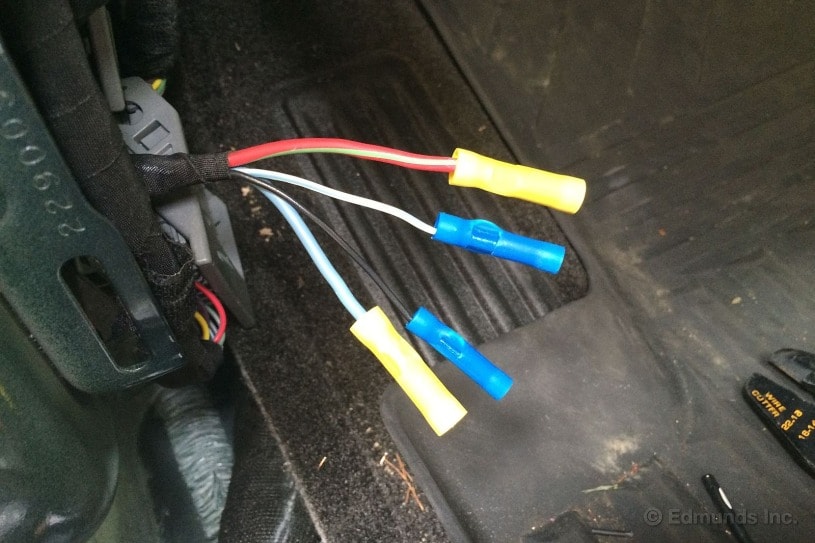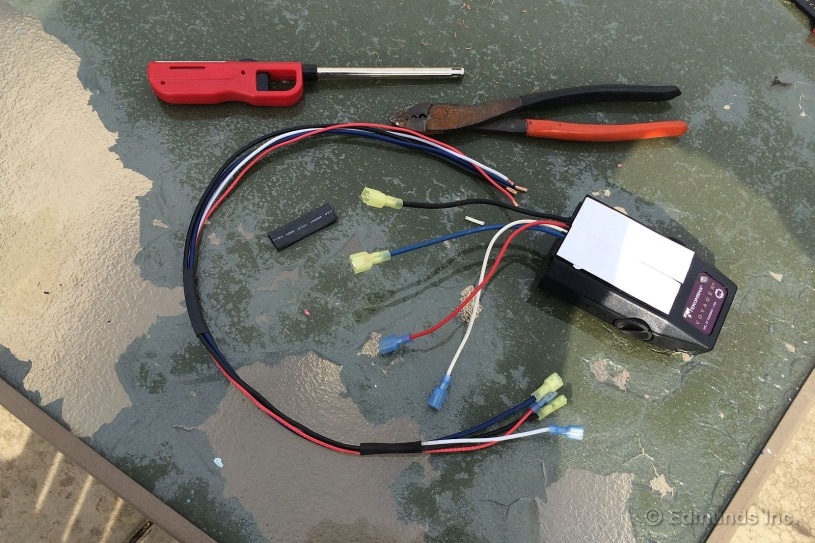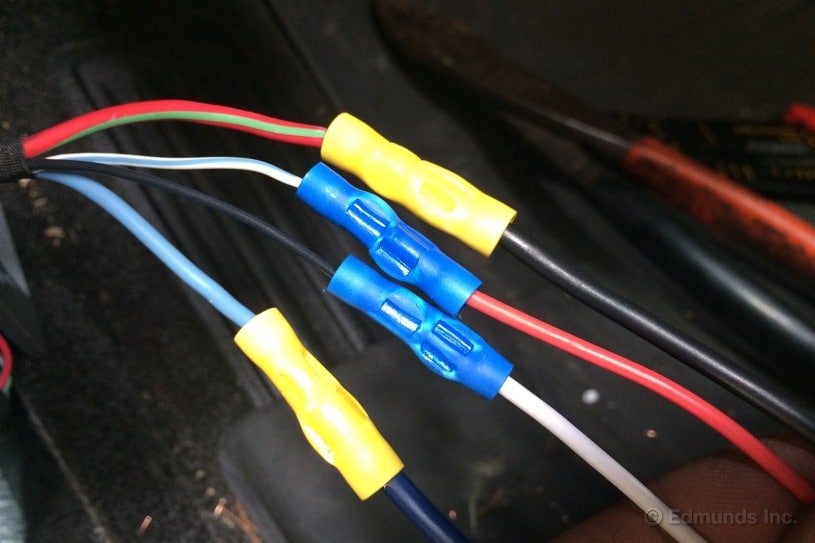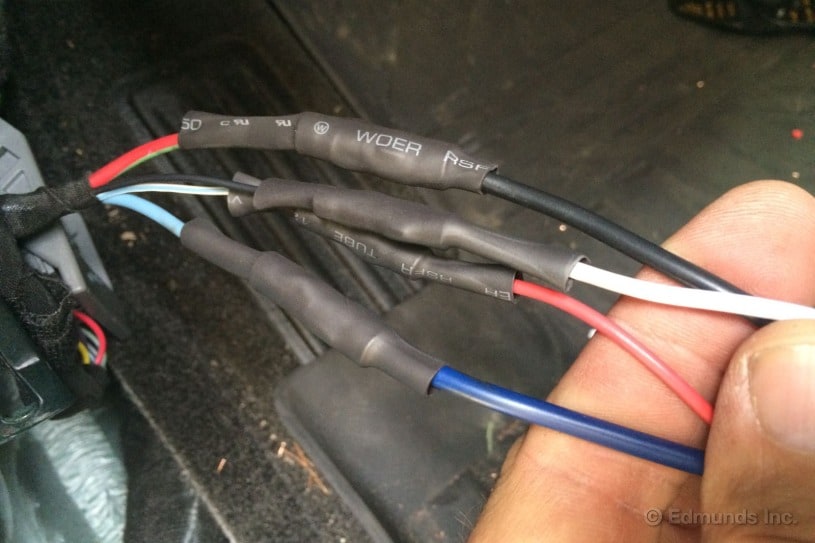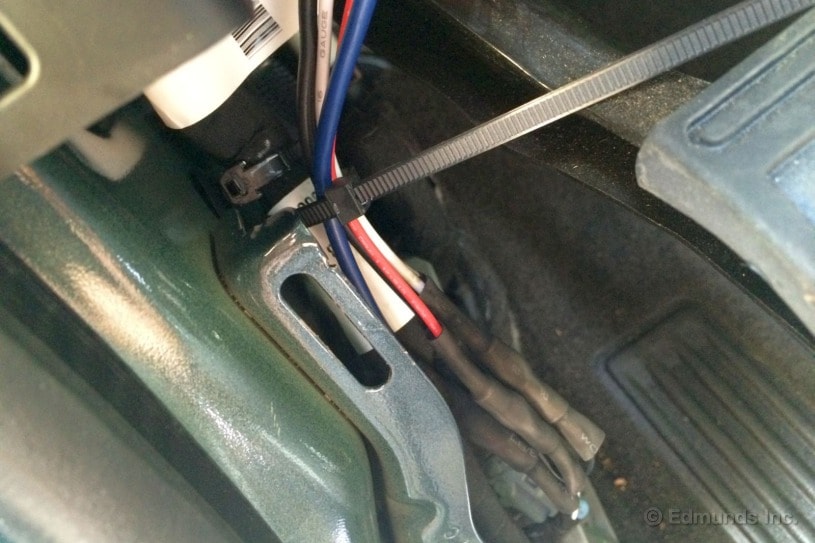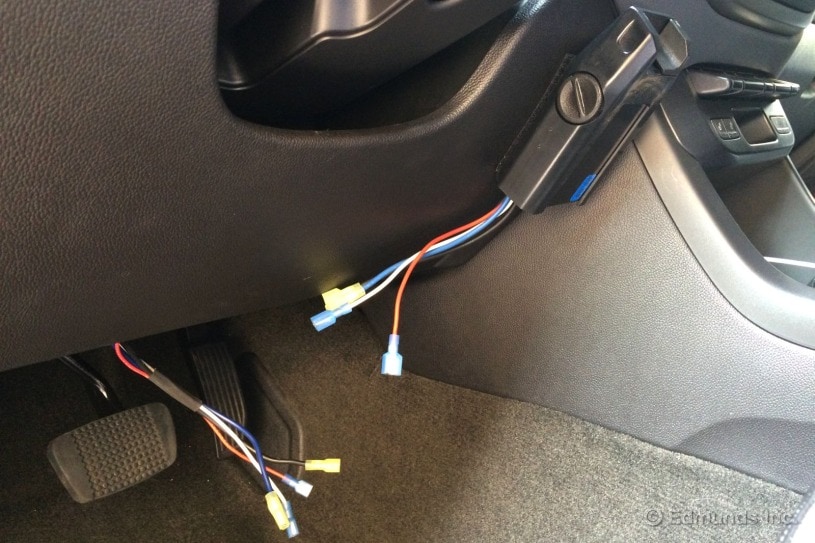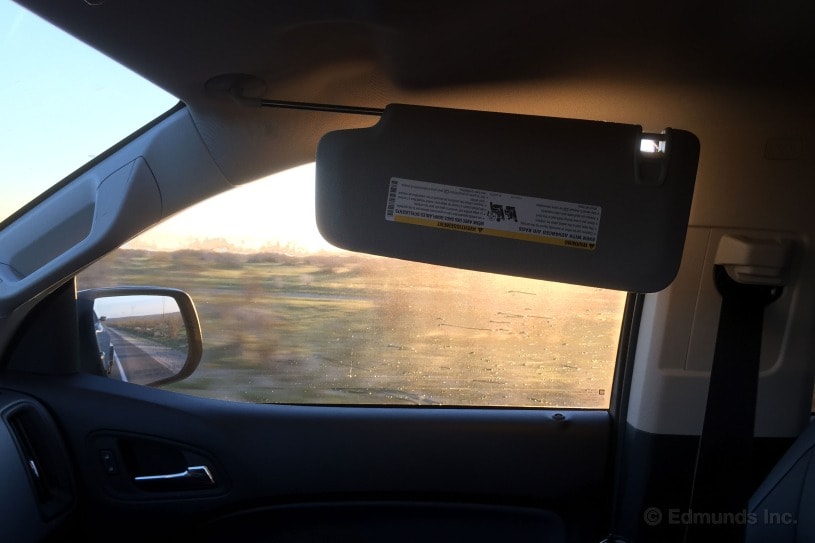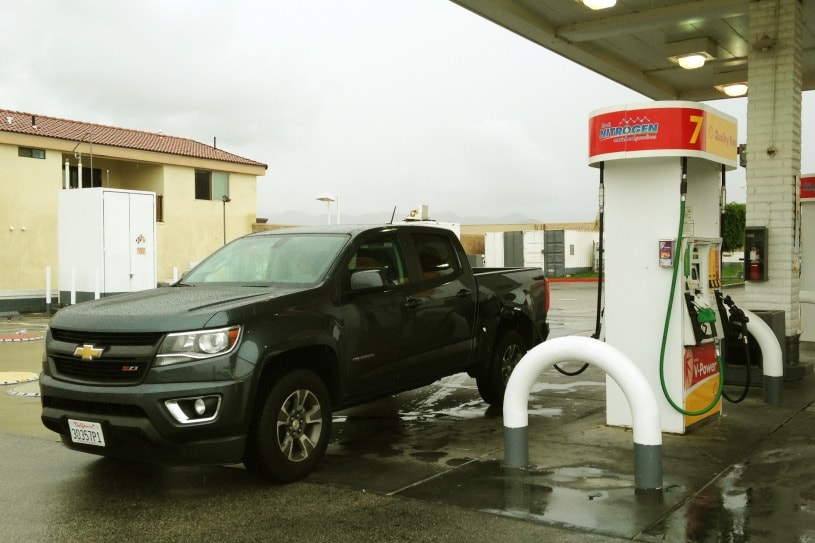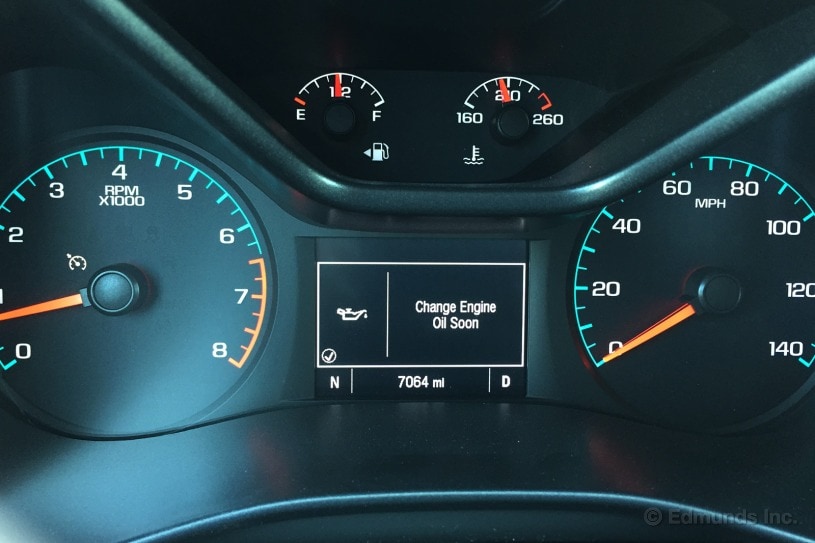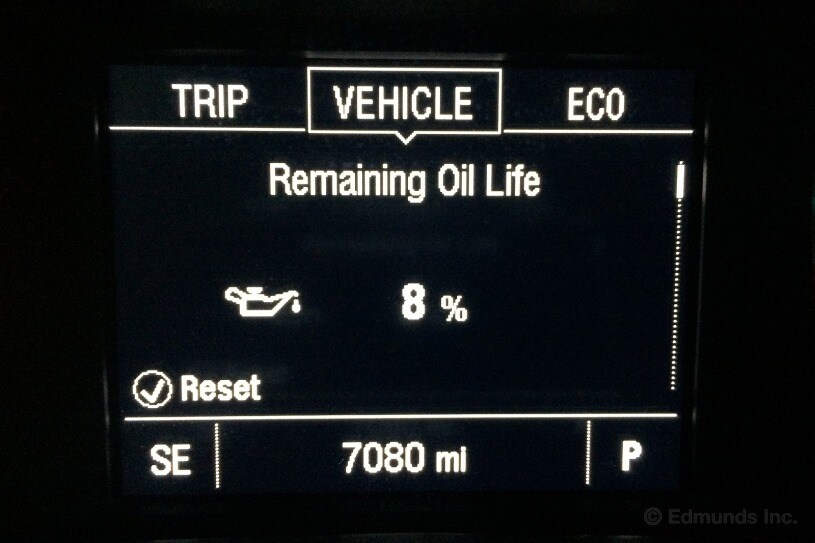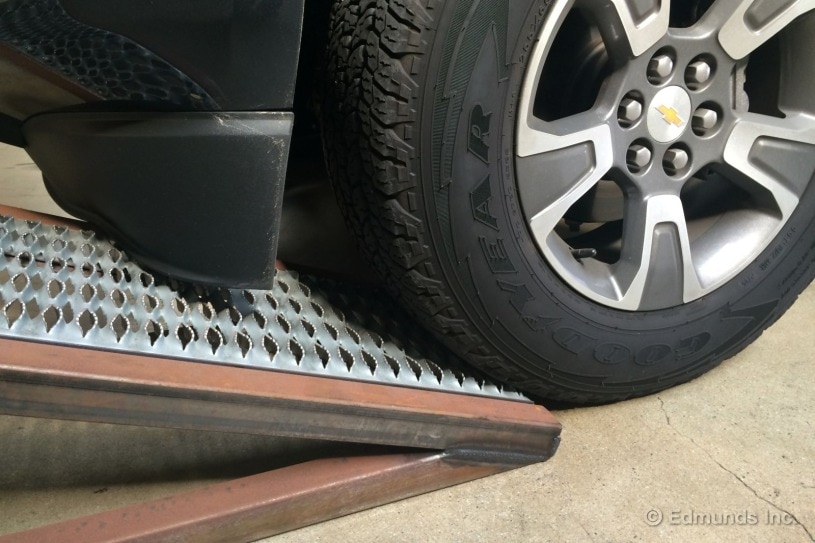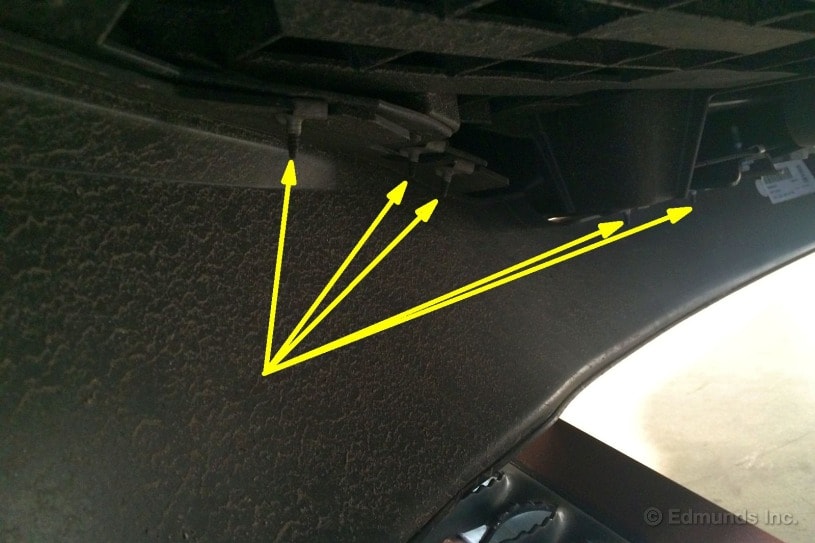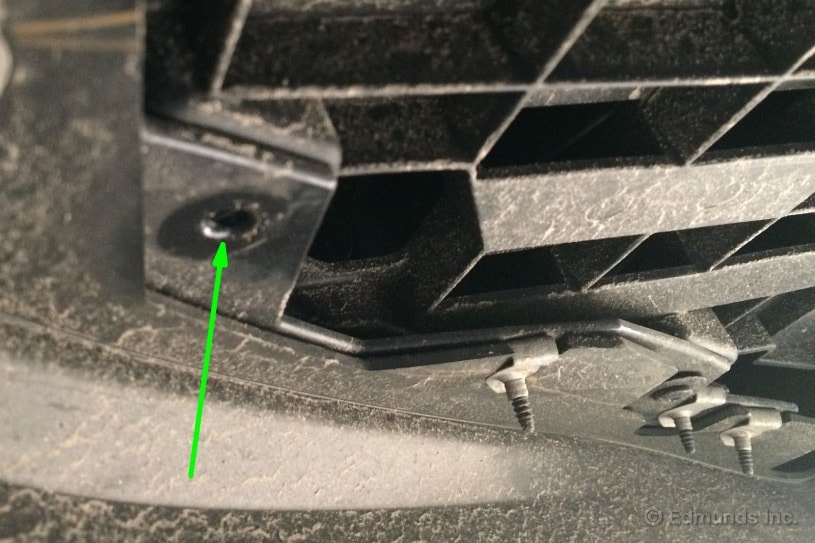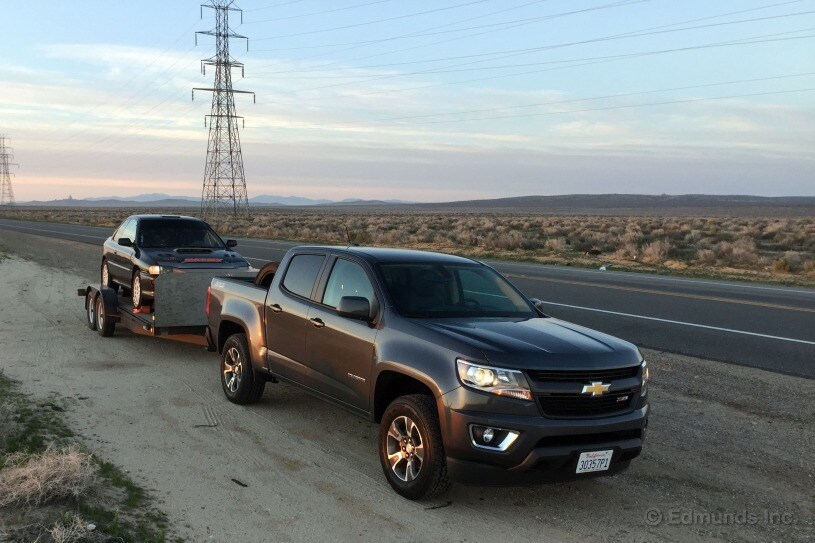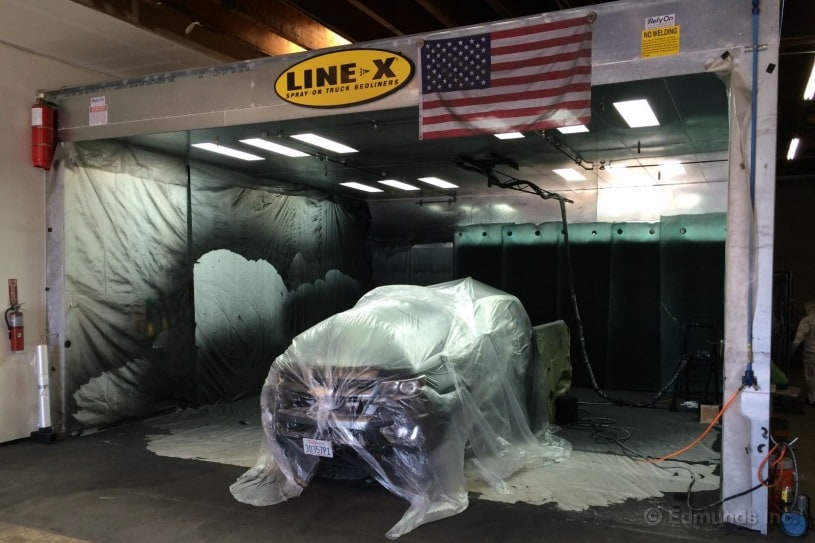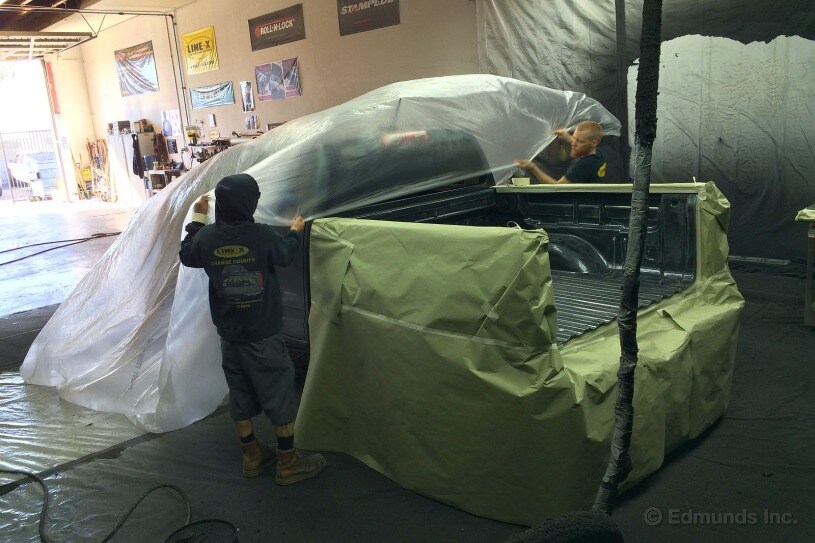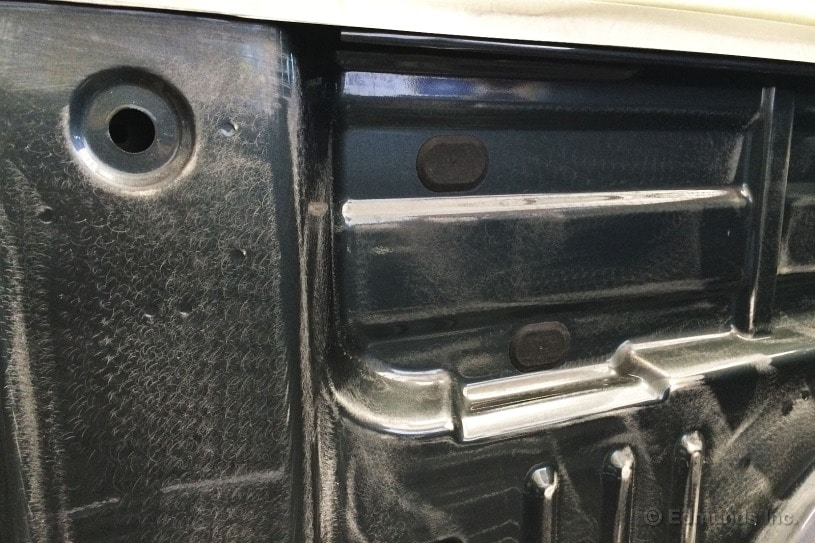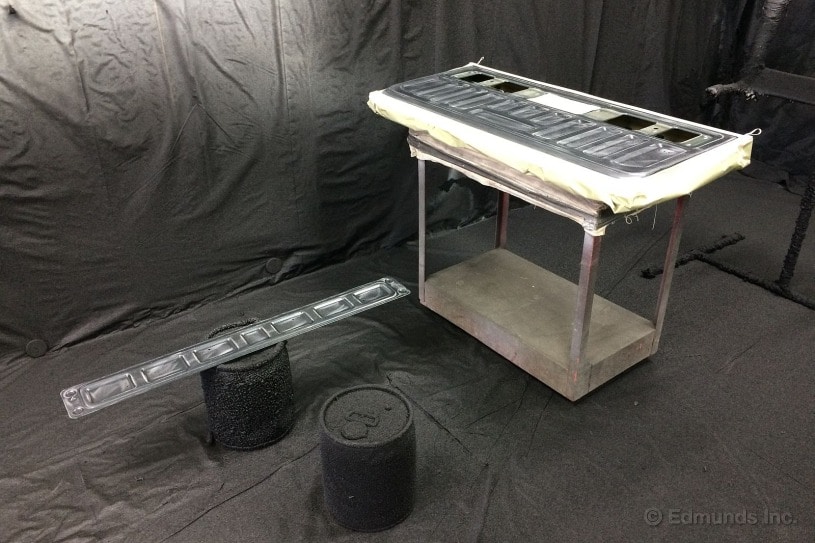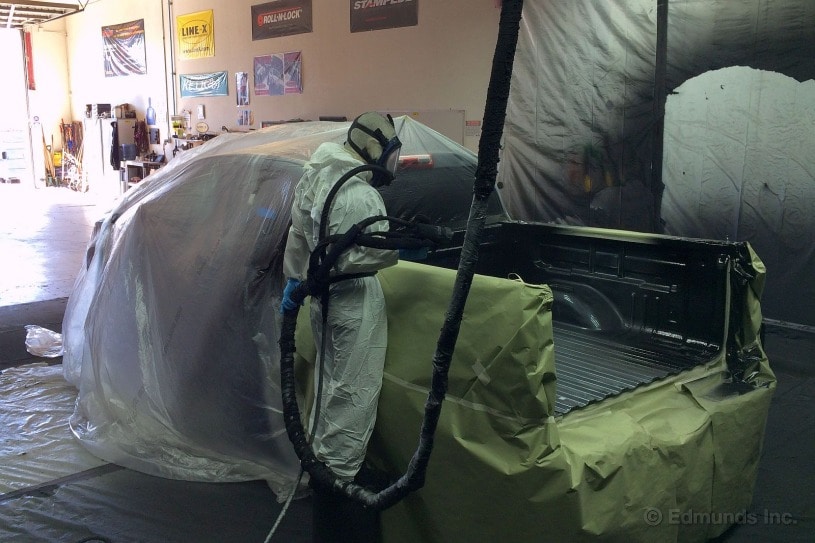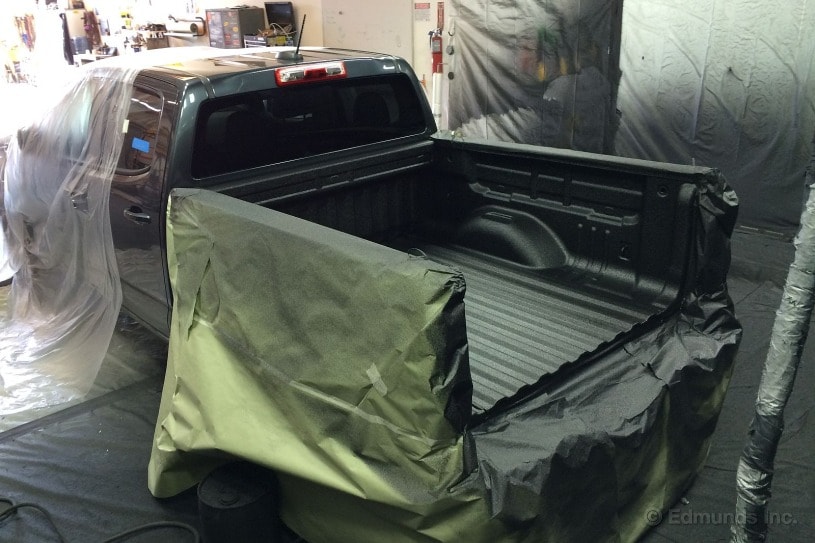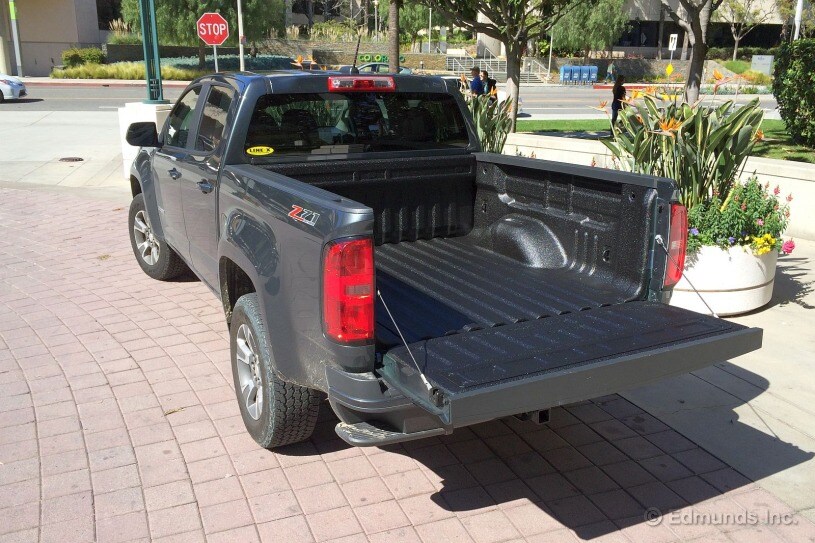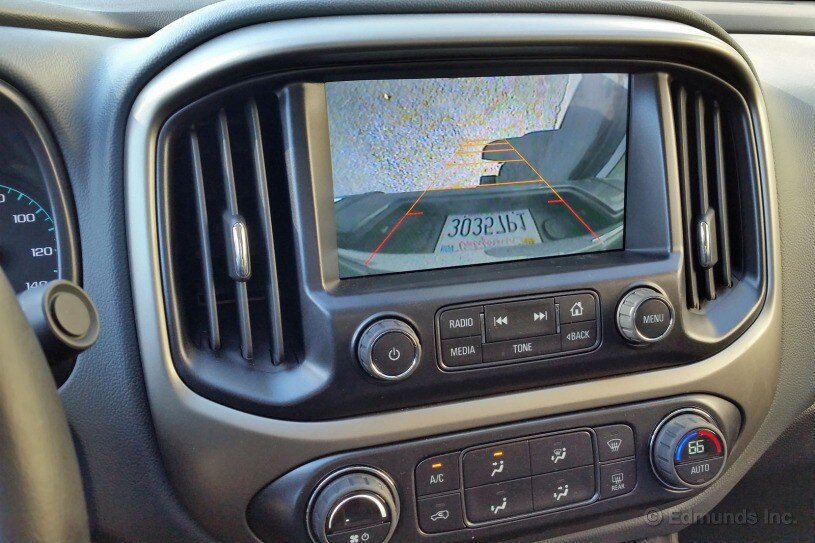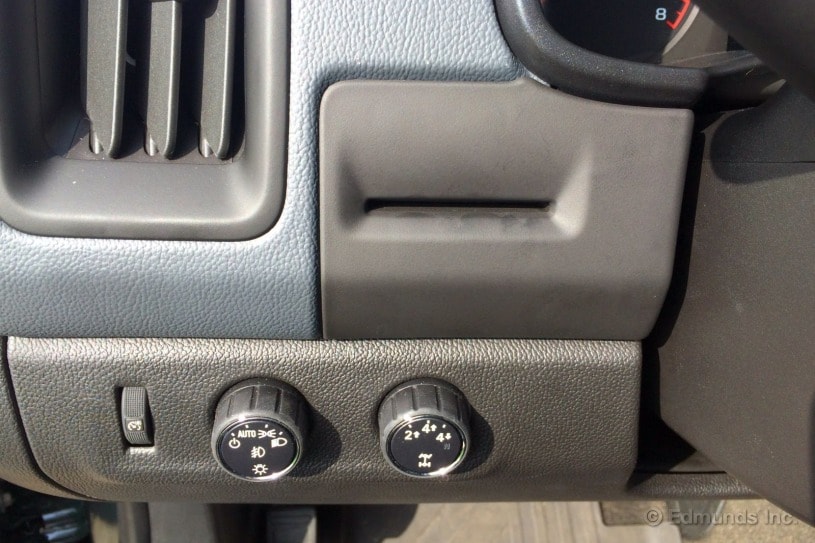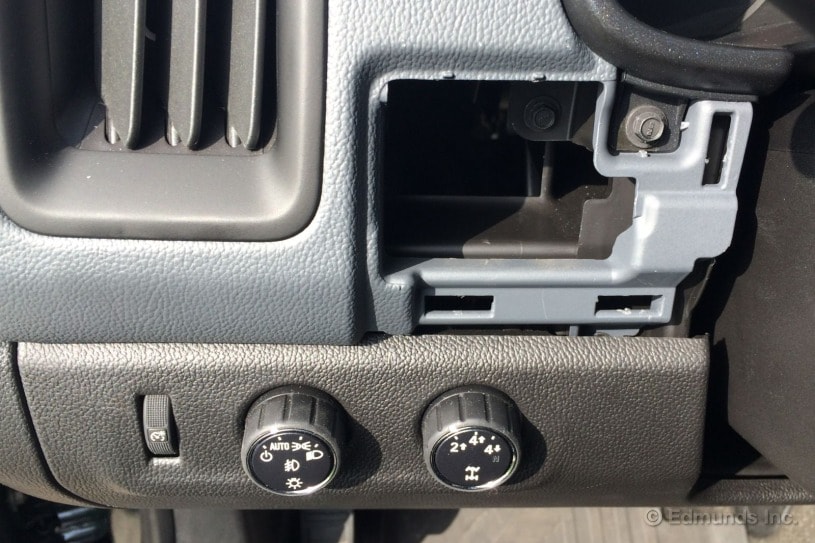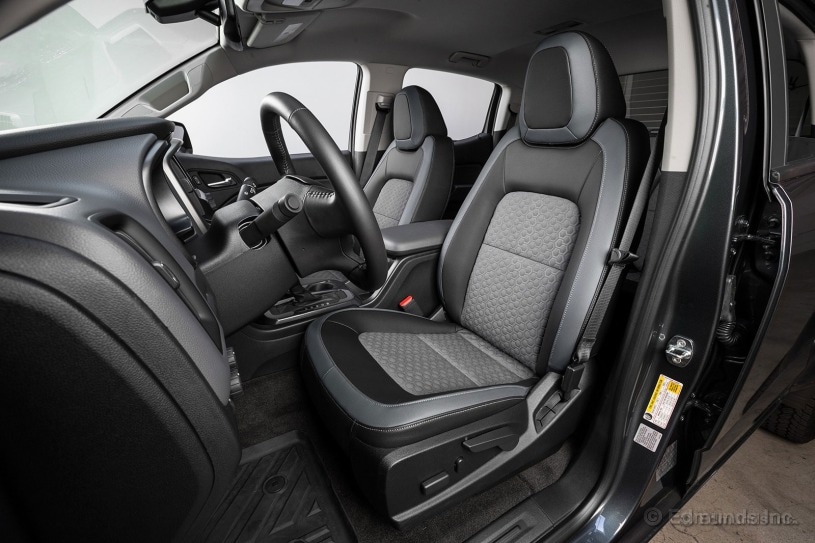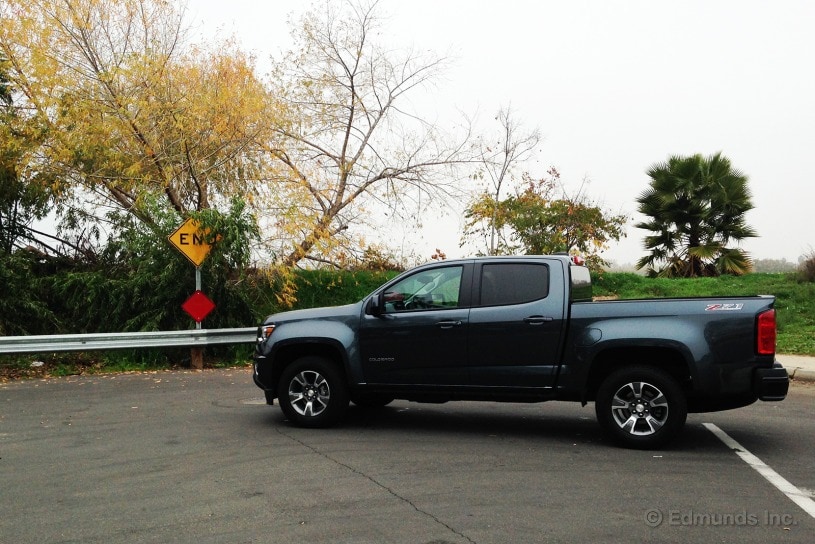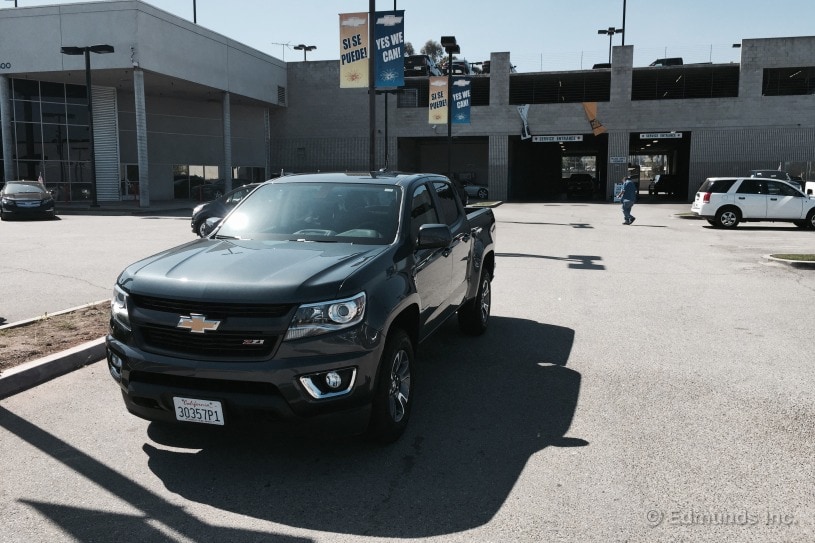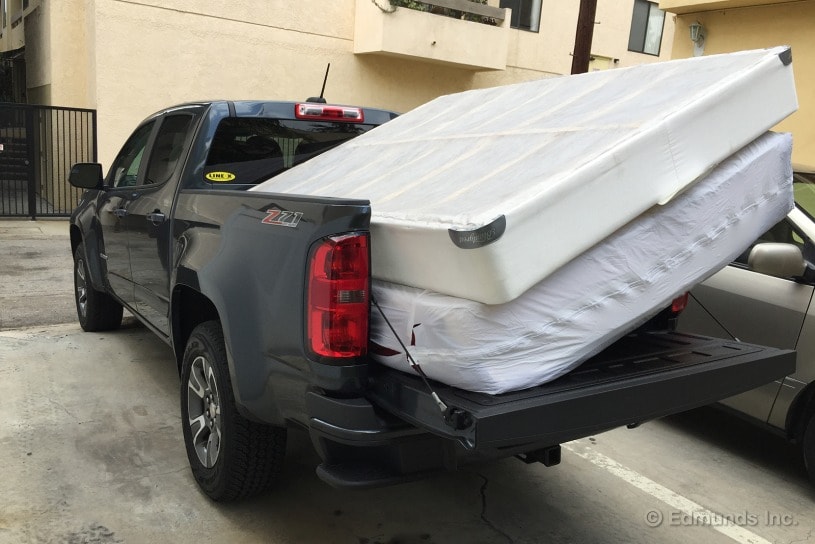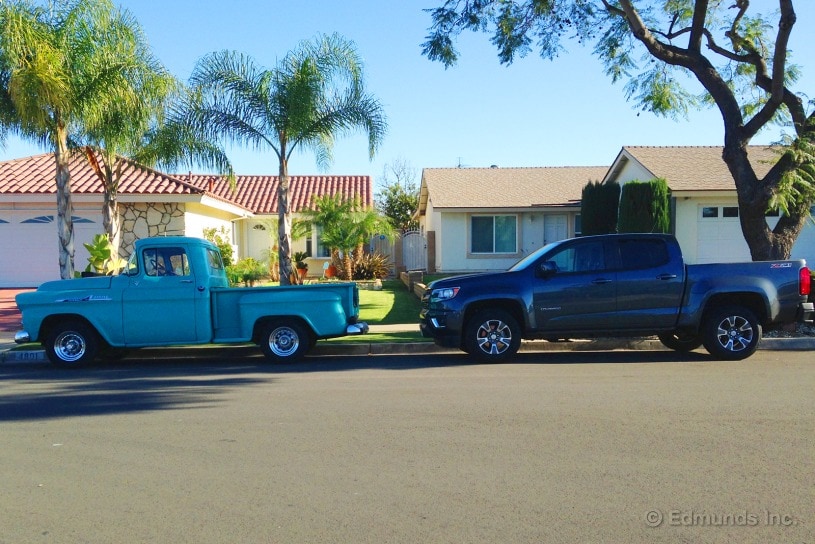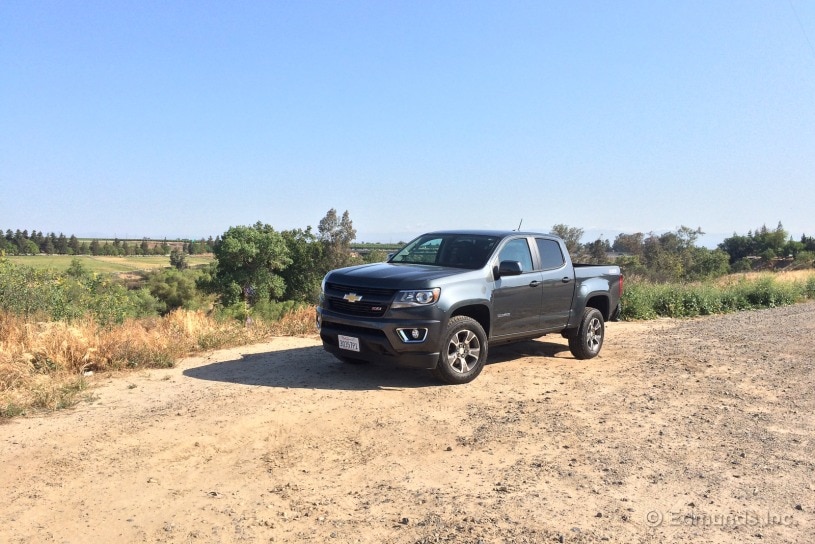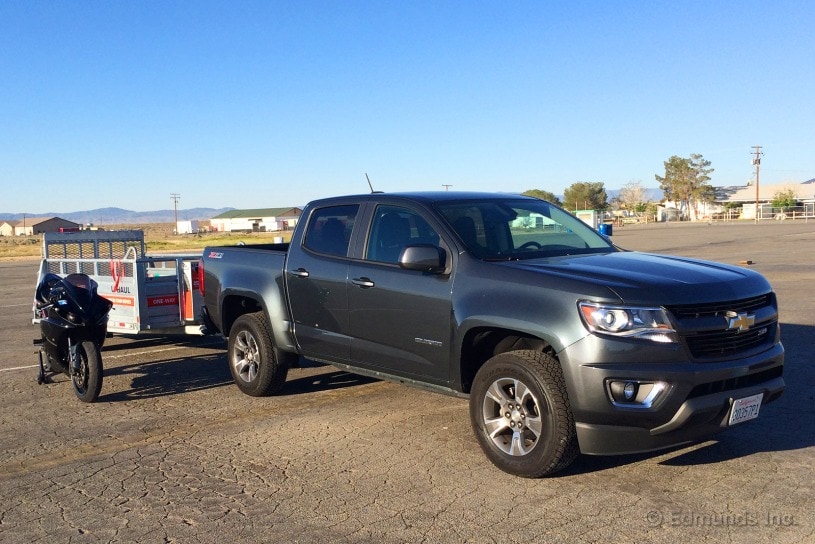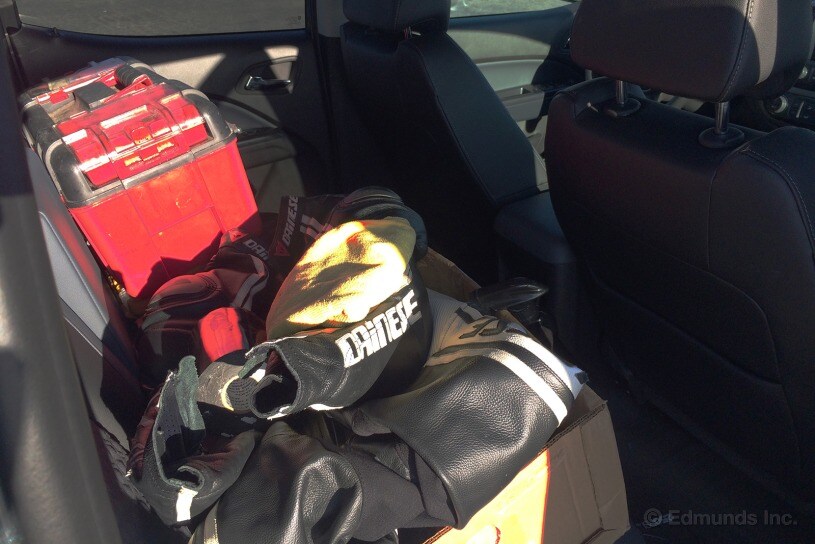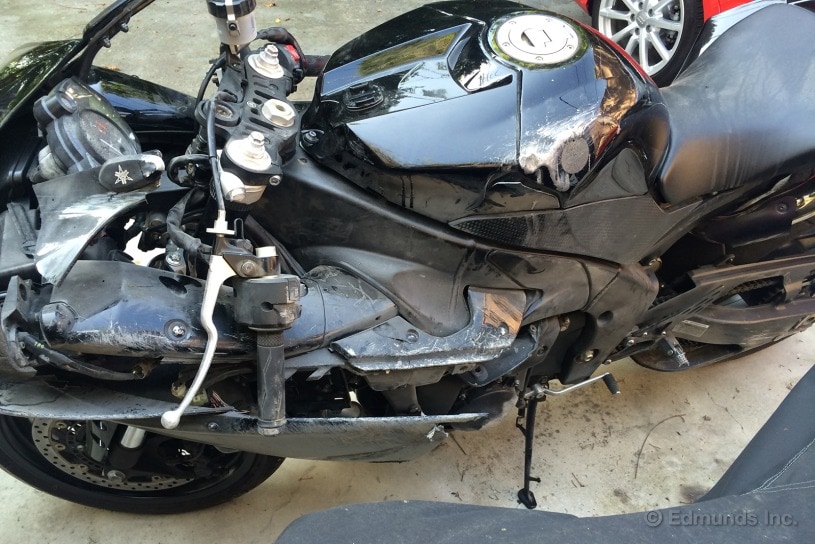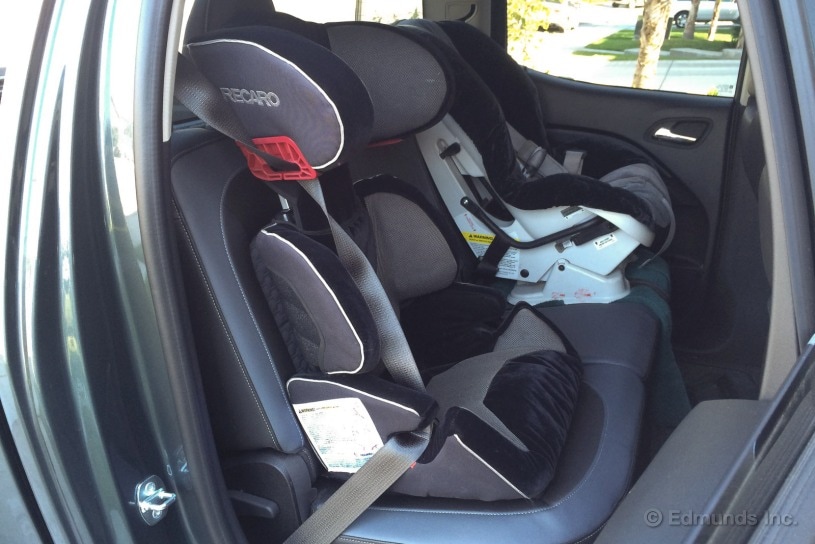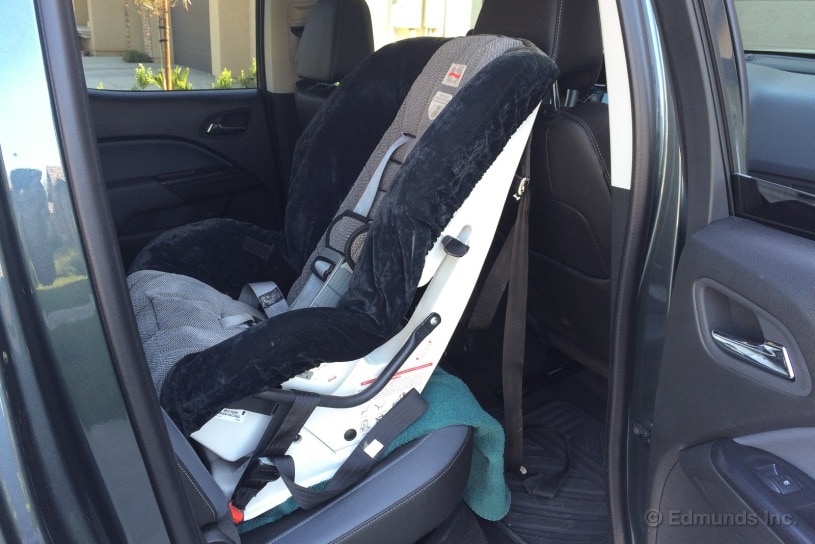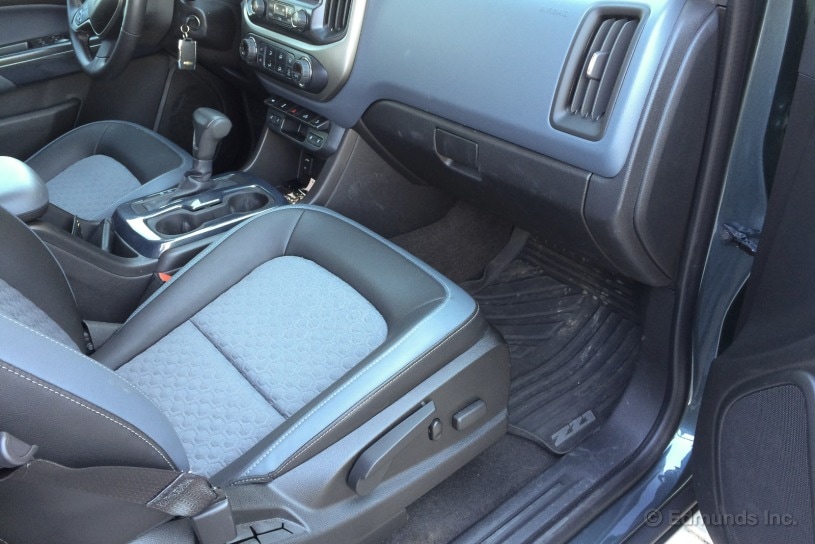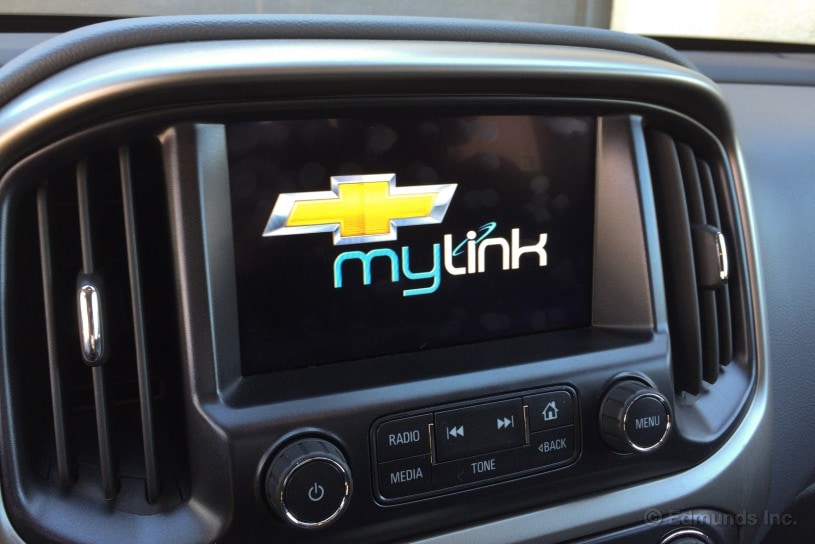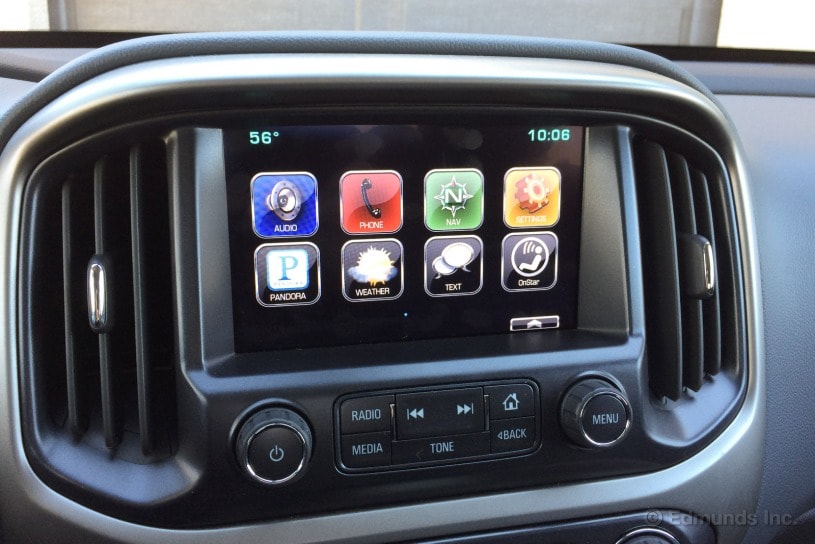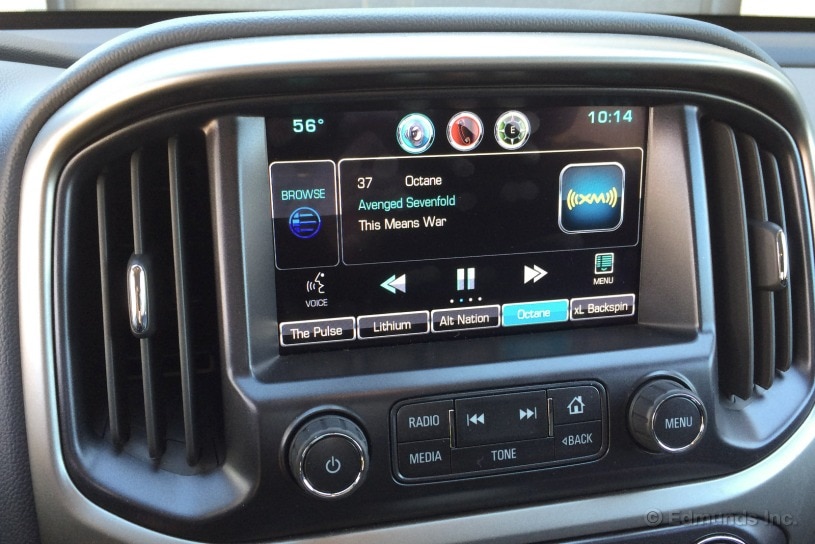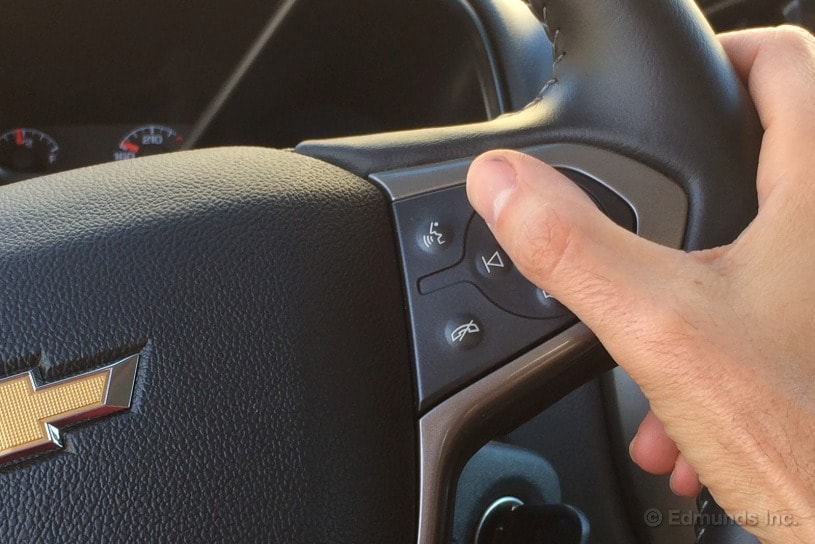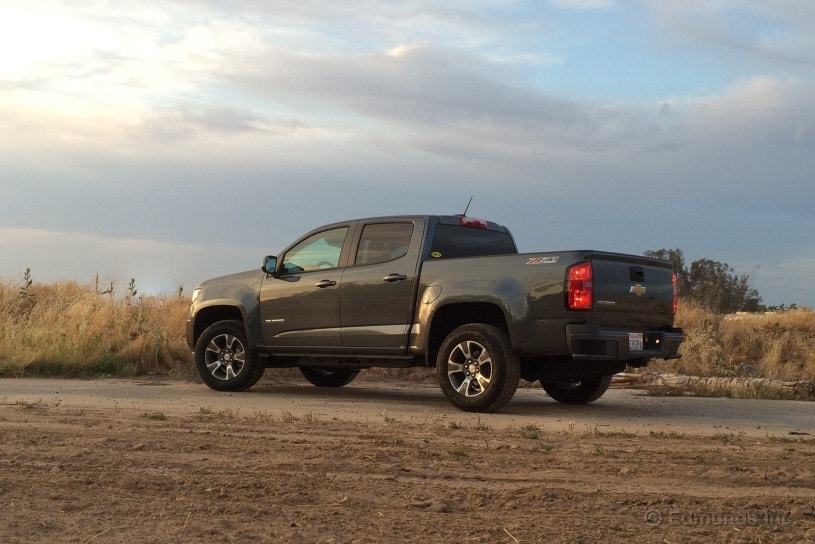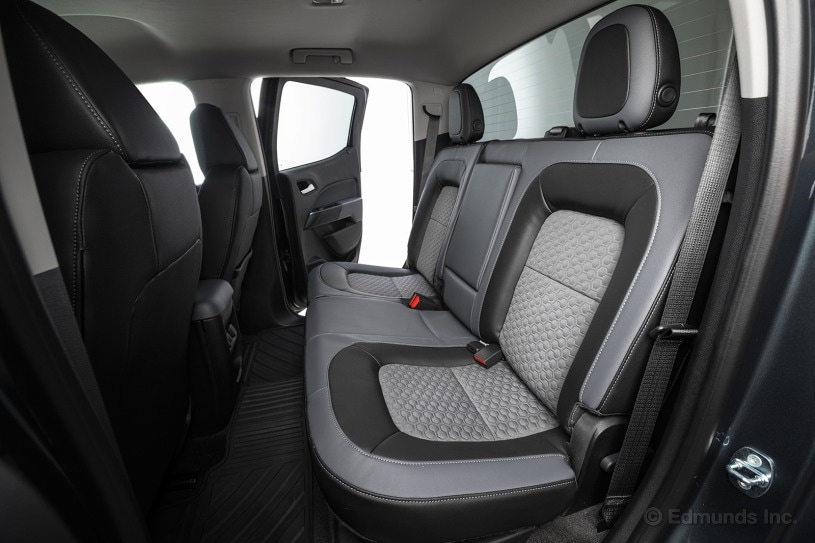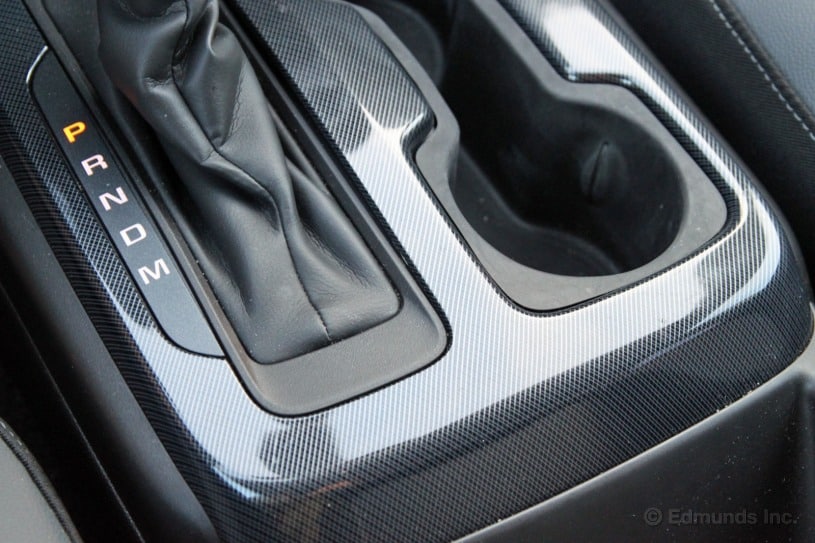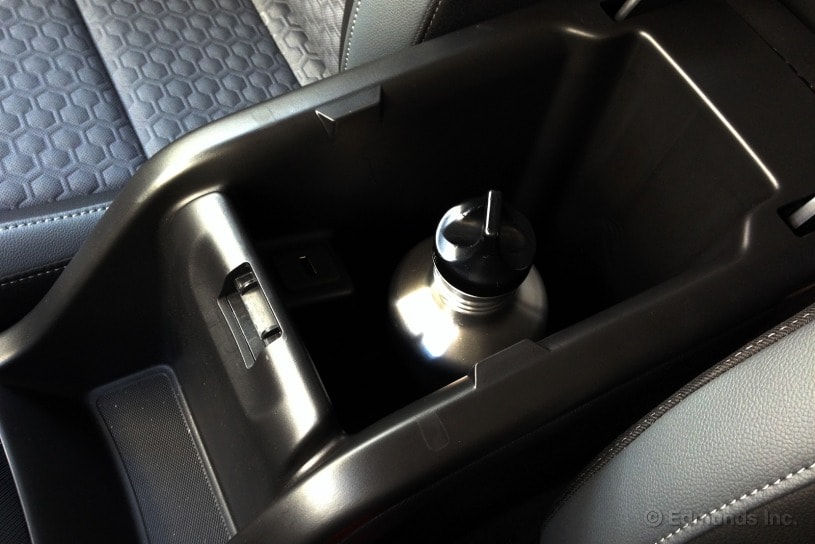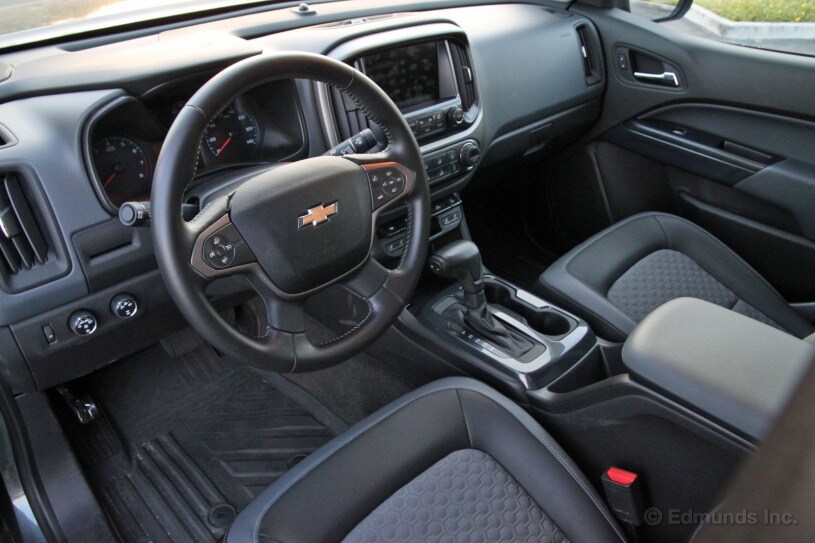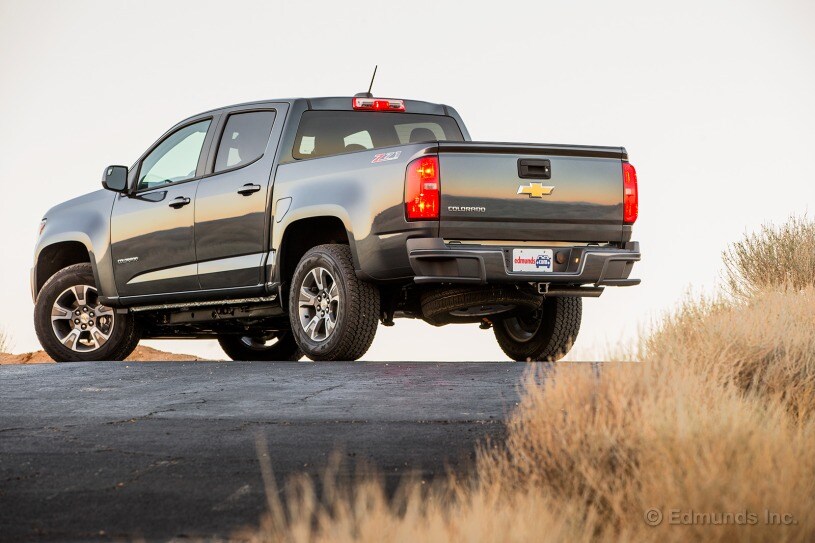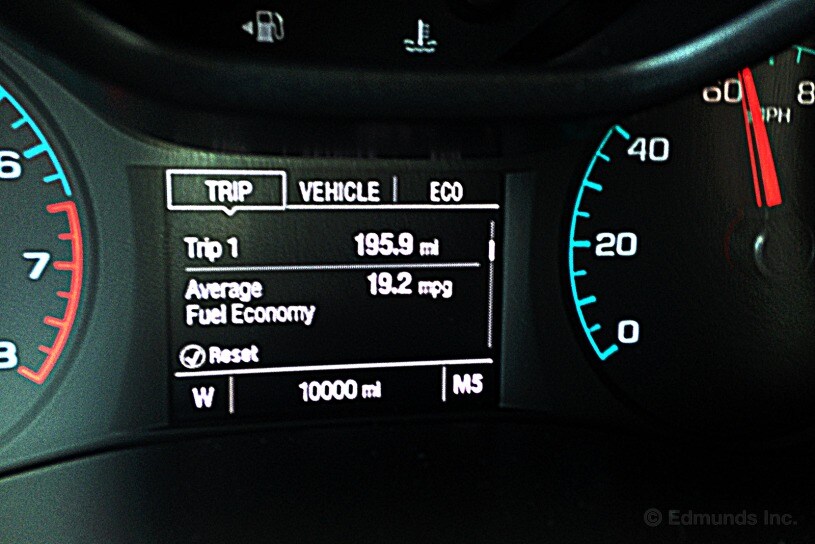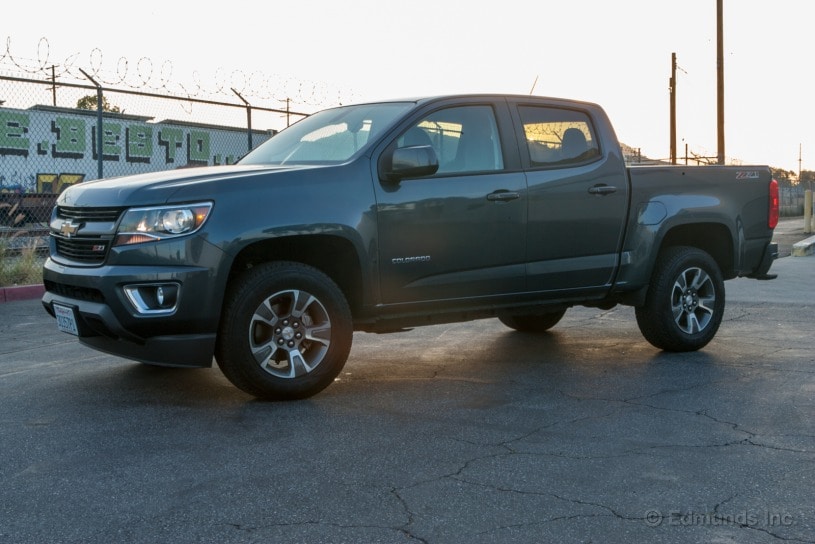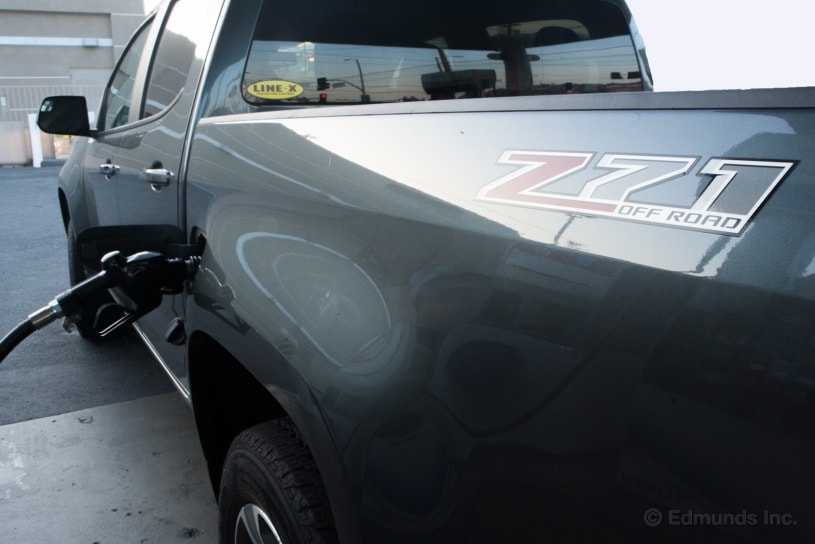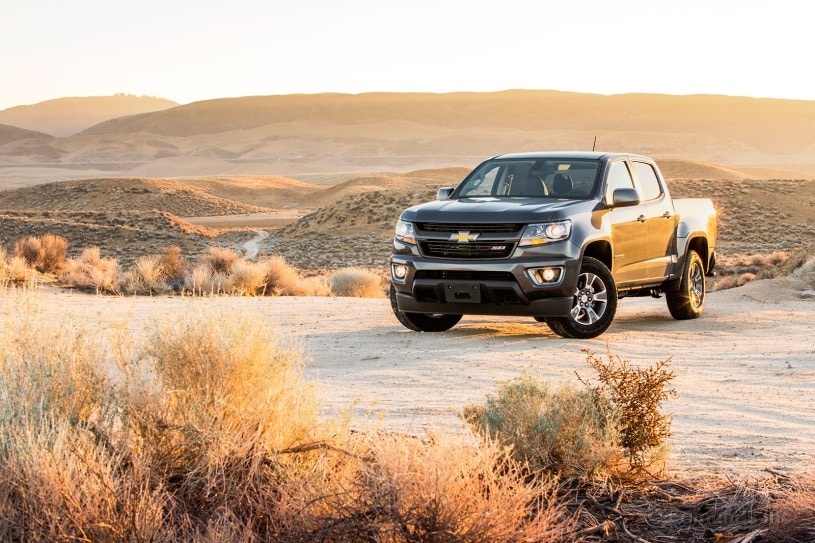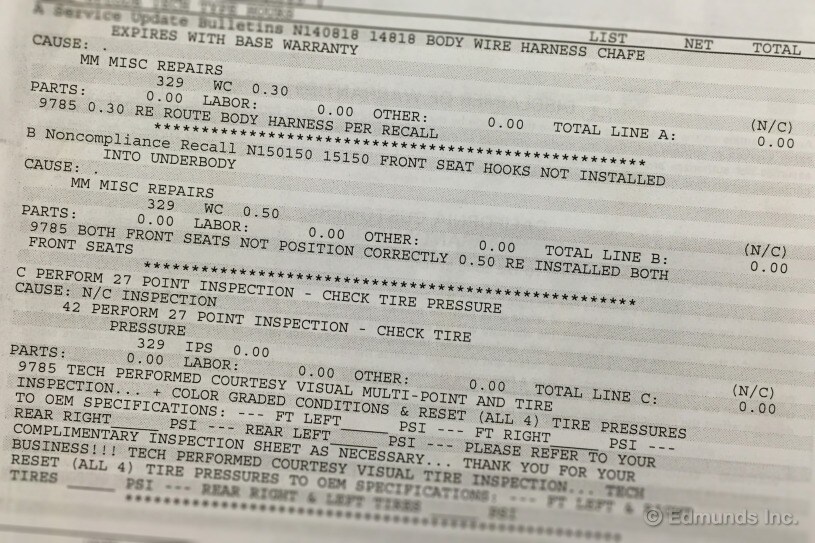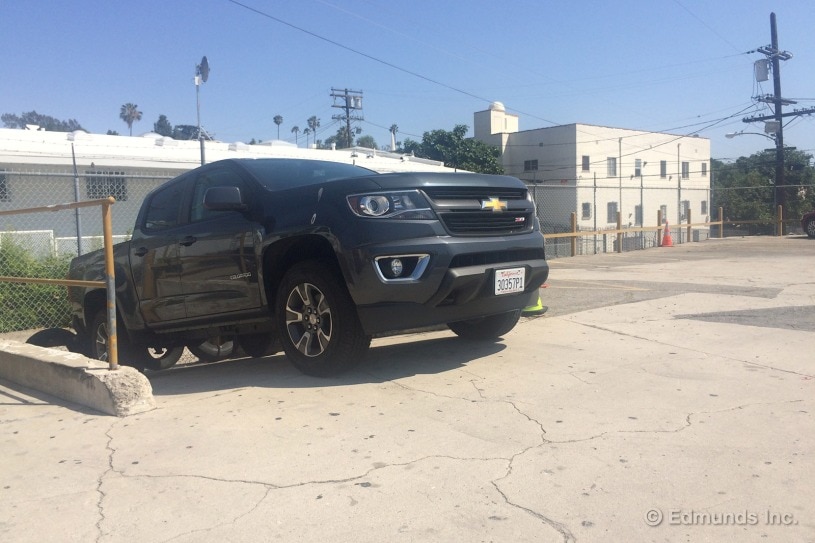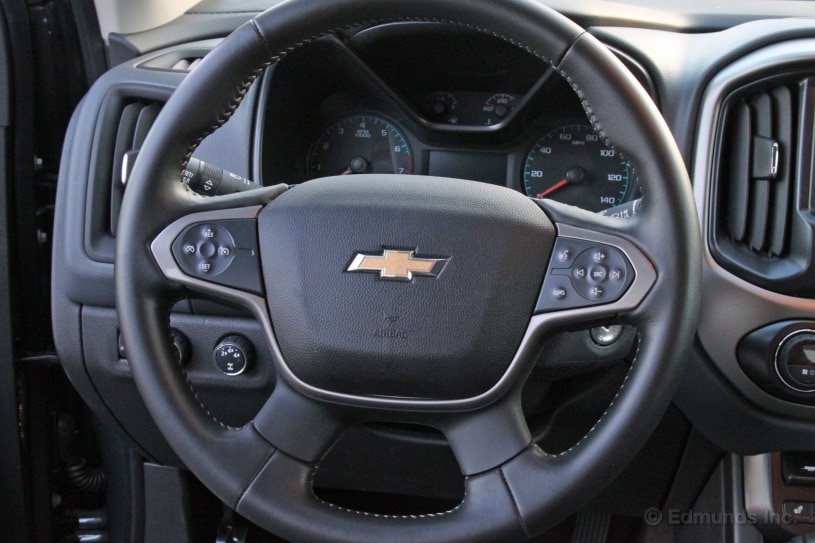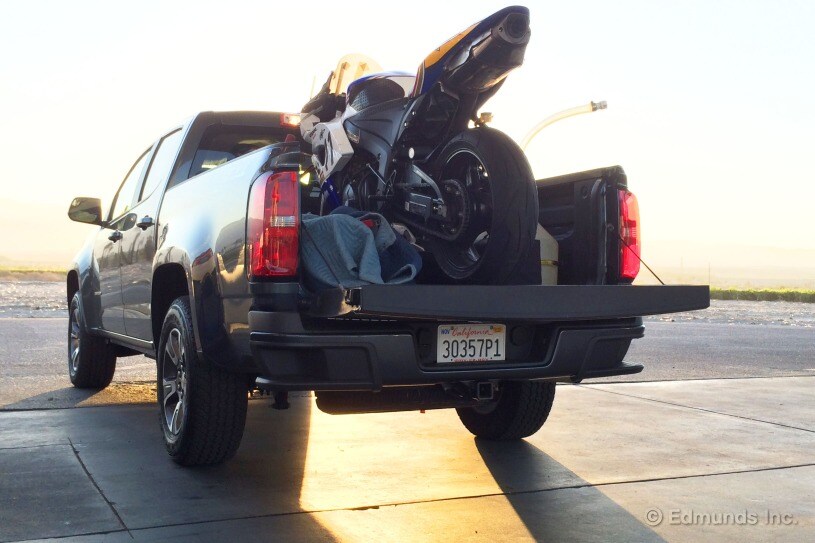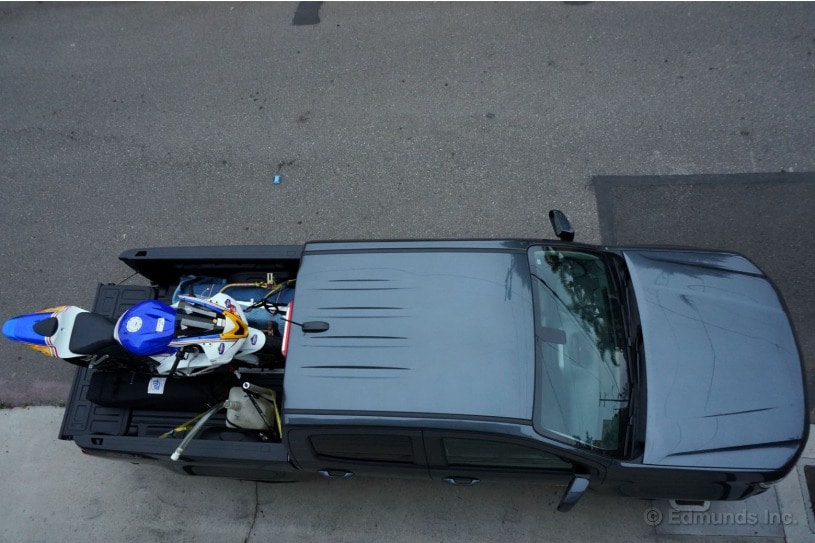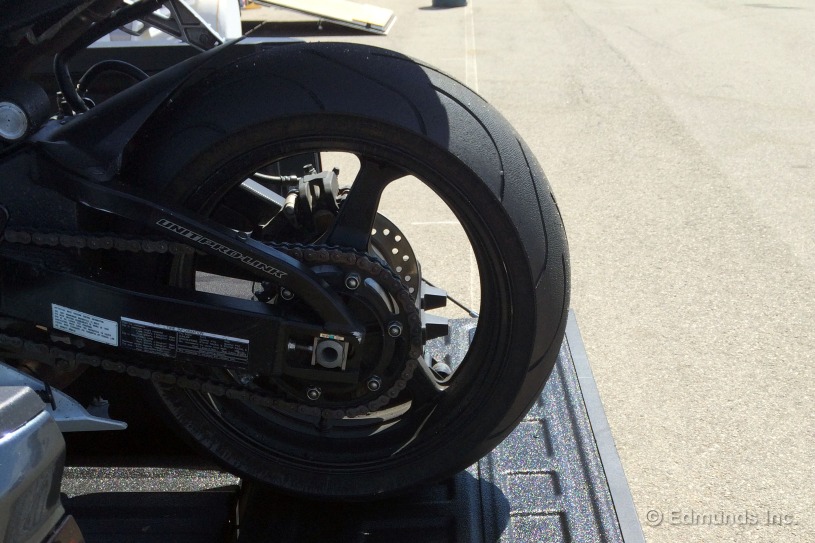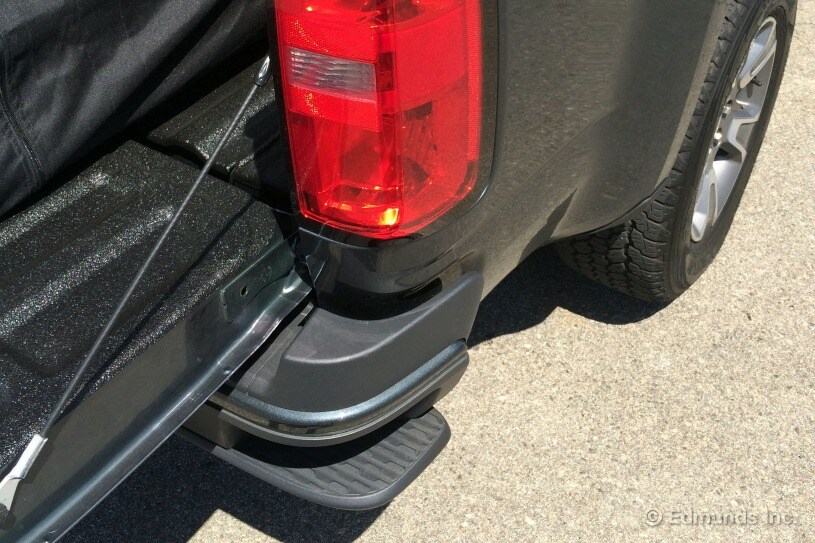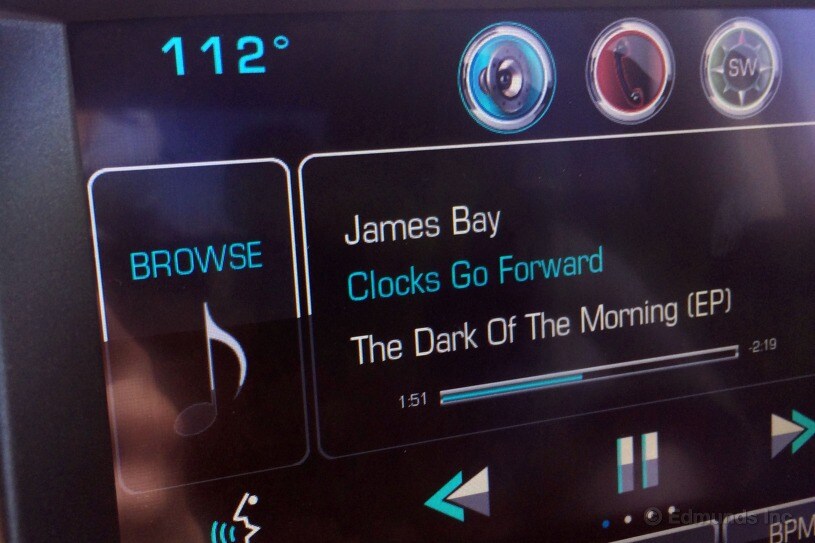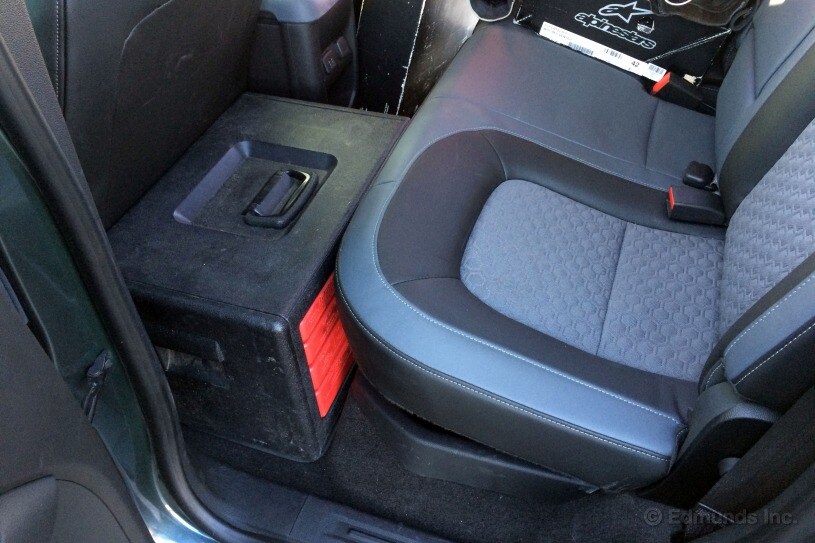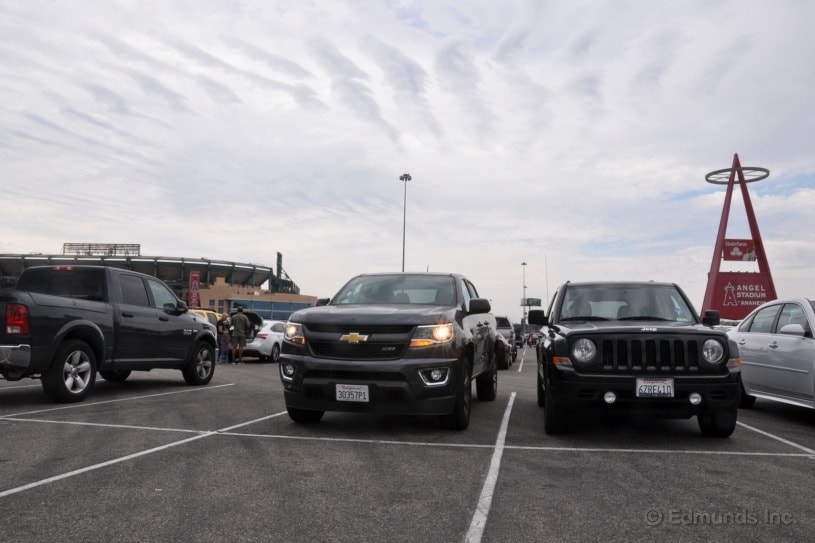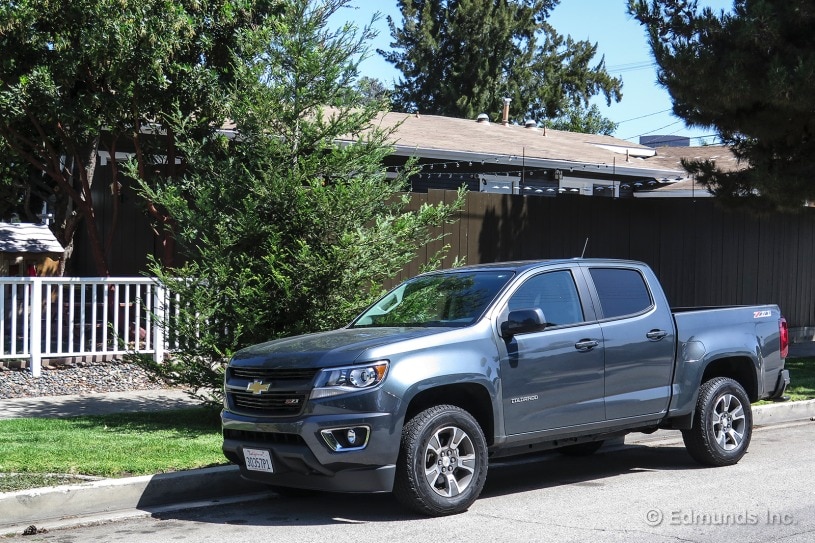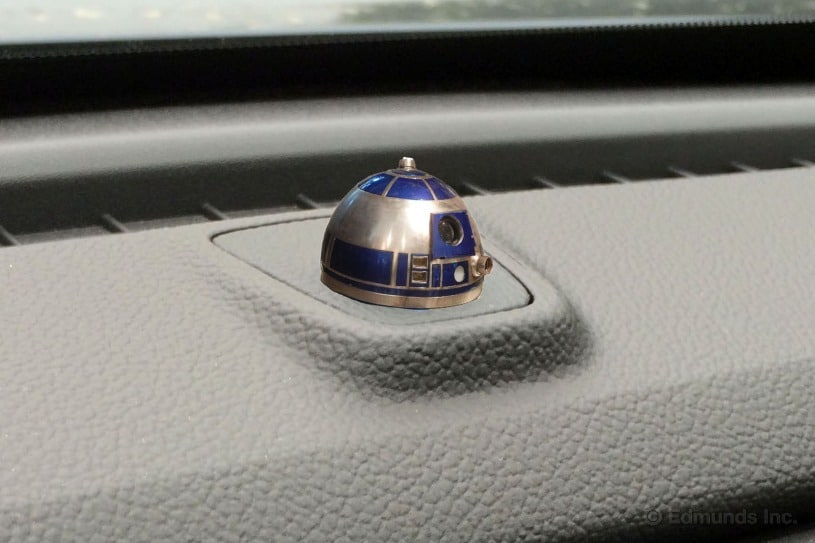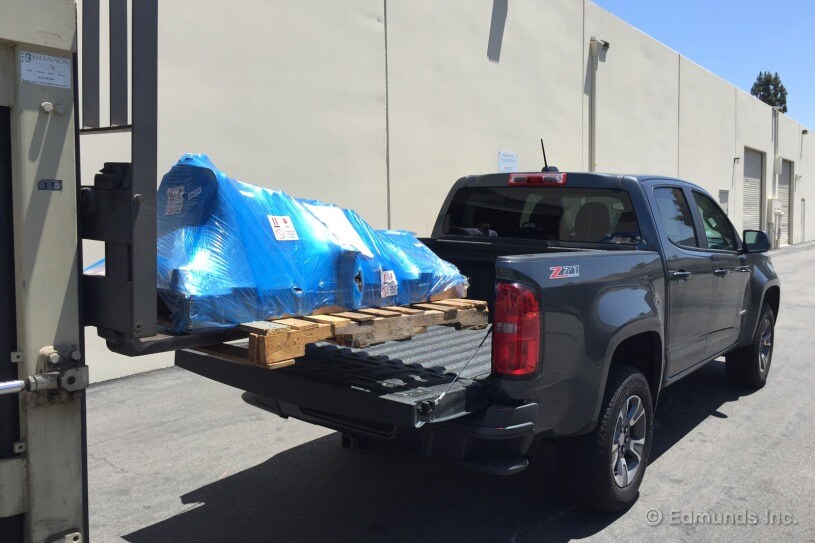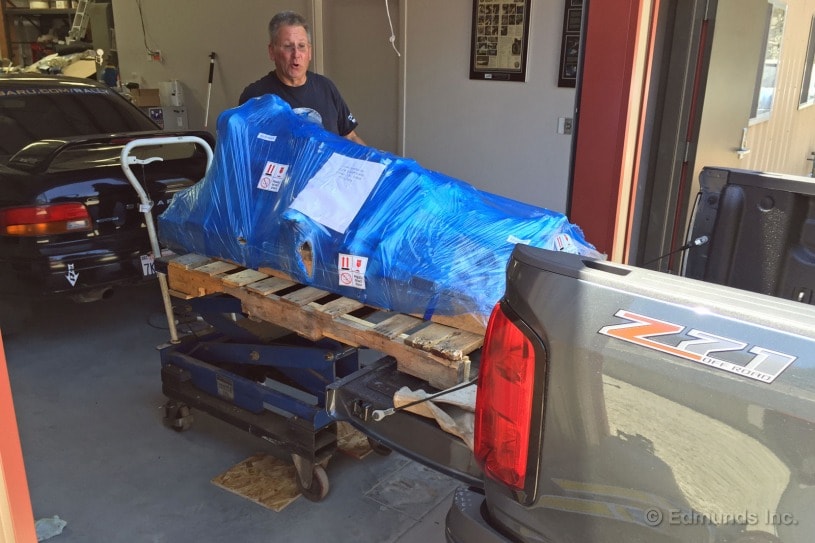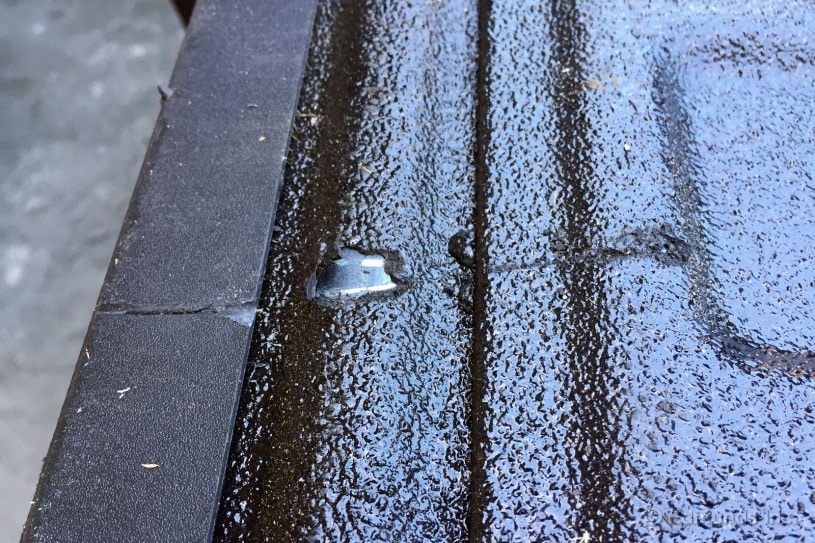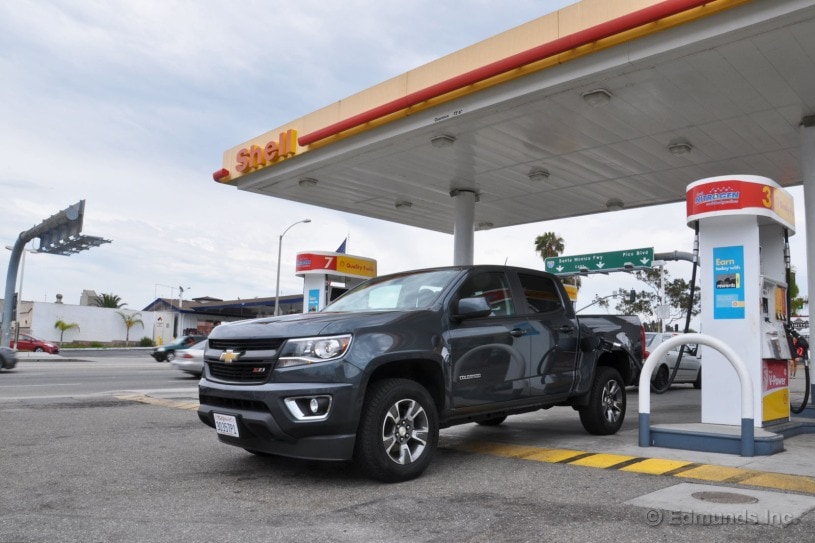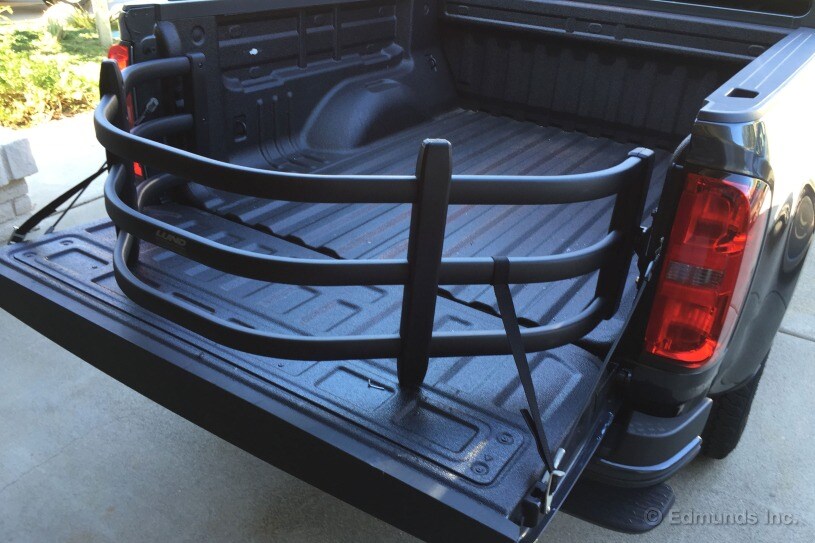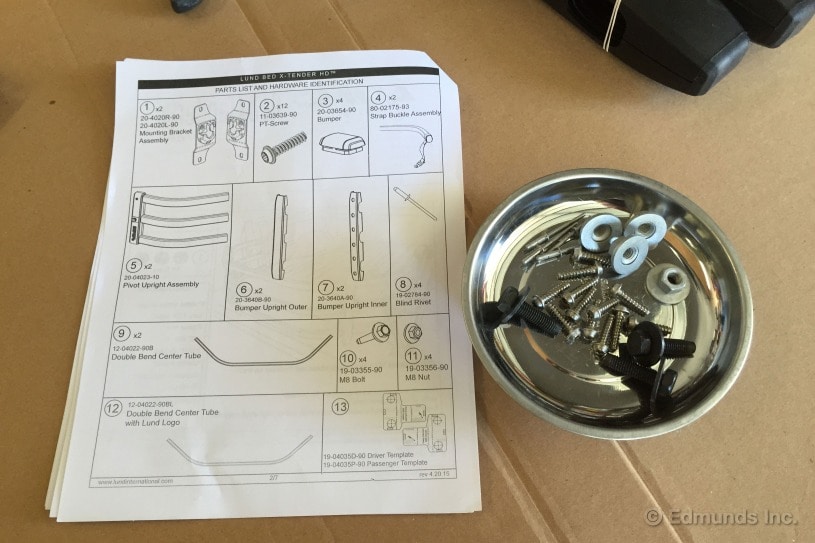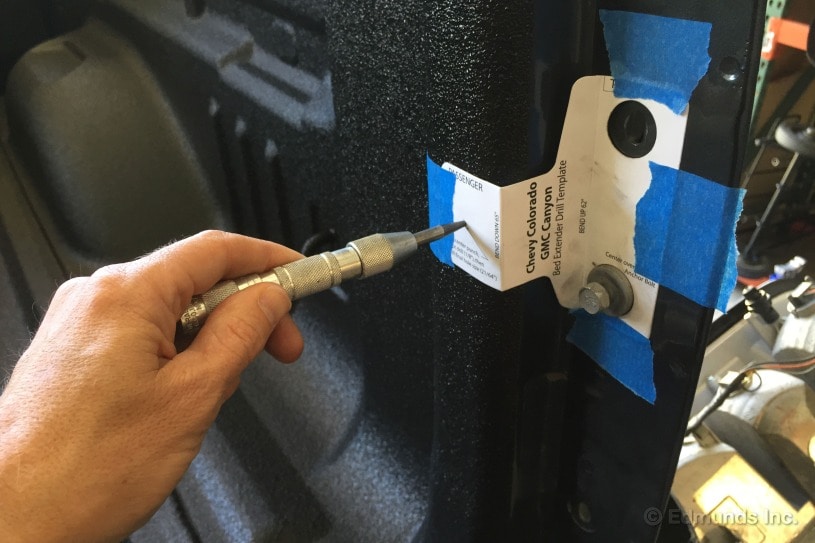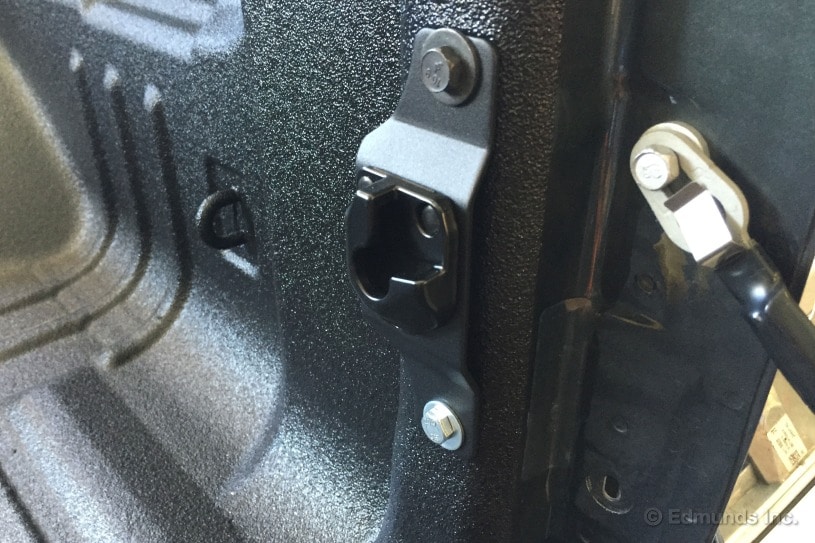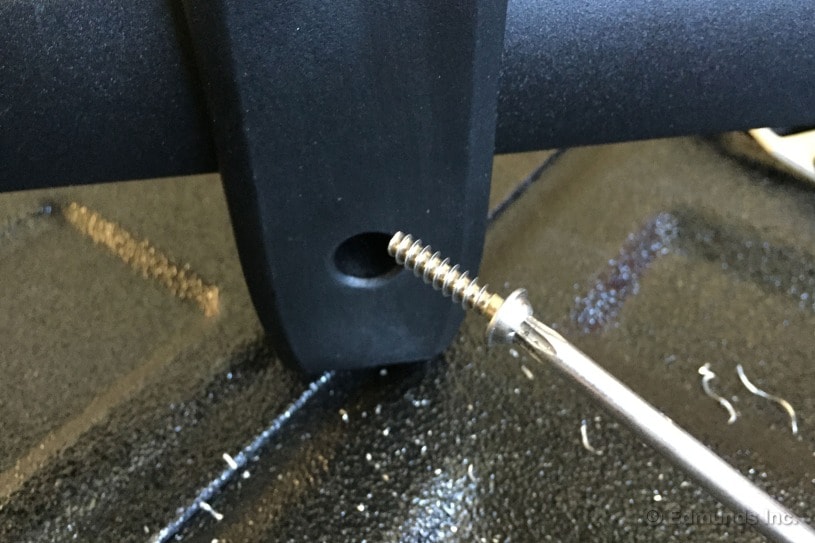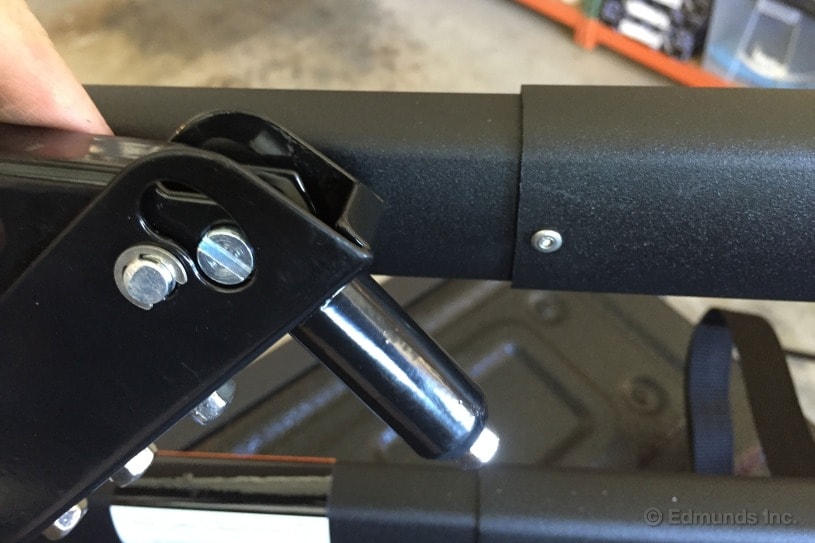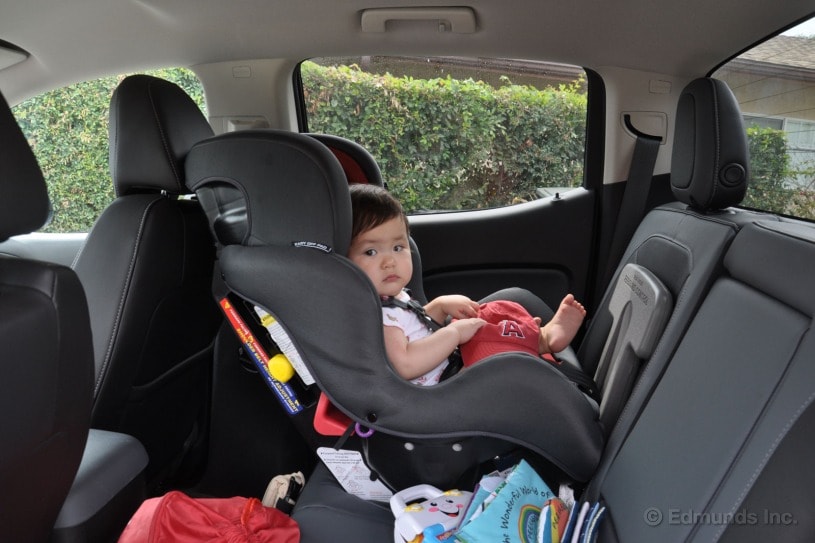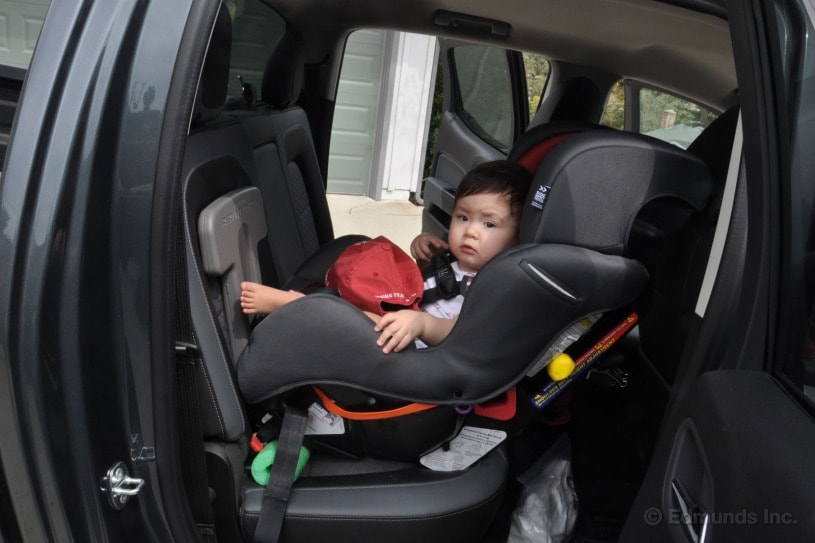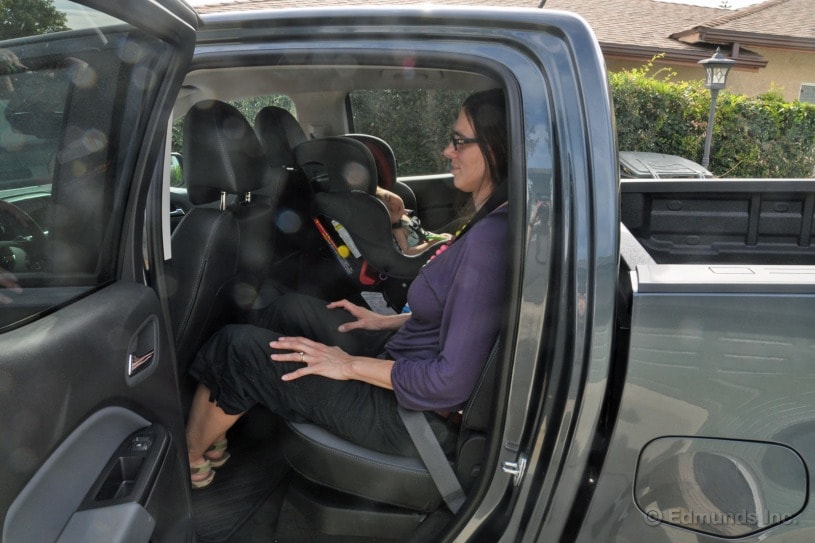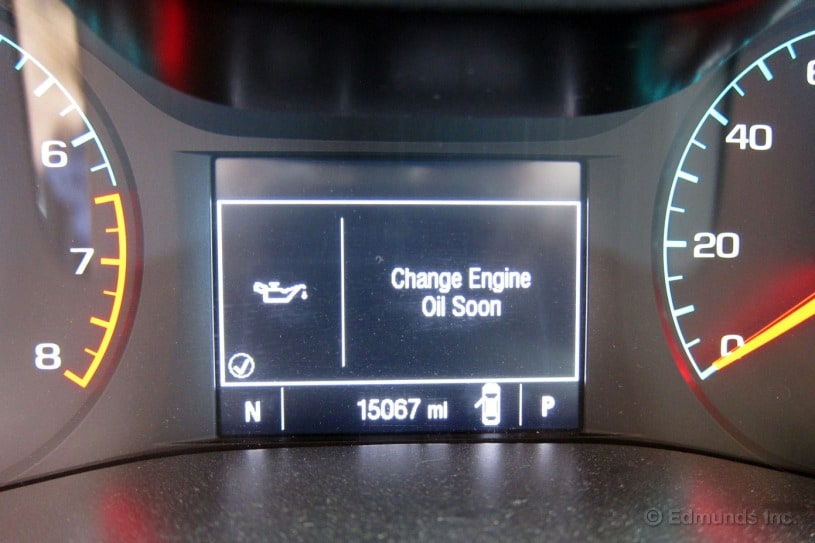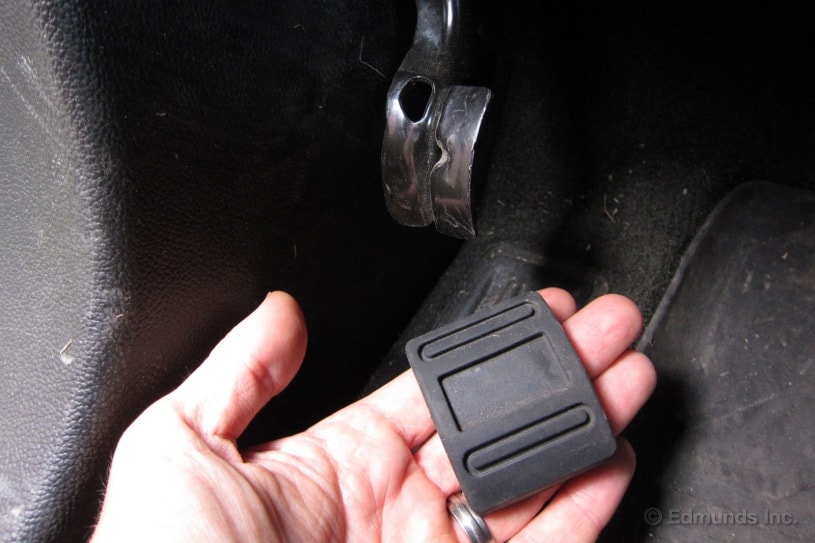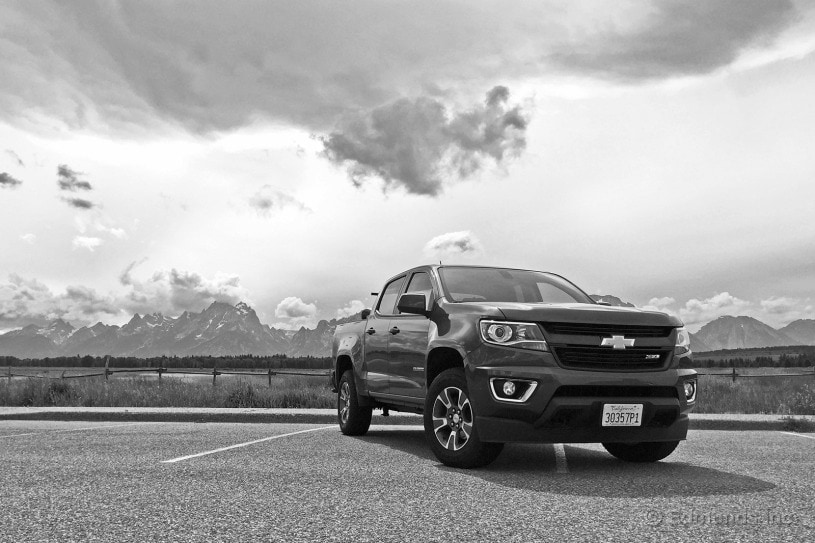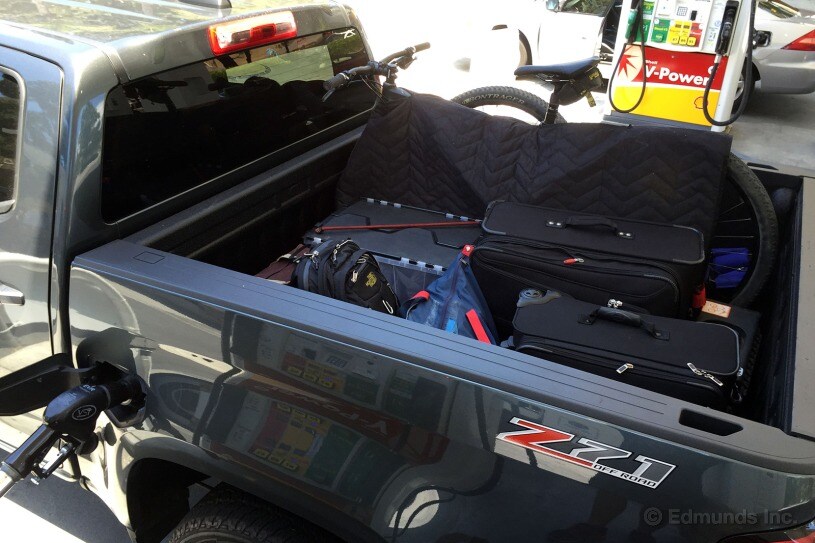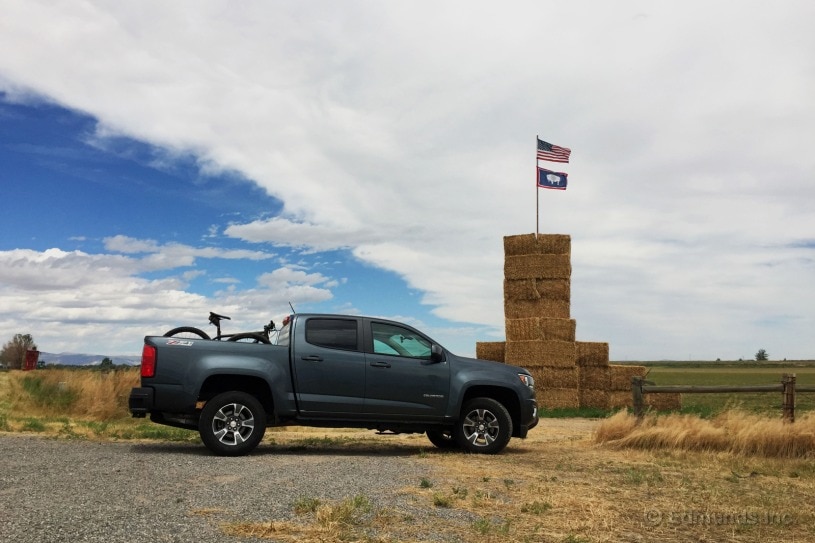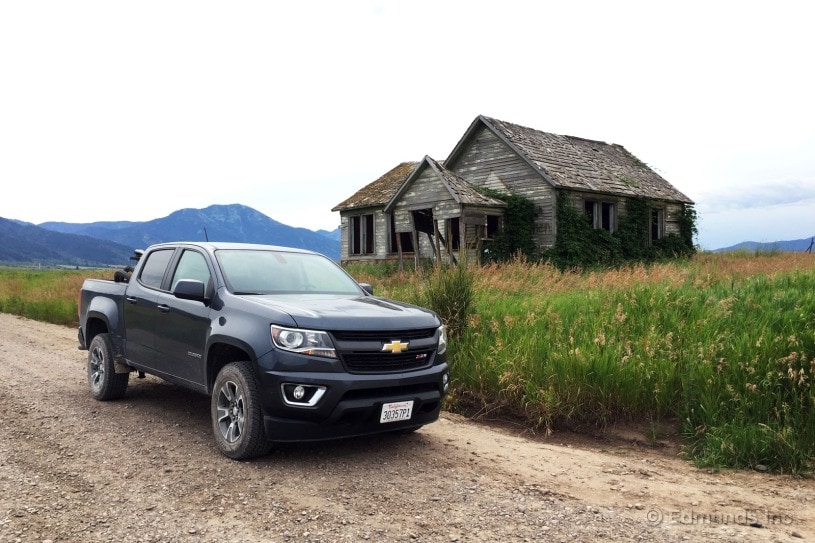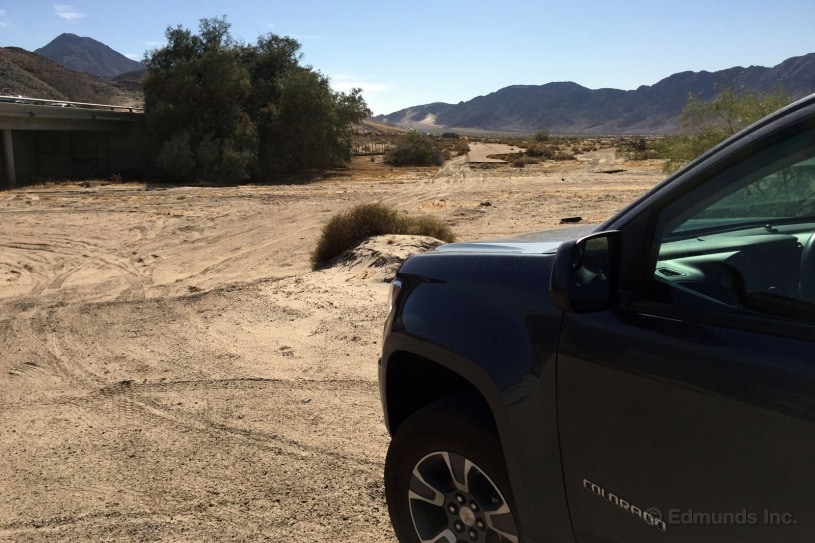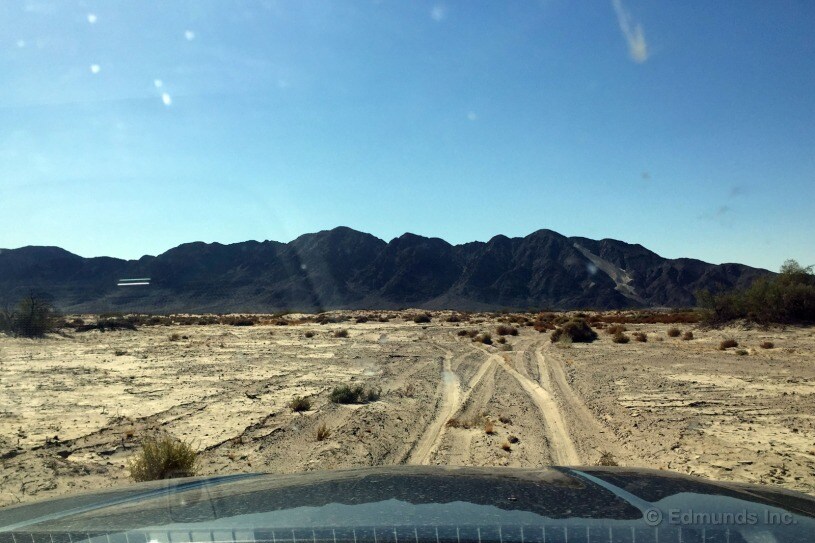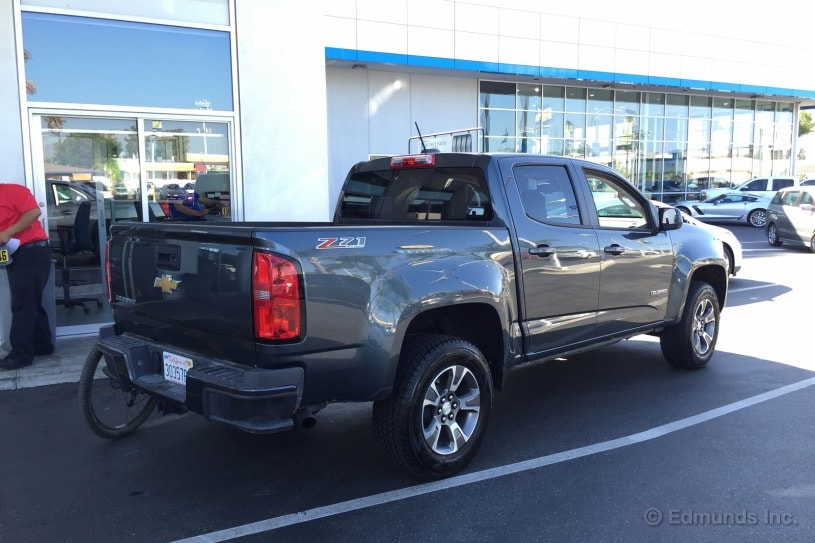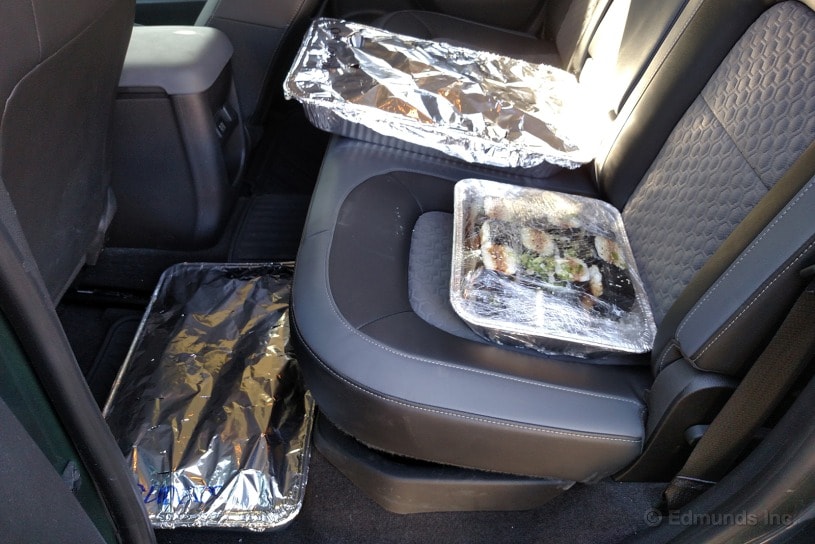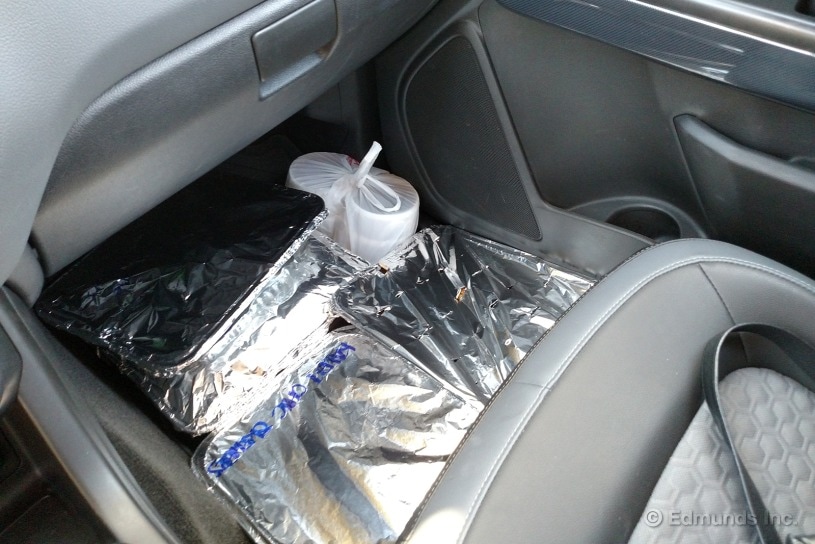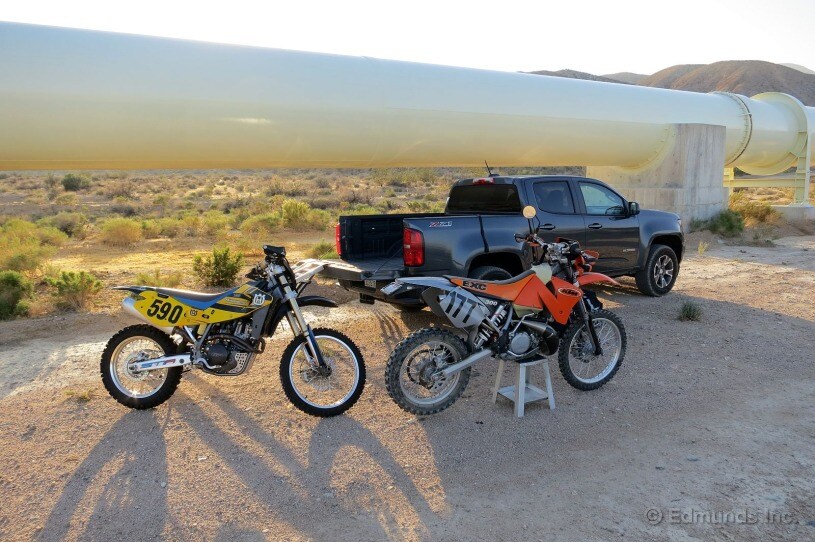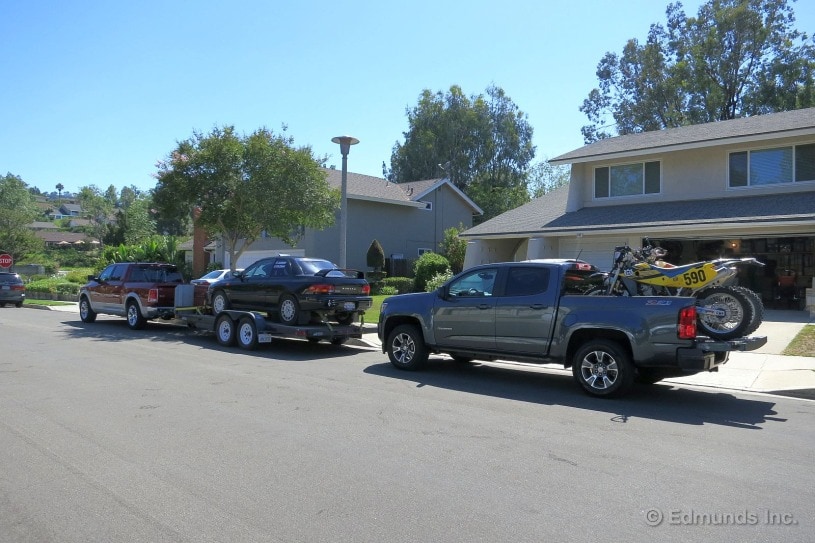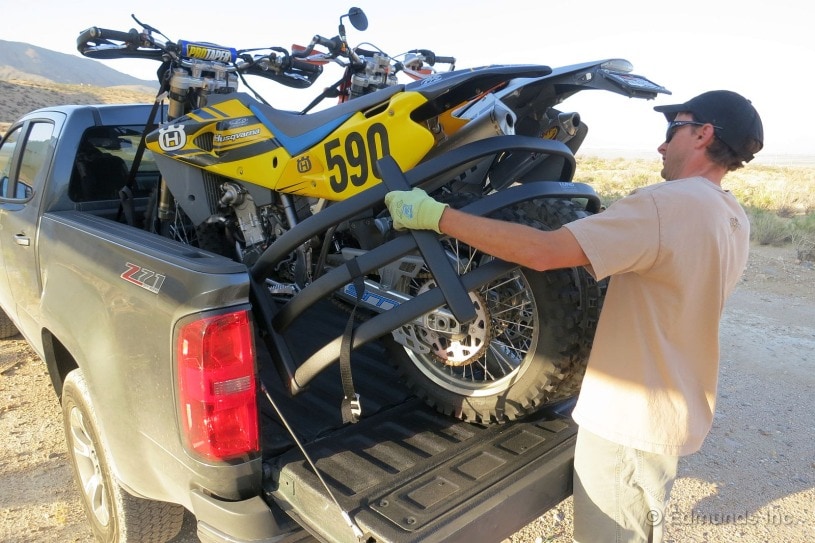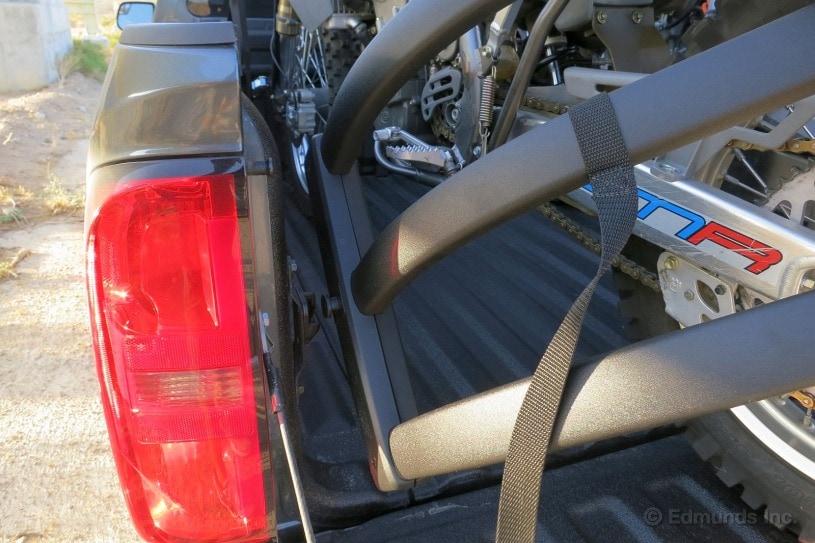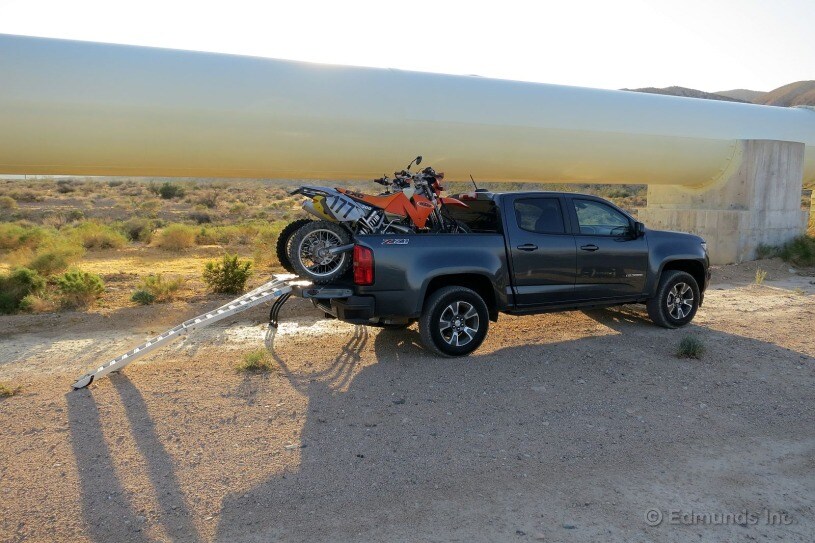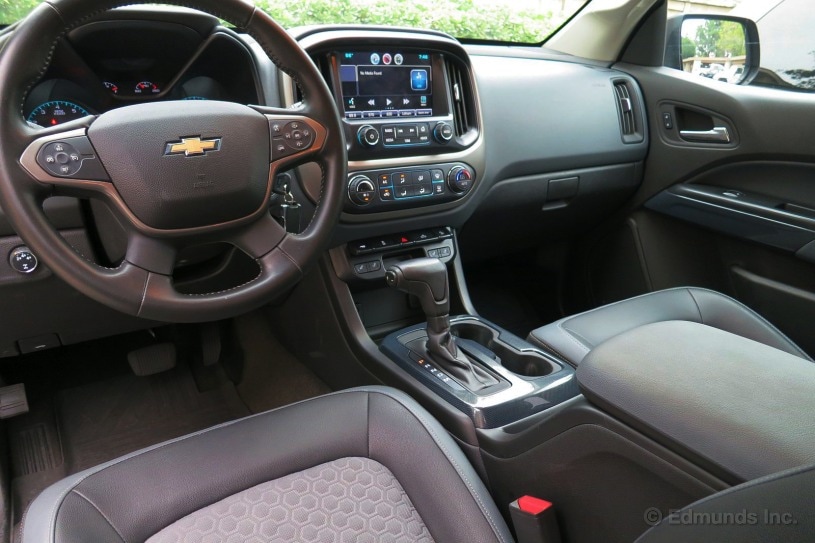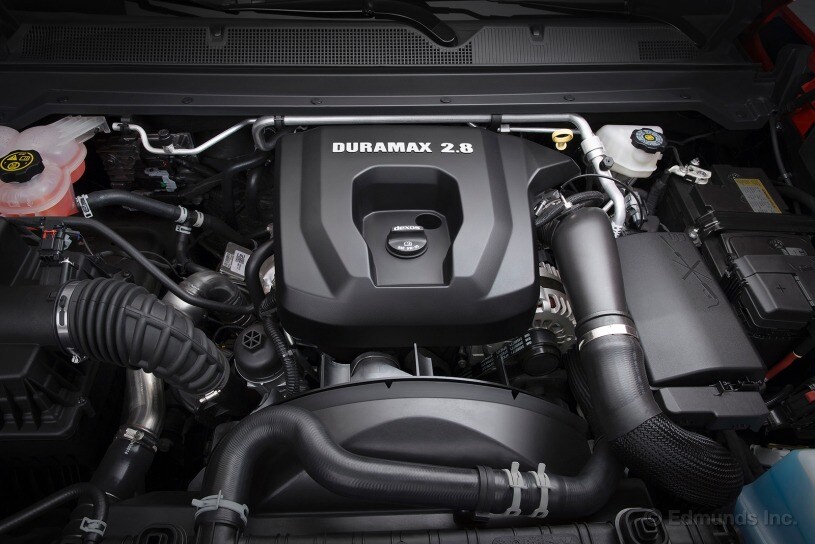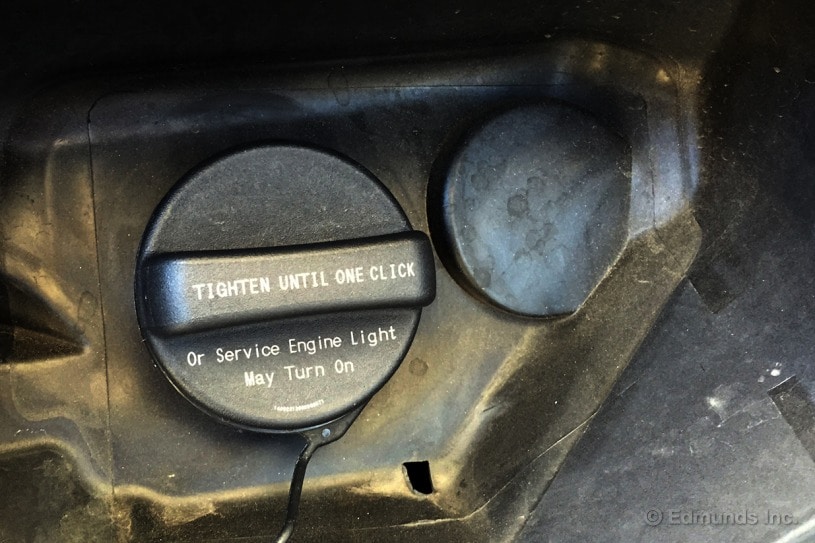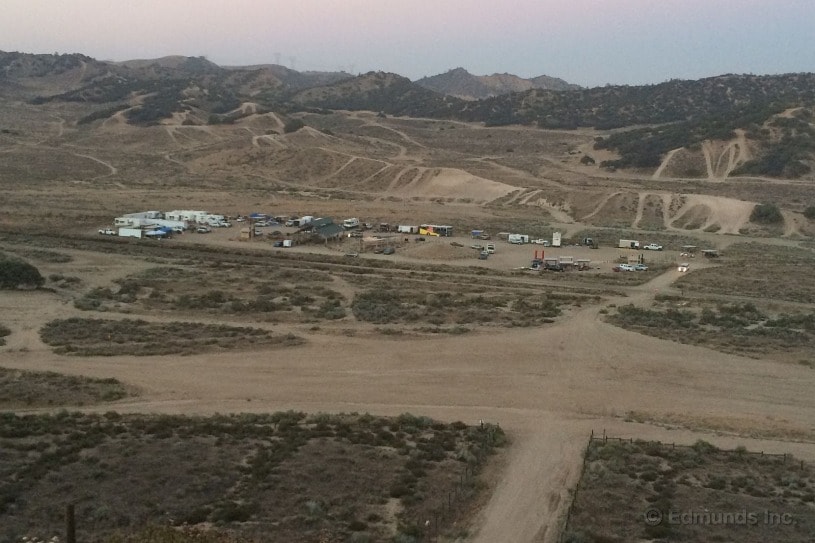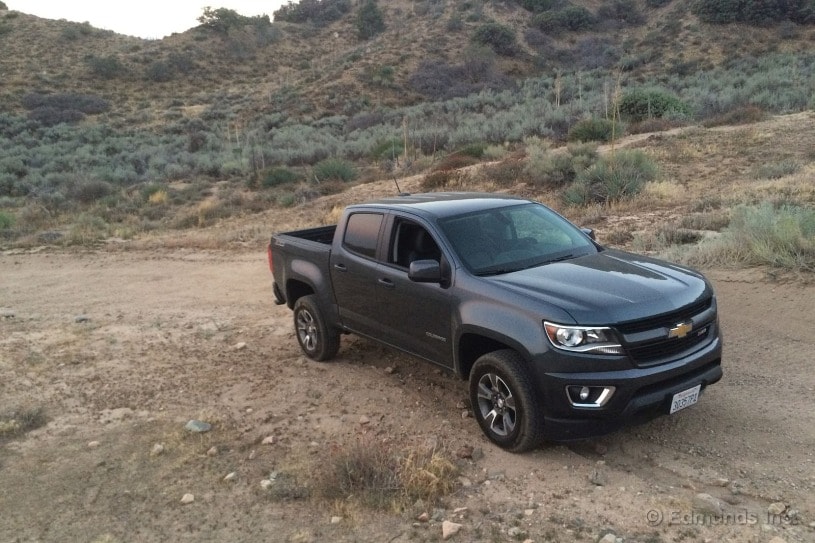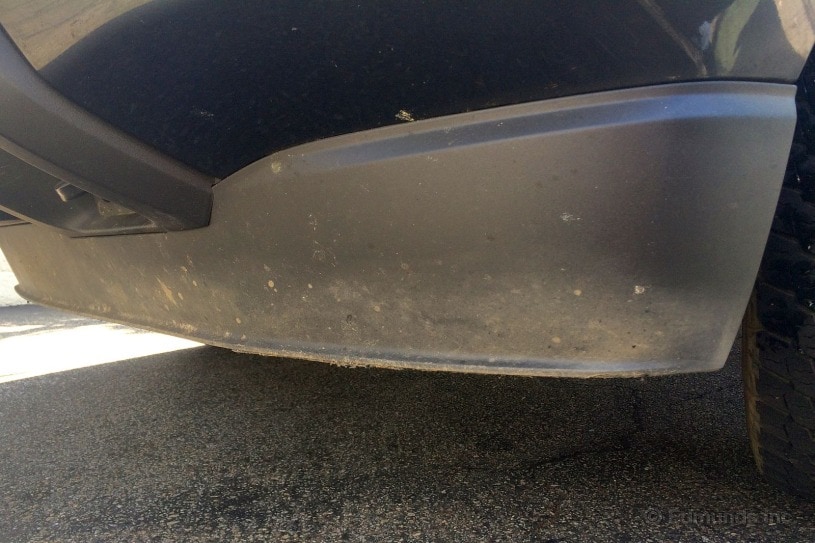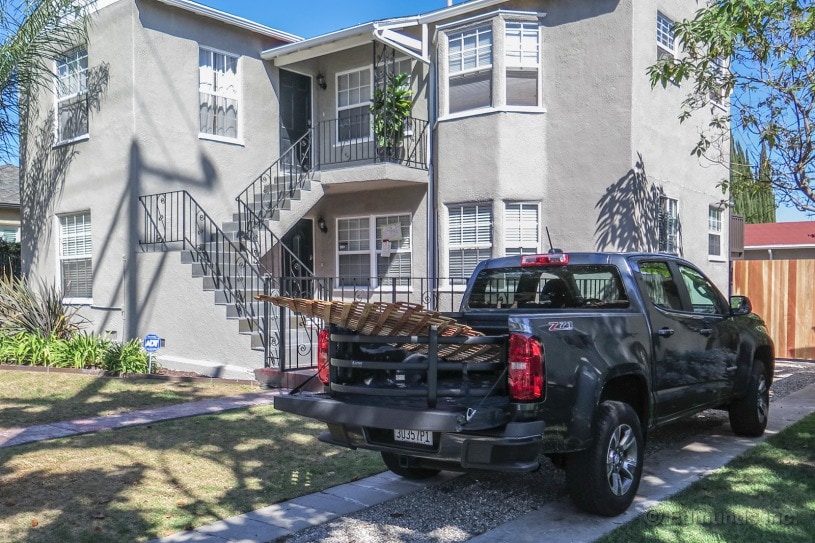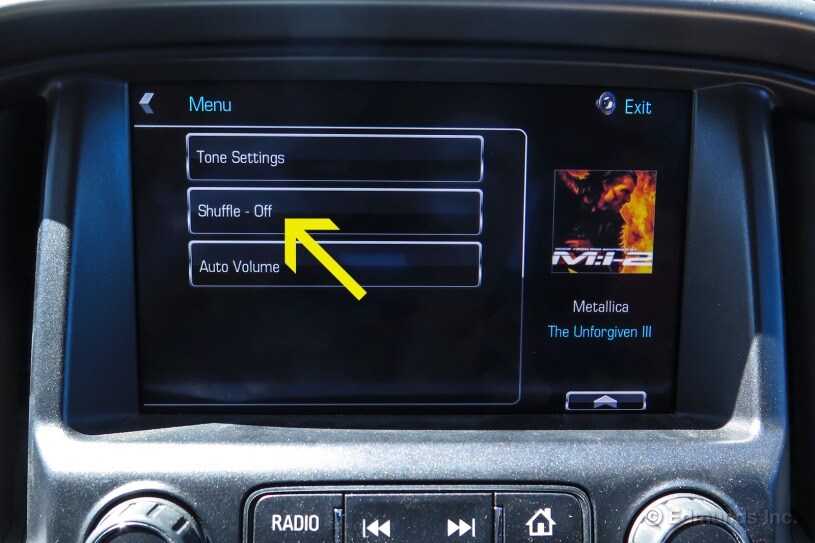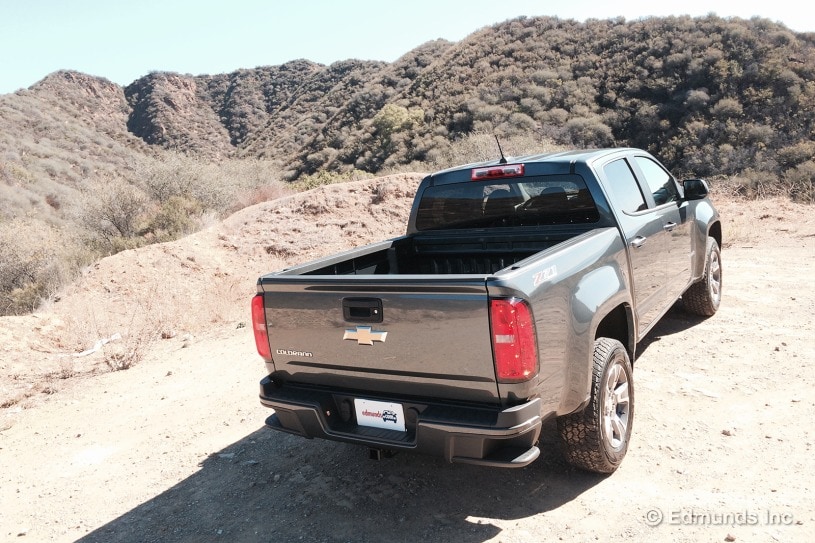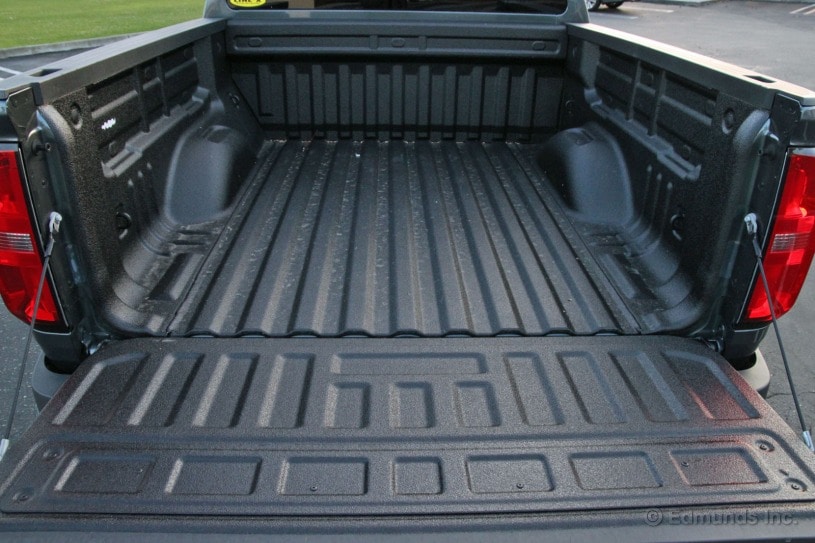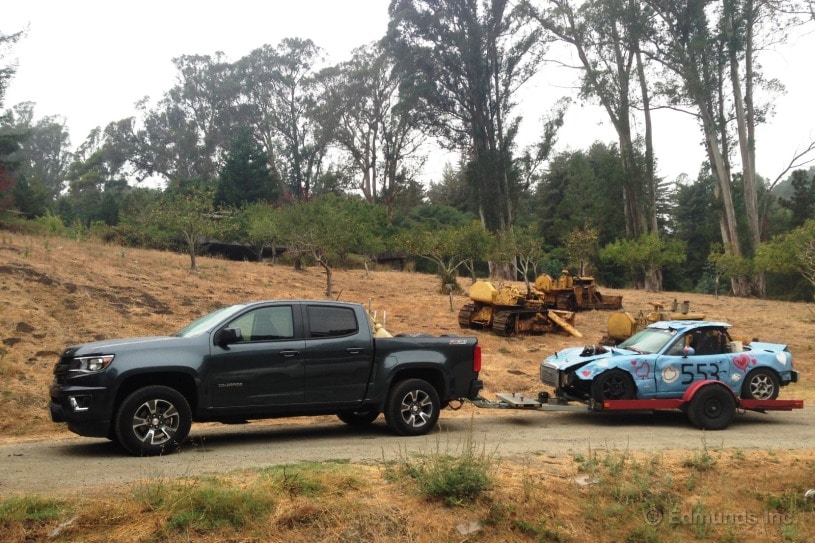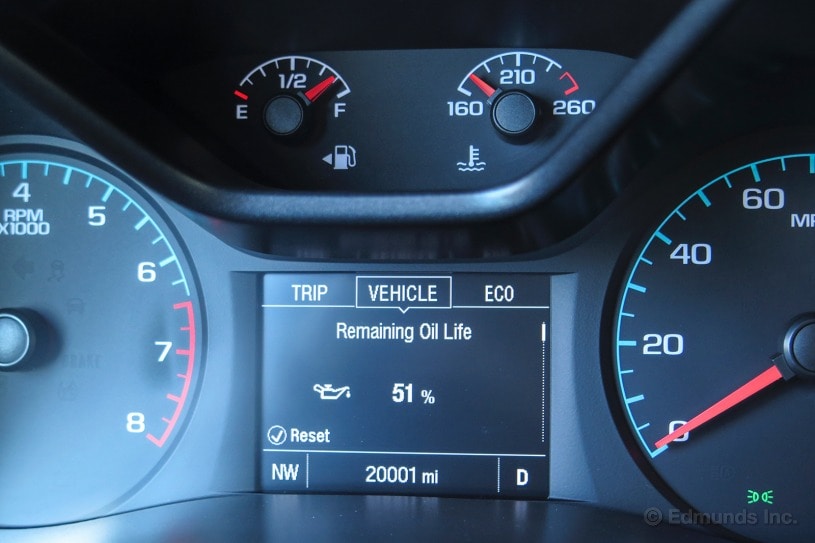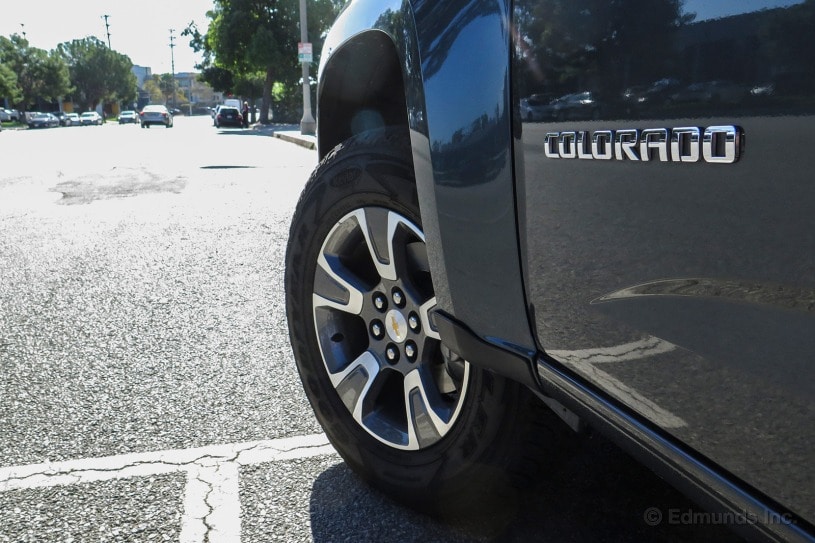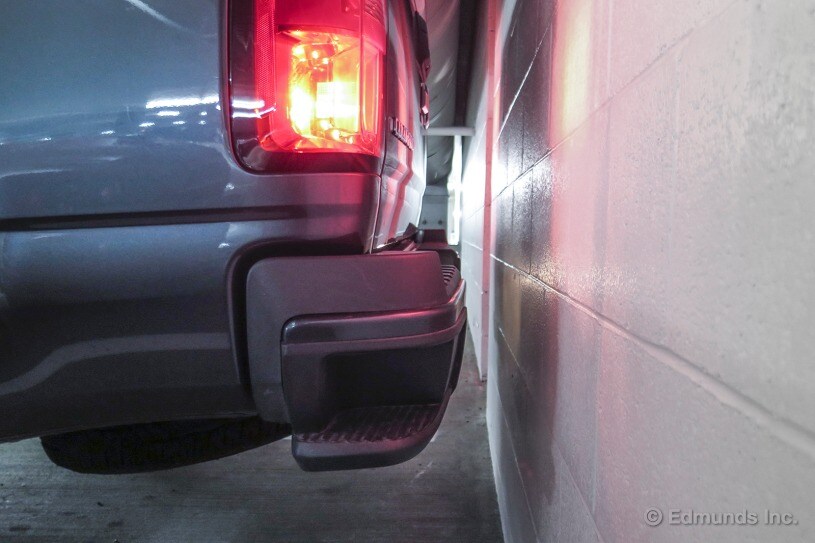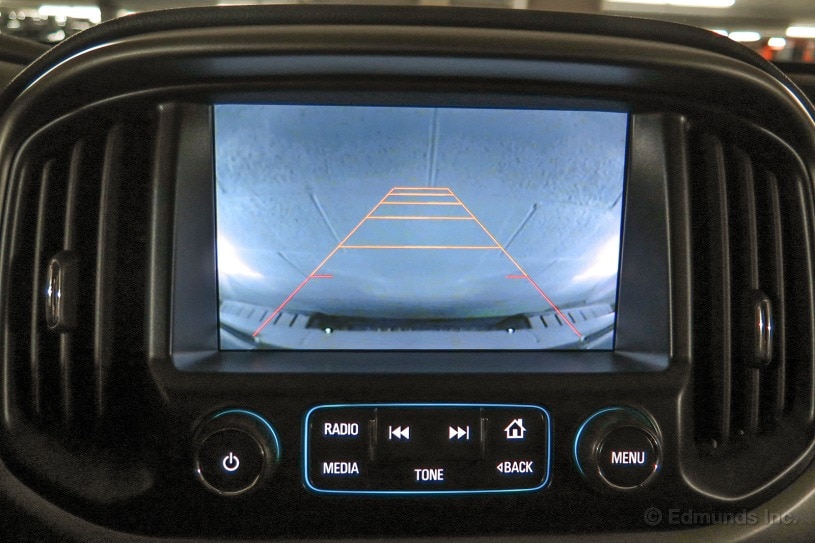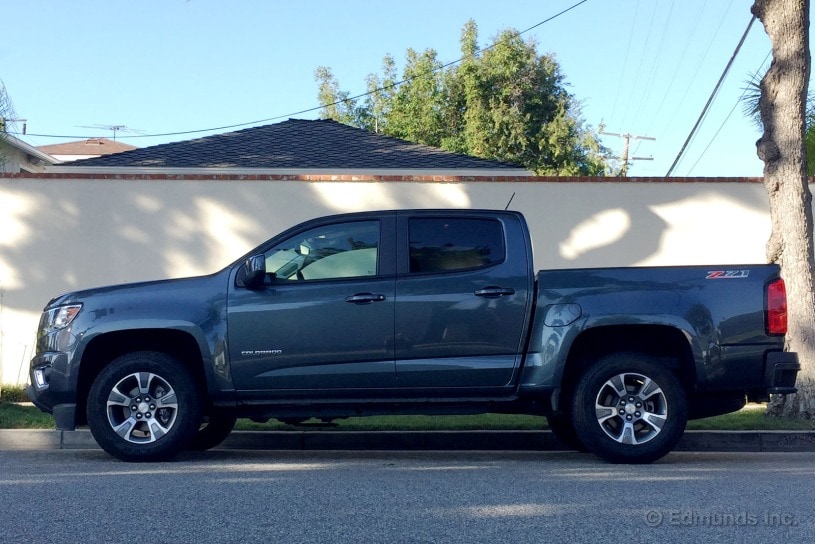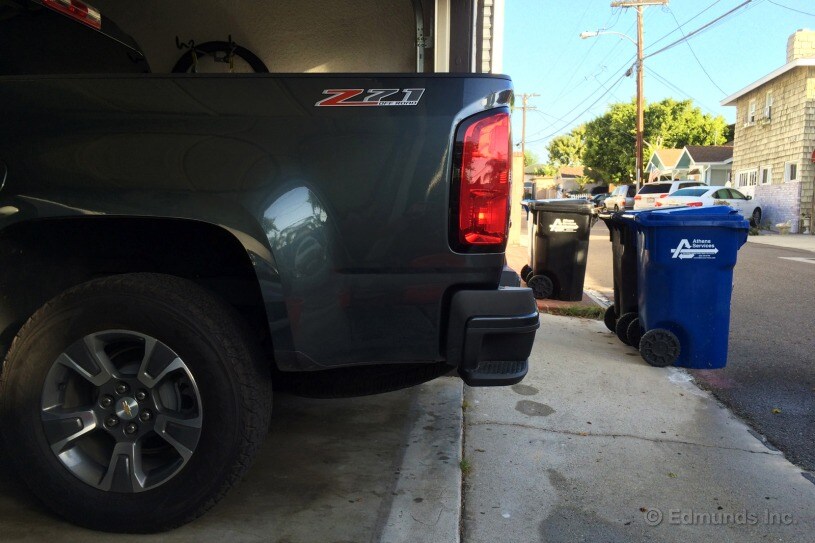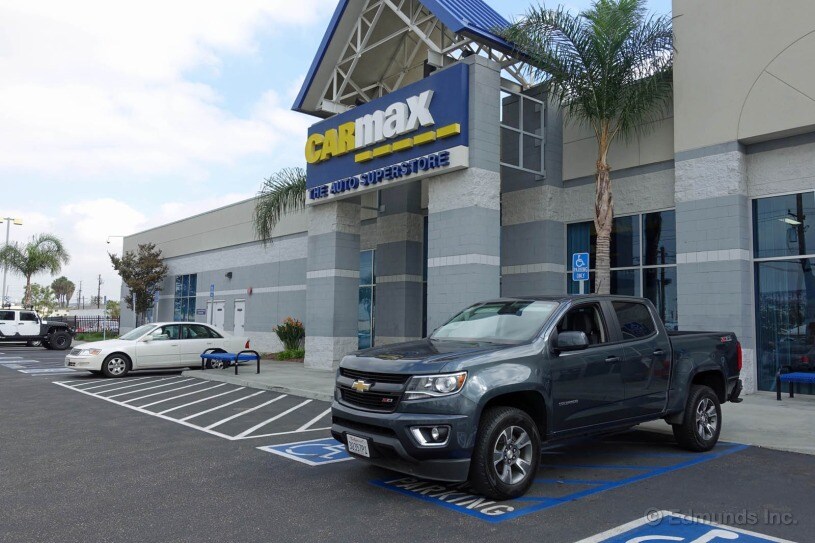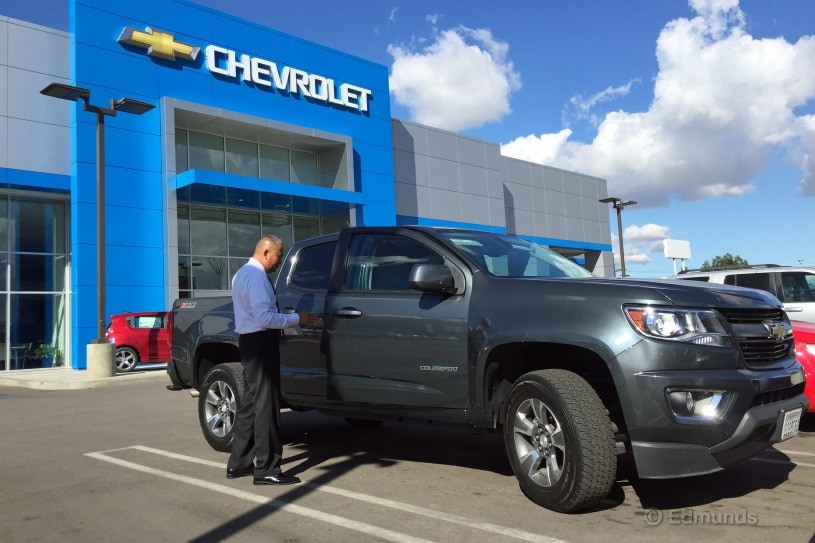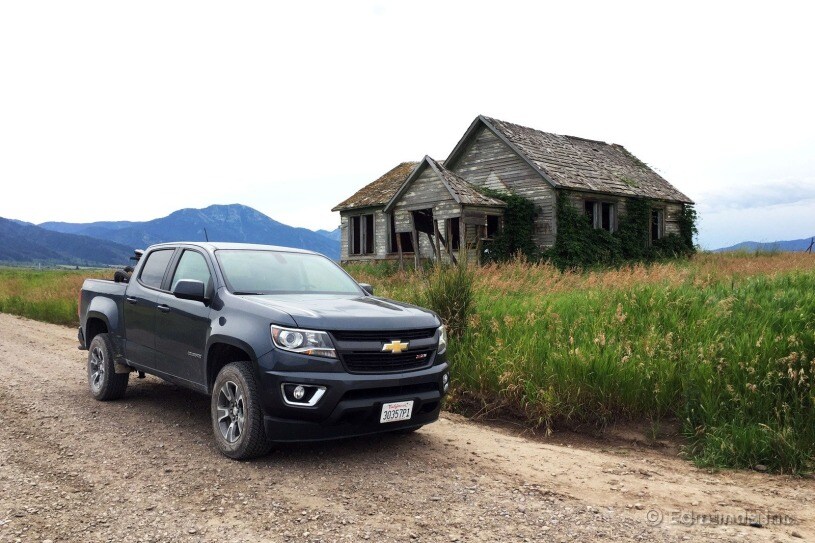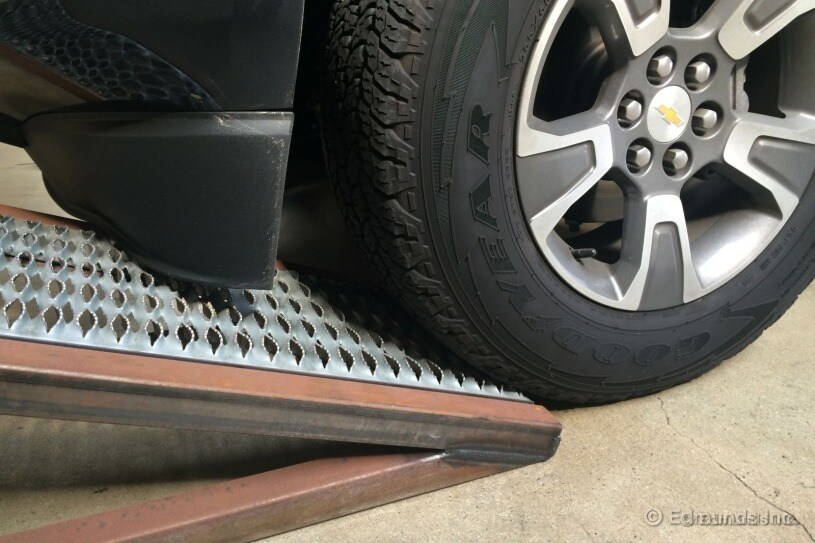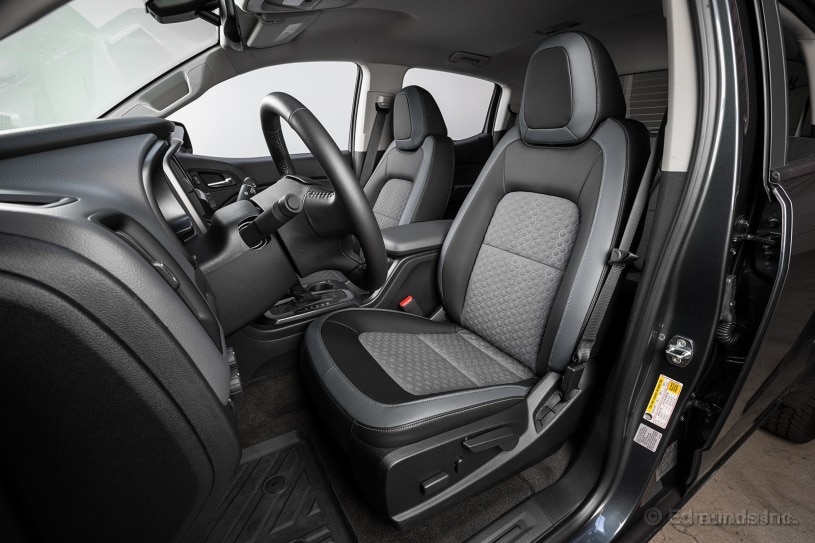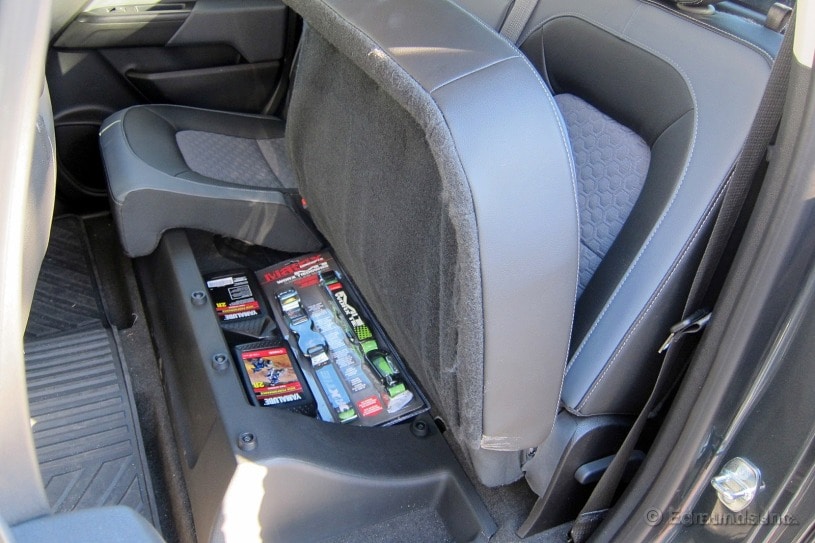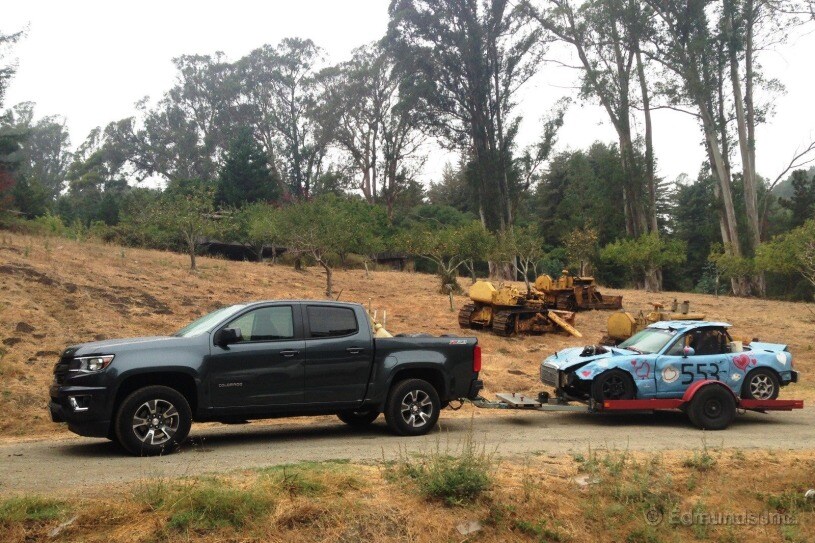2015 Chevrolet Colorado: What's It Like to Live With?
Read the latest updates in our long-term road test of the 2015 Chevrolet Colorado as our editors live with this car for a year.
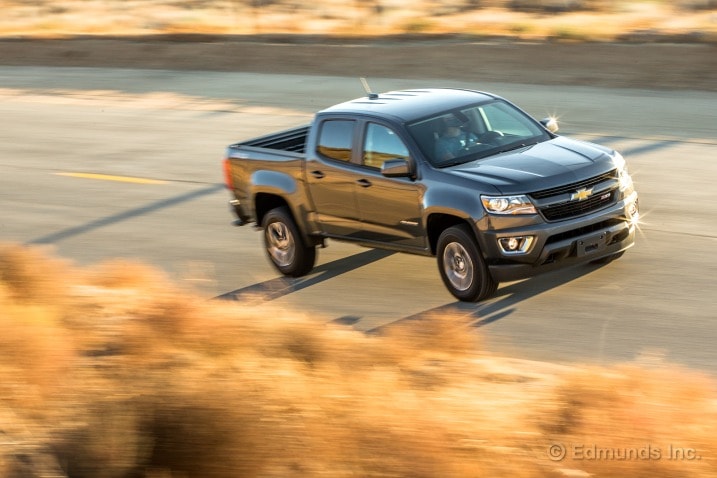
What do you want to know about?
- Introduction
- Tall Box Sides
- Powertrain First Impressions
- The Extended Cab
- Fuel Economy Update for November
- Towing Acceleration Video
- Backup Camera and Trailering
- Tow/Haul Mode
- Hood Flutter
- Door Pockets
- Parking Card Holder
- Do You Need Any More?
- Seat Heaters = More Back Therapy
- A Garage-able Pickup Truck
- We're Still Unclear What This Means
- Does Anyone Like Door Lock Plungers?
- Good on Long Trips
- Fuel Economy Update for December
- The Weather Forecaster
- Performance Tested
- Under-Seat Storage Bust
- Hauls My Go-Kart
- Handles Full-Size Tasks
- Rock-Hard Armrests
- A Good V6, but Not a Great V6
- Good Ride for a Pickup
- CornerStep Bumper and EZ Tailgate
- Blind-Spot Mirror
- I'll Wait for the Diesel
- 5,000 Miles
- Towing Impressions
- Lack of Driver Seat Adjustment
- Simple Gauges
- Hauls Its First Bike
- Installing a Trailer Brake Controller
- Practical Sun Visors
- Fuel Economy Update for February
- First Service Due Soon
- Ramp Travel Index, Take 1
- Towing Impressions, Round Two
- Adding a Line-X Spray-On Bedliner
- Rearview Camera
- Will the 2016 Model Offer a Factory Trailer Brake Controller?
- Awesome Seats
- Does It Make the Cut?
- First Service
- Moving Day
- Will People Want It in 50 Years?
- Feels Appropriately Midsize
- The Right Truck for a Wrong Day
- Installing Child Safety Seats
- Testing MyLink and Siri Eyes Free Function
- Top Five Reasons To Buy This Truck
- Comfortable or Cramped Back Seat?
- Not Great Trim for a Truck
- Deep Center Console, Man
- Off-Road Trim Works Fine On Road
- Seriously Simple Interior
- Turning 10,000 Miles
- It's Growing On Me
- Fuel Economy for May - Lifetime MPG Inches Up
- Recalled for Loose Seats and Chafing Wires
- All Work and No Play
- Doesn't Need Waterproof Buttons
- Track Support Part Deux, Sans Trailer
- Highway Impressions on the Way to the Big A
- Sweating the Calibration Details
- My Top Choice for a City Truck
- Comes With Own R2 Unit
- Hauling Transmission, Scraping Bedliner
- Fuel Economy Update for June — Another 2,000 Miles, Lifetime Average Holds Steady
- We Install a Bed Extender
- A Practical Baby Hauler, But Up to a Point
- Hits 15,000 Miles in Wyoming
- Parking Brake Pad Failure
- Wringing Out MPG on the Road to Wyoming
- Wyoming Road Trip - Range and Driving Impressions
- Wyoming Road Trip Part Three - Comparing Midsize Truck Utility and Cost
- Wyoming Road Trip Part Four - Off-Road Attempt to Avoid Traffic
- Wyoming Road Trip: All The Photos
- Service, Recalls, and an Impressive Dealer Experience
- Food Truck
- Bed Extender Bust
- Nice Accelerator But Lazy Shifting
- Sign of the Diesel to Come
- Sturdy Cupholders
- Mild Dirt Duty Exposes Weak Approach Angle
- Lattice Amaze You
- The Stereo Has Amnesia
- Air Dam Ruins the Off-Road Party
- Fuel Economy Update for August — A Healthy Jump in Combined MPG
- Warming Up to the Spray-In Bedliner
- Towing Compromise We Can Live With
- Size, Capability Sometimes Make It Best Tool for the Job
- Crack Killed Our Windshield
- Rolls Over 20,000 Miles Without Ceremony
- 2,000 Thirsty Miles and Our Worst Tank Yet
- Cutting it Close with the Rearview Camera
- Only Compact By Modern Standards
- Too Long, Not Long Enough
- CarMax Price Quote
- Sold Back to Chevy
- Better Than Tacoma? We'll Get Back to You on That
- Wrap-Up
Introduction
What Did We Get?
It's strange to think that for the last few years, the only midsize trucks for sale in the U.S. were a pair of Japanese pickups, the Toyota Tacoma and Nissan Frontier. General Motors axed the old Chevrolet Colorado in 2012, the Ford Ranger was discontinued after 2011 and the Dodge Dakota was left for dead in 2010.
While the boys from Detroit poured their money into full-size trucks, Toyota and Nissan quietly scooped up customers who preferred pickups with a smaller footprint. So nonexistent was the competition that neither has been significantly updated since 2004.
This year is a different story. The all-new 2015 Chevrolet Colorado is a small workhorse with attractive sheet metal, a welcoming cockpit and engines that are more powerful and efficient than its predecessors. We just had the all-new Silverado in our fleet, so we added a Colorado to our long-term fleet to see how the smaller Chevy stacks up against its bigger brother in terms of utility and comfort.
What Options Does It Have?
The 2015 Chevrolet Colorado is still a truck, so choosing the right one for you will require some familiarization with the options list. This midsize truck is available in two cab styles, two bed lengths, four trim levels, three wheel sizes, four upholstery options, two engines, two transmissions and 10 colors. Still, there are fewer choices to make here than in the full-size Silverado 1500. After consulting the seemingly endless list, we made our decisions.
The 2015 Chevrolet Colorado starts at $21,870 for the base Extended Cab. The least expensive 4x4 is the same configuration in Work Truck trim, which rings in at $28,635.
As noted in our road test, we expect the 4x4 short bed with the extended cab and V6 to be the strongest seller, so we started there. During that test, we found that we liked the Z71 trim level and its off-road capability. Standard features that are optional or not available on other trims include an automatic locking rear diff, hill descent control, foglamps, heated front seats and remote start. With destination charges, our Cyber Gray Metallic truck carries an MSRP of $34,990.
We're going to be spending a lot of time in our Colorado, so the navigation system ($495) and seven-speaker Bose audio were musts ($500). We'd like to test the Colorado's 7,000-pound towing capacity, so we opted for the $250 Trailer package that includes a hitch and four- and seven-pin connectors. Lastly, we ordered floor mats ($160) and a rubber bed mat ($140).
Total MSRP on our 2015 Chevrolet Colorado is $36,535. Because we have repeatedly purchased cars at Selman Chevrolet in Orange, California, they offered it to us at the invoice price of $35,357.
Why We Bought It
The midsize truck segment was left for dead a few years ago, but not because no one wanted them. Much of it came down to pricing. As full-size trucks became less expensive and started to overlap more with midsize trucks, most buyers chose to go for the bigger truck.
But owning and driving a full-size truck has its disadvantages over the long run. It's harder to park, uses more gas and doesn't always fit in a garage. So if you don't need the extra interior space and towing capacity, is a midsize truck a better choice?
We'll find out in the next year along with the answers to plenty of other questions. How does the Colorado perform when the pavement turns to dirt? And will its Goodyear Wrangler All-Terrain Adventure tires and off-road suspension prove too uncomfortable in day-to-day driving?
We have 12 months and 20,000 miles to evaluate the first new midsize truck in a decade. Frequent our Long-Term Updates page as we chronicle our adventures in our pickup.
Best MPG: 19.2
Worst MPG: 17.3
Average MPG over 652 miles: 18.2
Edmunds purchased this vehicle for the purpose of evaluation.
Yes, that is indeed "stuff" in the box of our long-term 2015 Chevrolet Colorado, a midsize pickup. Prepare yourselves for plenty more photos of objects there because, after all, it's a truck.
I show you that jungle-gym subframe thing there (a thousand internet props to anyone who can correctly guess the make and model it came from) not out of a sense of pride for using a truck in a truck-like manner. No, I show you this object to illustrate something about the Colorado which is, again, a mid-size pickup.
The thing shown in the Colorado's box weighs about 25 pounds. It doesn't even begin to exercise the truck's payload or volume capacity. The worst that can be said about it is that it's greasy and a bit cumbersome.
One of the advantages of a midsize pickup over a full-sizer is, well, its more-manageable size, right? I should be able to just place that sucker on the bottom of the box by reaching over the sides of the box and be done with it. I shouldn't have to lift the object much above waist height in order to do so. After all — midsize pickup.
But the box is too damn high.
The Colorado's box sides come up to the center of my sternum, and I'm six-foot-one. Way higher than you (or I) might expect from the Colorado, a midsize pickup. I can bring that device up to my chin so that it clears the box sides, sure, but there's no gently laying it on the bottom of the box, that's for sure. It'd be a two-foot drop from that point.
Being able to more easily place stuff into the box is (or should be) one of the bonuses of a smaller truck, but in this case it isn't happening. Certainly our truck's Z71 off-road package has jacked the ride height up, so take that into consideration when configuring your Colorado.
Our long-term 2015 Chevrolet Colorado is equipped with the larger of the two engines available, a 3.6-liter V6, that's backed by a six-speed automatic. The V6, known as LFX, and the 6L50 transmission are straight out of GM's parts bin.
Somehow, both of them seem less refined in the Colorado than I recall from other applications.
Mainly, the transmission tends to favor higher gears too readily in the Colorado. This is a fuel economy strategy that can leave the Colorado feeling down on power. Shifts are unhurried, syrupy and torque converter-y. Manual mode, too, serves up gears in a leisurely manner.
Also, the transmission can be indecisive. At one point (in auto mode), the transmission upshifted when it was in the middle of a downshift. For real, it was kicking down in response to a throttle squeeze, and before the downshift could be completed it decided to upshift instead. It's not a terrible gearbox, but it could be better.
The engine has a decent spread of torque that is, as mentioned above, sabotaged by the transmission calibration. That, and it sounds pretty coarse, subjectively speaking, during even moderate acceleration events. At a cruise the truck is fairly serene.
Again, I don't think its powertrain is bad based on these initial impressions, just not outstanding. I look forward to evaluating its tow/haul calibration.
Our 2015 Chevrolet Colorado is a Crew Cab model, but I got a chance to check out an Extended Cab at the 2014 Los Angeles Auto Show. There are two main differences between the two body styles. First, the Extended Cab is available only with the 6-foot-2-inch bed length, whereas as the Crew Cab is available with the 6-foot-2 or a 5-foot-2 bed. Our truck has the latter and obviously a foot can make a big difference when hauling things around.
However, there's a good chance the biggest day-to-day difference can be found in the cab itself. Needless to say perhaps, but the Extended Cab has significantly less rear space. Instead of the full-size, three-person bench in the Crew Cab that two adults can actually fit quite comfortably upon, the Extended Cab has a pair of small jump seats.
Now, these seats look to be about 1,000 times sturdier than the quite frankly scary inward facing jump seats I remember from my friend's old Ford Ranger, but they still don't seem very usable. Apart from my small dogs and perhaps some vertically challenged adults, I have trouble imagining anyone realistically using these. Children would fit, but they should be in car seats, which, as the warning in the lower right of the photo shows, cannot or should not be installed on the jump seats. My wife is 5-foot-zip and there's no way she'd fit back there unless someone equally diminutive was driving.
Although there are tiny bins beneath the seats, I have to wonder if a full-width flat surface would be more useful to Colorado owners than these jump seats. Or better yet, just get the Crew Cab with the long bed.
Our 2015 Chevrolet Colorado was all new in November and is yet to complete a full month in the fleet. With only about 1,100 miles under its belt, the Colorado has already performed brief towing duties and has five fills under its belt.
Here are the numbers so far:
Worst Fill MPG: 14.0
Best Fill MPG: 19.2
Average Lifetime MPG: 16.8
EPA MPG Rating: 20 Combined (17 City/24 Highway)
Best Range: 337.5
Current Odometer: 1,132 miles
Check out video of our 2015 Chevrolet Colorado accelerating from 0 to 60 mph with 6,122 pounds in-tow. Take the jump for the numbers behind it and comparison to an unladen Colorado...
Our four-wheel-drive Colorado, with the 3.6-liter V6 and Z82 trailering package, has a tow rating of 7,000 pounds. We loaded it up to 87-percent capacity (2,210-lb of trailer and 3,912-lb of Mercedes-Benz B-Class) for what was a visually uneventful acceleration run. But uneventful is exactly what you want in real-world freeway merging. Here's how it looked on paper:
0-30 = 6.2 seconds
0-45 = 10.5
0-60 = 16.9
0-60 = 16.5 (with one-foot of rollout)
0-75 = 26.2
1/4 mile = 21.1 @ 68.9 mph
We achieved these figures using manual-shift and tow-haul modes in the trailered truck (blue). In the trailer-free Colorado (red) we used manual-shift and normal mode. Chart below:
A rearview camera is standard on every trim level of the 2015 Chevrolet Colorado. So buy a Colorado and you'll have this benefit.
Last weekend I used the Colorado to haul my trailer to its storage location. And for the first time in my life experienced the awesome benefit of using a backup camera to align a trailer hitch to a trailer. In the Chevy Colorado the camera is positioned well and offers perfect perspective for putting the ball right underneath the coupler. And when Dan Edmunds is back there to crank the trailer foot down, the whole process takes about 30 seconds.
Awesome.
Last weekend I did some light towing with our 2015 Chevrolet Colorado. Very light towing, that is. I hauled my unloaded trailer about 15 miles to drop it off in storage. At about 2,000 pounds, the unloaded trailer represents less than 30 percent of the Colorado's 7,000-pound maximum tow rating.
Still, Tow/Haul mode was a must. Naturally, I forgot to push the button when I first hit the road, but as soon as I turned out of my neighborhood and started up the hill, it was clear that, even unloaded, the trailer was enough load to demand an optimized transmission calibration. It was immediately two gears too high and struggling with the grade and load.
Not that this is a meaningful test, but as soon as I hit the button, the transmission downshifted and the Colorado yanked the trailer up the hill without issue. I'm looking forward to seeing what a real towing experience, with a car on the trailer, is like soon.
Drive our long-term 2015 Chevrolet Colorado on the freeway and you might notice that the hood flutters. Not the whole hood, mind you, and not in some violent, disconcerting manner.
Rather, it's the top sheet metal surface, and it sort of quivers constantly in place in response to inputs via road and/or wind. It is most noticeable right at the cowl, if only because that's the portion of the hood closest to the driver and thus easiest to examine while hurtling along at freeway speeds.
At first I mistook the hood's busy action as merely a reflection of an irregular horizon. But after a few glances I realized that the apparent motion is no optical illusion, and it is the hood sheet metal itself causing it.
It's only an annoyance in that it is constantly zizzing away in your peripheral vision, serving as a source of distraction.
You might not guess it from the picture above, but our long-term 2015 Chevrolet Colorado's door pockets are curiously stingy in terms of offering real-world storage.
I get it, this is not a full-size pickup and I shouldn't expect full-size storage capability. But the Colorado's door pockets look more impressive than they really are. After all, in the photo above, the pockets appear pretty danged useful.
It's an illusion. To give you a better reference for size, allow me to describe the cupholder nook you see in the lead picture. See it? Looks ample, right? Guess again. It is sized for something only a bit larger than a Dixie cup. That's only a slight exaggeration.
Likewise, the other two pockets are quite shallow, height-wise. And not very wide, either, making them suitable for stashing trinkets, and little else. It's weird, because even after I concluded that they were lacking in the real world, I look back at this photo and I'm surprised by how normal they appear.
Door pocket size isn't something I often scrutinize very closely. But when it comes to vehicles like the Colorado whose sole purpose for existence is utility, these ones stand out for being pretty skimpy.
Now you know.
At Edmunds HQ, we access the garage with a little plastic card that's waved at a big plastic box near the gate arm. This card gets combined with an office access card to create a little plastic tandem that I carry around a good portion of my day. When they're in the car, they usually take up space in a cupholder or other little bin, which means they get in the way a lot.
In the 2015 Chevrolet Colorado, there's a handy little slot to the left of the steering wheel that perfectly holds my access cards. Alternatively, they could hold a parking garage ticket, which I can only view as an improvement upon the cupholder, your wife's purse or somewhere lost under your seat. It's a thoughtful, useful detail.
Do you really need more capability from your truck than the 2015 Chevrolet Colorado provides? Do you need a 5- or 6-passenger cabin capacity for your family? Do you need to tow more than 7,000 pounds? Do you need a bed bigger than the Colorado's? And most importantly, do you need them on a regular basis.
These are the questions you need to ask yourself when going truck shopping at the local Chevy store. As I ponder in our Chevrolet Colorado vs. Chevrolet Silverado comparison video, if you don't regularly need the Silverado's greater capabilities, does it really make sense to pay extra? And as I discovered, that extra can be up to $12,000 more for a Silverado that's similarly equipped to our long-term Colorado.
Sure, there's a $9,500 incentive on the Silverado at the moment and such discounts are hardly uncommon, but nevertheless, the fact that the Colorado is now so good means people who don't really need the Silverado's capabilities have a viable alternative.
Our long-term 2014 Chevrolet Silverado 1500 left our fleet a while ago, but that doesn't mean all of its fancy features have gone with it. Now that we've got its little brother, a 2015 Chevrolet Colorado in our fleet, we get these nifty seat heaters back too.
Basically, these are dual-location seat heaters. You can turn the heat on just for your back, or you can warm up your back and butt at the same time. This feature is on a few other GM products and it's available on some top-end luxury cars as well, but otherwise it's pretty rare. And as Erin Riches pointed out in our long-term Silverado, it's a great tool for treating back pain. So when I got overzealous with some furniture rearrangement earlier this week and tweaked my back, I was happy to see the Colorado was available.
By comparison, the Colorado has narrower and more rigid seats, but they're still totally livable for the daily commute and this is a feature I'd make sure to select if the Colorado was on my shopping list.
Unless and until I really need one, I'm not much of a fan of pickup trucks. Mostly because they're designed and built to carry a load in the bed, and unloaded they usually ride like a box car. But also they're often difficult to park, so I usually pick something else to take home. I had no choice last night and so I drove our new 2015 Chevrolet Colorado home and thought I'd see if this compact pickup actually fit in my garage. Well, Bob's your Uncle! At 17-feet 8.7-inches, it fit with about an inch at either end.
I wouldn't have been able to that with our 19-foot 11.6-inch Chevy Silverado.
Every new addition to the long-term fleet is a mystery unfolding, and part of that process means digging through the settings menus. I was doing just that this morning in our 2015 Chevrolet Colorado and stumbled on an old nemesis: Unlocked Door Anti-Lockout.
You see, our Corvette Stingray had this same feature and the best I could come up with then was "programmed delayed auto-locking is on when this is off." A little more internet sleuthing revealed that it essentially means you cannot ever turn off auto-locking (hate it), and you can prevent an unintended (or intended) lockout that would happen if you manually locked an open door by hand and slammed it shut.
Did I get it (more) right this time?
Granddad's Oldsmobile had them. So did mom's station wagon and my first car, a Ford Ranchero. I'm talking about golf tee-shaped door lock plungers. The kind that bruised your arm when you hung it out the window. The kind that thieves (and owners that locked their keys inside) could easily defeat with a bent coat hanger.
The automakers' anti-theft response to this was the banishment of the tee-shaped head in favor of a textured cylindrical surface that fingertips could grip but coat hangers could not. The revised plungers still had to stick up to accommodate grabbing fingers in the lock position, so arm welts remained an occupational hazard for window-down drivers.
Meanwhile, the in-flooding Japanese competition tended to use a roller-action locking mechanism down by the inside door handle that instantly seemed like a better idea.
I don't know why, but the use of plunger-style door locks seems old-timey and quaint in our 2015 Chevrolet Colorado, especially since our test sample has power door locks. To be fair, it's hardly alone in this. There are several others that go the same way. But does anyone really like or depend on them? What am I missing other than a well-developed sense of nostalgia?
Here the manual locking mechanism is a necessity because the Colorado comes in Base and Work Truck configurations that don't come with power locks. In those versions you lock the truck with the plunger before closing the door. And it's easy to reach across and lock the passenger side if you see that it's unlocked.
But the Colorado's plungers are flush in the lock position. Hooray for no arm welts, but how do you unlock a manual-lock Colorado from inside?
You pull the door-opening handle twice, of course. The first one unlocks the door and lifts the plunger, the second one opens it.
It works just the same in our power door lock-equipped Colorado, but there's generally no need. The doors are set to auto-unlock — all four or just the driver's door — when the transmission is shifted into Park. Or we can use the power unlock switch that's nearby. For us the manual mechanism is a back-up system for when the power locks fail.
Having said all of that, I prefer roller or lever-action manual locks located down near the inside release handle. I've never been a huge fan of any iteration of the plunger arrangement, aesthetically or otherwise.
I took our long-term 2015 Chevrolet Colorado on a road trip to Sonoma Raceway and back to Los Angeles recently. The original plan was to tow a trailer and car back from the track, hence the need for a trucky-type thing.
Alas, the towing portion of this trip never materialized due to logistical change-ups along the way. But I did find that the Colorado served admirably as a place to spend several hours in the saddle.
I found the seats pretty comfortable over the long haul. A bit more thigh support wouldn't be unwelcome, but otherwise the seat proved comfy with only a hint of road butt after three hours. The Colorado settles in nicely at speed, with low noise levels for a truck and good straightline stability. And really, when you're plodding up Interstate 5, those two attributes are key.
Here's a quirk I discovered: At night, the Colorado's center stack controls show up in the rearview mirror. Que, you say? Allow me to describe the situation. The Colorado's radio, multimedia screen and HVAC controls are illuminated, and the rear window is basically vertical. Our Colorado doesn't have a bench seat, so there's a clear line of sight from the center stack to the rear window. Hence, the center stack controls appear projected onto the surface of the rear window when you glance in the rearview mirror, in what appears to be the worst implementation of a head-up display ever devised. No big deal, just turn down the brightness and it's fine. I tried to get a photo, but as you might imagine it came out crap.
Anyway, back to our trip. A trip like this in a current Toyota Tacoma would probably be considerably more fatiguing, as even a new Taco is an old truck in the context of model changeovers. However, if you haven't heard, Toyota's unveiling a new Tacoma in a couple of weeks at the Detroit auto show. Now that I've spent a good, solid amount of time in the Colorado, I'm keen to learn what Toyota's planning as a riposte.
Now that we've had a little more time to stretch its legs, our 2015 Chevrolet Colorado is posting slightly better mileage. And I say slightly because it's still well off its combined rating of 20 mpg.
In December alone, however, its overall average jumped from 16.8 mpg to 17.7 mpg. That's a big improvement in a short time, so we'll see how it goes in January.
Most of our long-term cars improve initially and then level off after the first few months. A few long road trips might push the number higher again, so it still has a chance of getting closer to its advertised rating. It doesn't happen often, but our Volkswagen Passat recently hit its advertised combined rating after a year so it's not impossible.
Worst Fill MPG: 14.0
Best Fill MPG: 19.2
Average Lifetime MPG: 17.7
EPA MPG Rating: 20 Combined (17 City/24 Highway)
Best Range: 375.3
Current Odometer: 3,853 miles
It was an early morning and even after a second cup of coffee, I was a little foggy. I usually check the weather forecast and traffic sitchu before departing and figured our new 2015 Chevrolet Colorado would cover me on the traffic front.
I was happy to find it was equipped with SiriusXM Travel Link that provides an hourly and up to a five-day weather forecast. Who needs Dallas Raines?
We bought our 2015 Chevrolet Colorado just over two months ago, and it is quietly racking up miles as a suitable highway companion. It's perfectly stable on the road even as it approaches its towing limit, which we experienced when we hooked up a trailer and a 2014 Mercedes-Benz B-Class Electric Drive. We even tested the Colorado's acceleration while fully loaded. But how would this midsize truck perform without a car weighing it down?
The off-road-oriented Goodyear Wrangler All-Terrain Adventure tires wouldn't be happy about it, but it was time to gather the Colorado's performance numbers at our test track.
Vehicle: 2015 Chevrolet Colorado
Odometer: 3,127
Date: 12/18/2014
Driver: Josh Jacquot
Price: $36,535
Specifications:
Drive Type: Four-wheel drive
Transmission Type: six-speed automatic
Engine Type: Naturally aspirated V6
Displacement (cc/cu-in): 3,564 / 217
Redline (rpm): 6,500
Horsepower (hp @ rpm): 305 @ 6,800
Torque (lb-ft @ rpm): 269 @ 4,300
Brake Type (front): One-piece ventilated disc with four-piston fixed calipers
Brake Type (rear): One piece ventilated disc with single-piston sliding calipers
Suspension Type(front): Independent coil-over-shock, twin-tube shocks
Suspension Type (rear): Solid axle, leaf springs, twin-tube shocks
Tire Size (front): 255/65R17 110T M+S
Tire Size (rear): 255/65R17 110T M+S
Tire Brand: Goodyear
Tire Model: Wrangler All-Terrain Adventure
Tire Type: Low rolling resistance, all-season
As-Tested Curb Weight (lb): 4,486
Test Results:
Acceleration:
0-30 (sec): 2.9 (w/ TC on 2.9)
0-45 (sec): 4.9 (w/ TC on 4.8)
0-60 (sec): 7.5 (w/TC on 7.4)
0-60 with 1-ft Rollout (sec): 7.2 (w/TC on 7.1)
0-75 (sec): 11.2 (w/TC on 10.8)
1/4-Mile (sec @ mph): 15.6 @ 88.8 (w/TC on 15.5 @ 89.5)
Braking:
30-0 (ft): 33
60-0 (ft): 129
Handling:
Slalom (mph): 60.3 (58.3 w/ESC on)
Skid Pad Lateral acceleration (g): 0.74 (0.74 w/ESC on)
RPM @ 70: 1,800
Comments:
Acceleration comments: The best way to make the Colorado accelerate is to simply take your foot off the brake and floor the throttle in "Drive." Other techniques, including power braking (brake/throttle overlap) result in wheelspin with the traction control off, which only hurts acceleration in the Colorado. The V6 sounds coarse at high rpm but it likes to rev, which is uncommon in truck engines. Work it hard and you'll hear it plenty.
Braking comments: Though its brake pedal is initially very firm and confident (as it is in everyday driving) the Colorado's brakes faded substantially in three 60-0 runs. The third run was 15-feet longer than the first and there was substantial pedal fade.
Handling comments:
Slalom: This is a well-mannered truck, but it's still a truck. Being narrower than full-size trucks helps it weave through the cones more easily, too. Transitions are competent and there's a decent sense of what's going on, though the steering feel could be better. Even so, for a truck, this is a pretty good one.
Skid Pad: There's little to be learned on the skid pad in most trucks and that's the case with the Colorado. It doesn't like extended steady-state cornering. Once the limit of the front tires is reached the stability control system reigns in understeer by trimming throttle.
Two quarts of oil and a nearly flat package of tie straps. That's it.
That's all I could fit in the storage bin under the rear seat of our long-term 2015 Chevrolet Colorado. Anything more or anything taller and returning the seat bottom to its down position becomes impossible.
I'm disappointed by this. Maybe my expectations of space were too great, but I've used the under-seat storage in many other trucks and recall them offering more area. Significantly more. Especially more height. The Colorado's bin is only a few inches deep at most.
The Colorado's under-seat storage is still obviously useful, but its use is extremely limited.
I bought another go-kart. Please don't tell my wife.
It was one of those impulse things. I karted quite a bit back in the '90s. Spent time in 100 clutch karts and owned a 125 shifter (Mac Minarelli chassis with a TM engine) for a while. I was almost good at it. Almost. Always wished I was better.
After 15 years of nothing I found myself shopping KT100-powered Tony Karts on Craigslist. I always wanted a Tony Kart. Thought they were cool.
Next thing I knew I was standing in some guy's garage handing over $950 for a well-preserved 2002 Tony Kart Mitox, a rough but usable stand and a functioning starter.
That's it in the bed of our long-term 2015 Chevrolet Colorado on its way to CalSpeed Karting (on the grounds of Auto Club Speedway in Fontana, CA) for its first shakedown.
After a few laps all I could think was, "Man, I forgot how hard these things are to drive."
But enough about my midlife crisis and questionable driving skills, let's talk about the truck.
Remember, after much debate we bought a short bed version of the Colorado. Despite that questionable decision, it handled my air compressor, gas can, toolkit, go-kart, gear bag and a few chairs for me and my kids. Quite a bit of stuff, but bringing the kart stand was not an option.
Even without it, there was no way I was closing the tailgate. Instead I over-strapped everything down and made the 130-mile roundtrip without any problems. In fact, the Colorado's ride smoothed out nicely with the few hundred pounds in the bed.
Personal use pickups are bought with this type of task in mind. Hauling toys to the track, or the desert, or the land's end. I continue to be impressed with the Colorado.
This is our 2015 Chevy Colorado with a stack of 16-foot long baseboards piled on top of it. Not exactly a great fit, but 16 feet of anything rarely is.
Since I only had a short drive home it wasn't a big deal. Did the same task with our Silverado not too long ago and loaded up the boards the same way. Neither truck had a sliding rear window so it was over the roof or nothing.
The Silverado was slightly better since the boards sat more securely in the bed, but the Colorado handled it just fine. A stack of 2x4s would be another story, but that's what racks are for.
On another note, two different people stopped me over the weekend to ask how I liked the Colorado. One guy said his son had an older Colorado that worked out great, while the other just said he was interested in something a little smaller. Guess there's a market out there, we'll see how big of one about a year from now.
Take a look at the center armrest in the 2015 Chevrolet Colorado Crew Cab. Nice and wide, right? Yep. So what's the problem?
The rubber covering feels nearly unpadded, it's nearly hard as a rock. I exaggerate a bit, of course. But it's sure not a comfortable place to rest your elbow.
The rubber-ish covering on the door armrest is slightly more forgiving, but you'd still never call it cushy.
Frankly, I don't understand what Chevy was thinking here, unless it was purely a cost-cutting measure. That, or Chevy's test drivers have far less bony elbows than me.
There's a lot to like about the new 2015 Chevrolet Colorado Crew Cab, not the least of which is its ruggedly handsome styling. I wouldn't exactly mind if somebody said that about me sometime...
But even though the new Colorado is the best midsize pickup you can get right now, the V6 is a bit disappointing. Sure, it has good power and all, with 305 horsepower and 269 pound-feet of torque, but it's just not all that pleasant of an experience, especially at full throttle.
Whack the gas pedal to the floor and the Colorado moves out pretty well, but as the tachometer clears 4,500 rpm you can feel vibrations creep into the cabin and the engine takes on a more coarse sound.
I was curious how the Colorado's V6 compares, decibel-wise, to the decidedly old-school Toyota Tacoma.
According to our sound measurements, a 2012 Toyota Tacoma Double-Cab TRD V6 recorded 74.3 decibels at wide-open throttle. More recently we measured a 2014 Tacoma TRD TX Baja Series V6 at 76.0 decibels. What was the Colorado? 80.1 at WOT.
It should be noted, though, that the Chevy V6 winds out to around 6,500 rpm at full throttle, while the Tacoma's redline is 5,500.
Regardless of numbers, seat-of-the-pants testing (or is it ears-in-the-truck?) will tell you this thing can get noisy. Luckily, the Colorado has enough low-end torque that you don't need to delve fully into the throttle or wind it out much in normal running (towing may be a different story), and at lower revs the engine is pretty civilized.
Still seems like Chevy should have made sure this powertrain was more refined, though.
"This thing rides pretty good for a pickup," my friends nearly echoed as we headed to the Laguna Beach Playhouse. That's right folks, even tough-guy Monticello goes out and gets a little culture now and then at the theatre. Now that I think about it, no one calls me a tough guy. Whatever.
But back to the 2015 Chevrolet Colorado Crew Cab. I agree with my friends, this new midsize Chevy truck does ride nicely. It's no cushy luxury car by any stretch of the imagination, but for an unladen pickup it's certainly tolerable.
It will occasionally get the shakes on certain sections of concrete freeways, as do pretty much all pickups, but it's rare. The well-padded seats help cushion the ride, and most big hits are tempered nicely.
Full disclosure: The last pickup I took these two friends in (about a year ago) was a Ford F-450 Dually diesel. Suffice it to say, they weren't too thrilled with the ride in that thing.
In case you were wondering, all 2015 Chevrolet Colorado pickups come with the CornerStep rear bumper. Our Z71 model also comes with the EZ Lift and Lower tailgate, which is optional on the WT and LT trims.
The EZ Lift and Lower function means you can just open the tailgate, let go of it and it drops down slow and smooth. Is this feature necessary? Absolutely not. But is it cool? Yeah, it kinda is.
As for the CornerStep bumper, it's almost so obvious that it makes you wonder, "why didn't they think of this sooner?"
Not like I ever thought of it, though.
Together with the intuitively placed hand-hold on top of the bed, the CornerStep makes it a pretty easy climb up. That said, I feel like this might have been even easier on our long-term 2014 Chevrolet Silverado 1500 Z71 LT Crew Cab. Without comparing them back-to-back in person, I'm wondering if the tailgate sticks out more when it's dropped in relation to the bumper step on the Colorado than it does on the Silverado...sounds like I have a new research project.
Or, I might simply be mis-remembering this. Regardless, Chevy's bumper makes it less of a step to get into the bed.
See that tiny thing in the upper left-hand corner of the mirror on our long-term 2015 Chevrolet Colorado? It's a blind-spot mirror. In theory, it allows you to see things that are in your blind spot without turning and looking over your shoulder. In practice though, it's not as successful.
First of all, that section of the mirror is tiny. I have 20/20 vision but when I'm driving along at speed, it's almost impossible to spot something in that meager space. Second, the blind-spot mirror is taller than it is wide. It should be the other way around. A wider blind-spot mirror would allow for a wider view of the road and it might actually serve its intended purpose.
Our long-term 2014 Chevrolet Silverado had some pretty laughable blind-spot mirrors, and these aren't much better. It's a nice concept, and it can be useful on some cars (see our long-term Ford Focus ST for an example of how to get it right) but in the Colorado the blind-spot mirror is poorly executed.
I was showing the 2015 Chevrolet Colorado to a friend of mine. He likes trucks and leans Toyota (fourth-generation 4Runner for the wife and two kids, Corolla for the daily commute, a Tundra way back when), but he was impressed with the Colorado on first impression. He poked around the cabin, sat in the front seats, and liked the rear step bumper feature.
I've found fuel economy doesn't come up much, as a deal-breaking concern anyway, among core truck guys. But neither he nor I are hardcore truck guys, just guys who like trucks and the sort of utility and adventure they inspire. So fuel economy came up.
He was unimpressed that our Colorado indicated low 17's in combined mpg for the current tank. I didn't know offhand what we were averaging after almost 5,000 miles, but thought out loud that it must be better, maybe closer to 19 mpg. Turns out our Colorado is averaging 17.7 combined mpg, falling quite a bit short of the EPA claim of 20 mpg combined.
For comparison, our V8-powered 2014 Silverado 4WD averaged 17.4 combined mpg during its year with us (also short of the 19 mpg EPA rating). Keep in mind that with cylinder deactivation, our V8 did a lot of miles as a V4. We should also bear in mind that our Colorado hasn't done any significant road-tripping, so after a year and more highway miles, that lifetime average is bound to climb. This post may be a bit premature after all.
Claimed fuel economy has been one of the biggest knocks on the new Colorado, primarily how it's no more efficient than a full-size V8 Silverado. This has forced Chevy fans and officials to pivot to the Colorado's "lifestyle" and small-footprint character. It's a legitimate pivot, given how much smaller and easier the Colorado drives around town and even on the highway.
When you're just running out to the hardware or grocery store, or to pick up some take-out, the Colorado moves fluidly, a midsize crossover for people who don't want a crossover. Despite the fuel economy, or lack thereof, this truck has real, useful size and appeal. Big enough for truck stuff, small enough to drive tight.
All of this makes the prospect for the Colorado's forthcoming 2.8-liter turbodiesel four-cylinder more enticing. Can GM deliver a diesel-four that achieves 30 mpg on the highway and 26-28 mpg combined? If Ram can achieve 22.4 mpg combined with a turbodiesel V6 (according to our long-term Ram 1500 test), that seems like a reasonable expectation for a GM diesel-four.
The Colorado and Canyon are two trucks I'm considering on the long-range radar to replace an aging Jeep Cherokee. The Colorado beats the Cherokee on many levels, but fuel economy isn't the whopping difference you might think. My 2001 4WD Cherokee averages 15 mpg combined, dead on with the EPA rating. After 14 years of industry engine development, it's a little disappointing to see a new Chevy truck beat an old Chrysler product by just 2.7 mpg.
At this point, I'll wait for the diesel.
That was fast. We only took possession of our 2015 Chevrolet Colorado in early/mid-November and we're now at around 5,200 miles in mid-January. And we haven't even taken the Colorado on any extensive road trips yet.
Jay took it to Sonoma and found it a pretty quiet truck with comfortable seats and good straightline stability over 400-some miles. We've driven it out to our local test track and the kart track a few times and have towed some loads. But otherwise, it's been a lot of in-and-around town stuff. That speaks volumes for the kinds of miles we'll put on the Colorado in the next nine months.
Sure, we'll take road trips. If I have my way, I'll drive an extended tour of the truck's namesake, Durango to Denver via the Woody Creek Tavern. We'll move sofas that belong to friends we haven't heard from in six months (yet somehow found out we now have a truck). We will tow race cars home from the track, in ruin or reward.
But I predict most of our miles will come from the open-wagon utility of the Colorado, a truck that can handle chores on the weekend, but won't require them. Our bigger trucks typically require a little thought. Do I want to deal with parking it? Do I need to garage it? Do I really want to pick up my date in it?
The Colorado, I think, moots those hesitations. It parks easily. Most of us can garage it. It still probably doesn't impress our dates, but it won't roll their eyes either. It's not a bro-dozer, of which there's a whiff in our bigger trucks. The Colorado is more subtle. Cute, even.
At this rate, we're on track for about 24,000 miles at the end of a year. Any bets?
I recently used our 2015 Chevrolet Colorado to tow a Mercedes-Benz B-Class and spent over 200 miles with the EV trailered. The Chevy was certainly capable of towing the Benz but it was not without some excitement...
To start, let's cover some specs. We bought a Colorado Crew Cab 4WD with a 5'2" bed and Z82 trailering package. As equipped, it was rated to tow 7,000 pounds. Behind it was a 2,210-pound car trailer with a 3,957-pound Mercedes on top. At 6,167 pounds the Colorado was loaded to 88 percent of its maximum capacity.
The Chevy felt only half-heartedly up to the task at hand, initially.
In tow-haul mode the transmission likes to downshift, but not always at opportune times. I learned this tendency on my first freeway onramp. It was an uphill, decreasing radius turn and I was gradually increasing throttle input. At some point I must have asked for too much because the tranny kicked down and pegged the needle north of 6,000 rpm. An incredible cry for help erupted from the V6 and surprised me so much I lifted my foot. Then it upshifted.
The engine immediately stopped wailing, but now I was merging into 70 mph traffic at 2,000 rpm and about 25 mph. I wasn't particularly fond of being me in that moment. I buried my foot, got another downshift and this time, did a better job of holding the gear. It wasn't until the Colorado was safely in lanes that I looked down to see the manual shift button. Dummy learned a lesson. Use manual shift mode.
Manual mode made it easy. It really was a must-do. On the freeway I kept the truck in sixth gear most of the time with the occasional shift to fourth for passing and grades. It was nice that the truck allowed shifts without disrupting cruise control.
Ride quality was negatively affected with the trailer attached. Each small bump and road imperfection relayed to the cabin was a reminder that it was back there. The trailer tugged constantly. Honestly, not much more than other vehicles of this size under similar conditions. I was confident pulling with this truck during my adventure, once I figured out the right technique.
The lack of driver seat adjustability in our 2015 Chevrolet Colorado means that I have to sit closer to the steering wheel than I prefer. This position causes my legs to remain more bent than is truly comfortable to me. And it can also be blamed for the reason you have to see a picture of my hairy knee with a key fob leaning against it.
I found that occasionally sliding the seat back to stretch my legs on longer drives helped enough to buy time between rest stops. But that really isn't acceptable in my opinion. It was disappointing, because I otherwise found the seat and surrounding space to be plenty comfortable for my 6-2, 180-lb frame.
While I like my sports cars shiny, I like my pickup trucks to value function over form. Shiny-ness is not a requisite. Happily, this seems to be the case with the gauges in our long-term 2015 Chevrolet Colorado.
Tachometer? Check. Speedo? Check. Fuel and temp gauges? Check. At this point, I'm pretty satisfied.
I also like the simple, clear layout of the gauges which makes them easy to read with just a quick glance. The numbers are a bit on the small side for my taste, but otherwise I like this basic design.
Kurt may fill you in on the details of his ongoing Yamaha project bike (1976 Yamaha DT400) in subsequent posts, but his most recent obstacle to two-wheel happiness came when the bike up and died on him, forcing him to endure the taunts of young neighborhood groms while walking the bike back to the house.
After some investigation, he suspected a faulty stator, which meant removing the flywheel. Which meant an impact wrench serious enough to remove the crusty flywheel bolt and a trip to the Edmunds studio/workshop where such tools live.
And that meant a two-wheel piggyback in the bed of the 2015 Chevrolet Colorado. Kurt and I, with another friend, lifted the bike into the bed with zero problems. Kurt and I then rolled it down a ramp at the destination. A bed extender would've been nice in this situation for the extra peace of mind that the bike couldn't (easily) escape the bed while underway, but proved unnecessary in this case.
The bike fit comfortably within the 85 inches between the front of the bed and the end of the lowered tailgate. The bike isn't as small as it might appear in the photo, but it's not a KTM adventure beast, either. Needless to say, the Colorado barely noticed the additional load in its bed while driving.
We bought our 2015 Chevrolet Colorado with the Trailering Package because we wanted it to be ready to do some towing. The 3.6-liter V6 is good for only 3,500 lbs. without this option, but that jumps to 7,000 lbs. when the package is present.
Among other things, the trailering package pre-wires the truck for a 7-pin trailer connection, the kind that supports electric trailer brakes and trailer battery charging via the alternator when on the move. It's all built into the wire harness and fused in the under-hood fuse box.
The only thing missing is an electronic trailer brake controller. The current-generation Silverado options list offers a built-in one, but that option is not available on the Colorado.
This isn't that unusual. Built-in trailer brake controllers in full-size trucks are a relatively new development. So we simply did what truck owners always did up until a few years ago: We installed our own.
In the recent past, pre-wired tow-package trucks would come with a small sub-harness that was stuffed in a bag in the glove compartment or hidden under a seat. It'd have a connector on one end and bare wires on the other. The idea was you'd splice you're trailer brake controller to the bare wires and plug the connector into a waiting receptacle under the dash.
I went looking for something like this and ran into a roadblock.
I looked everywhere in the Colorado's cab and found nothing. No sub-harness stashed in a bag, no likely waiting connecter under the dash. I read through the towing section of the owner's manual and found no mention of the topic. As a last resort I went to my local Chevy dealer's parts counter to see if the mythical sub-harness was something I had to buy. He came up with nothing.
Frustrated, I emailed a Chevrolet PR guy. He sent me a PDF of the owner's manual and directed me to page 9-64 in the towing portion of the Driving and Operating section. The answer was as plain as day, with an illustration, too. How did I miss that?
I looked at our printed copy once again. The specific paragraph and illustration I needed on page 9-64 simply weren't there. Turns out the PDF copy he sent was the second printing, and our truck's printed copy was a first printing. The newer one is currently being shipped with new trucks, but early adopters like us can find it online at Chevy's website.
It turns out the wire harness I was looking for is hidden behind the kick-panel down by the parking brake pedal.
The kick panel and step plate are one piece, so you must first pull straight up from the back edge and work forward.
After the flat portion is free you pull straight back to undo the forward-facing clips that hold the kick panel in place.
The small bundle of four wires is easy to spot, and they have molded-on protective ends. It's important to know that the red power supply wire is an always-on power feed.
We need to disconnect the battery at this point because we're going to be grafting onto these wires.
These connections will live in a dry, low-vibration indoor environment that's behind a protective kick panel, so I was comfortable with crimp-on connectors. Note that the red (power in) and blue (electric brake power out) wires are made of heavier-gauge wire than the black ground wire and white brake light signal wire.
Josh came over with some wire and shrink tubing, and together we built up a small sub-harness of our own. We added connectors and decided on a Velcro mount so we could remove the trailer brake controller when not in use.
The trailer brake controller manufacturer may use different color codes than Chevrolet, so it's important to read the wiring diagram and carefully match them up by function.
Tekonsha made the Voyager controller we used, and it defines input power as black, trailer brake output power as blue, ground as white and brake light signal trigger as red. Josh and I decided to hide the mismatch here at the permanent connection so users could color-match the connectors we added to make the controller easily removable.
You must remember to slide any shrink tubing pieces you plan to use over the wires before you make the final crimps, of course. There's no adding them later.
There's plenty of room to tie-wrap the new wire bundle in place before you replace the kick panel.
Our color-matched connectors will make it easy to remove the controller and tuck the wires under the dash when not in use, but the always-hot black one and sometimes-hot red one (remembering the Tekonsha convention) will need to be covered.
A little spiral-wind plastic makes the final result look tidy.
Josh and I needed to get this controller up and running on short notice because of the Ram's unexpected dealer visit. We may upgrade our improvised under-dash connector to a single plug if we can find a suitable one that doesn't require pro tools to install. And while I've had success with Velcro before, the surface is slightly curved here. We may need to use Tekonsha's supplied bracket and drill some holes.
The sun visors on our 2015 Chevrolet Colorado are fantastic. I mean it. Seriously. Just look at all that blocked sun. Or, rather, don't look at it.
This is so simple and practical I fail to see why every vehicle made doesn't offer this functionality.
We're nearing 7,000 miles on our 2015 Chevrolet Colorado after adding it to the fleet in mid-November and the news isn't getting better. Since January we've put about 3,000 miles on the odometer. In February, we saw our lifetime MPG drop to 17.5 (it was 17.7 at the end of December).
The average wasn't helped by recording our worst fill of the test this month at 13.8 mpg. We also did some rally-car towing that averaged 15.7 mpg over two fills and hurt our combined average a bit (but still not bad for moving approximately 6,500 pounds more than 400 miles).
That said, the Colorado has recorded 18/19 mpg six times over the last 12 tank fills. Perhaps it's simply a matter of more miles to find the true average, but it's a little disappointing that we're off the combined rating by more than two miles during four months of the test.
Worst Fill MPG: 13.8 mpg
Best Fill MPG: 19.2 mpg
Average Lifetime MPG: 17.5 mpg
EPA MPG Rating: 20 Combined (17 City/24 Highway)
Best Range: 375.3
Current Odometer: 6,969 miles
As I was moseying along on the 405 North freeway in our 2015 Chevrolet Colorado on my way to the office, this maintenance reminder popped up.
The Colorado's first service is due at 7,500 miles. When I arrived at the office we checked the oil life, which our truck told us is at 8%. We have 400-500 to go, and will take care of this soon.
Inquiring minds wanted to know. Could our compact 2015 Chevrolet Colorado Z71 4x4 pickup surpass the 420-point RTI score recently achieved by our full-size 2015 Ford F-150 SuperCrew 4x4 pickup?
Suspension articulation is one of many 4x4 attributes that have a direct bearing on off-road potential. Others include ground clearance, clearance angles (approach, departure, breakover), gearing, tires — the list goes on.
RTI is rarely found on a spec sheet, but it is something that's easily measured on our specially made 20-degree ramp.
*record scratch*
Actually, it almost sounded like that as our Colorado's low-hanging air dam contacted the ramp before the tire even touched it.
This is a hard-plastic flap, too. It's not the sort of bendy rubber that hung below the chin of our Chevrolet Volt or Corvette. It is far larger and more rigid than the small rubbery flaps that came loose on our Silverado 1500 a couple of times.
This big honkus is designed to be stiff and unyielding in order to improve aerodynamics in the name of a higher fuel economy rating on the window sticker. It's bodywork.
I did not proceed any further because the interference only gets worse over the next couple of feet. The flap would have been torn apart, and then ripped off when I backed down. Sure, the ramp surface is a bit of a cheese-grater, but any self-respecting 4x4 truck should be able to clear this tepid 20-degree slope without touching. The texture of the thing shouldn't matter.
It was buried in there pretty good, as you can see from inside.
My first though was to unbolt the flappy bit, but as I looked closer I discovered the bolts that hold it to the bottom of the front fascia are the ones that hang down like so many stalactites. How many? Over a dozen.
But then I saw there were a couple of Torx screws pointing up into the bumper. Maybe they would help.
I removed one, but as I did I realized these merely held the lower edge of the bumper fascia in place. At this point it seemed I was going to have to remove the entire front bumper cover before I could get at the stalactite bolts from above. This did not appear to have been designed for easy removal, unlike the Jeep Grand Cherokee which a) has enough as-built approach angle to clear our ramp in the first place and b) has easily removable fasteners that allow its lower fascia to come off quickly.
As this point I retreated for a rethink. This was supposed to be a quick two-minute RTI measurement. But now it looked like I was going to have to do some major disassembly to get that flap off. And then what, leave it off?
And then I saw this on page 9-6 of the owner's manual:
Caution: Operating the vehicle for extended periods without the front fascia lower air dam installed can cause improper air flow to the engine. Reattach the front fascia air dam after off-road driving.
Yeah, right. The attachment is not designed for easy removal and replacement, and they know it. With this sentence they are trying to have their MPG cake and eat it, too.
This will have to wait for another day. Until then the Colorado gets a big fat zero. When I do eventually score it there's going to be an asterisk indicating *some disassembly required.
Maybe I should leave it at zero. It's bad enough that our Colorado Z71 4x4 doesn't possess enough approach angle clearance from the showroom floor to clear a mere 20-degree ramp. That, after all, is why I've never run a Toyota Prius or Camry up the RTI ramp, either. But the warning in the manual makes it that much worse. Anyone who runs without and comes in with a mechanical complaint risks voiding the truck's 100,000-mile powertrain warranty.
Last weekend I towed about 330 miles with our 2015 Chevrolet Colorado. It wasn't easy going, either. There were long, steep grades to scale, dense fog, persistent construction and miserable downpours. All in, it was a solid test of the truck's towing capability.
Our truck's 7,000-pound tow rating is well north of the weight of my car, trailer and cargo, which I estimate at 6,300 pounds. Possibly you remember Mike Schmidt's experience towing a similar weight trailer several weeks ago. Or my experience towing essentially this exact load with our Ram 1500 Ecodiesel back in January. If not, rereading those posts will help with perspective here.
My baseline towing experience comes from what I've learned in the Ram. It's a fantastic tow vehicle — stable, capable and powerful enough to be largely unfazed by my car and trailer. Our particular Ram's tow rating is only 550 pounds higher than the Colorado's. But intuition told me that the real difference was substantially bigger.
Intuition was right. Partially.
No, the Colorado doesn't have the Ram's poise when towing. The Ram will chug up a long grade without ever breaking a sweat. Its eight-speed transmission offers gear spacing close enough that it never has to make big jumps in engine speed to keep the mill on boil and maintain pace. And let's not forget that its 3.0-liter turbodiesel is simply better suited to towing with 420 pound-feet of torque at 2,000 rpm. By comparison, the Colorado's 269 pound-feet at 4,300 rpm and six-speed auto seemed inadequate. Not an apples-to-apples comparison, I realize.
So based on the ease of towing I had become accustomed to in the Ram and Schmidt's less-than-glowing review, I had low expectations. Turns out, I was pleasantly surprised. The Colorado can tow. And it does so surprisingly well.
I had to tow up the intimidating Cajon Pass culminating at the 4,190-foot Cajon Summit, a rise of about 3,000 feet in 12 or so miles. Schmidt's recommendation to manually shift the Colorado is a good one and doing so allowed me to minimize high-rpm operation by carefully choosing my speed and gear based on grade. California allows only a 55-mph maximum towing speed and the Colorado will hold that speed up the Pass, but it has to work hard to do it. Plan on spending several minutes at 5,500 rpm. I made the run in the morning when temps were in the 50s and the truck managed that demand without any perceived problems.
On the rolling terrain that made up the rest of the route I was able to use cruise control and was largely satisfied with letting the truck decide when to shift on lesser grades. Flats are easy, though you'll never forget that what you're towing easily outweighs the tow vehicle.
But it wasn't over yet. The return trip was downhill in the rain and fog. Pouring rain. Dense fog. It was uncomfortable and it would have been uncomfortable regardless of the tow vehicle. Fortunately, Dan Edmunds and I installed a trailer brake controller in the Colorado just before the trip, which provided an added margin of safety should I need to stop quickly.
Fortunately, I didn't. And the Colorado towed straight and stable through some of the most intense rain I've seen in California. It took almost four hours to cover 150 miles, but I made it home safely and with a renewed confidence in the Colorado.
Like many of you, we were blown away by the good looks of the color-matched Line-X spray-on bedliner we added to our 2015 Ford F-150 pickup a few weeks ago. A lot of "are you thinking what I'm thinking?" water-cooler talk followed soon after, and the next thing we knew our 2015 Chevrolet Colorado Z71 4x4 pickup was in the spray booth at Line-X of Orange County.
We thought about trying GM's factory spray-on bedliner when we first bought our Colorado, but the trucks we found in dealer inventory didn't have the $475 option. The Chevy Colorado Z71 CrewCab 4x4 we eventually selected had the $140 accessory bed mat instead.
It turns out we're not big fans. The rubber protects the bottom well enough, but the box sides and tailgate are fully exposed. Water gets trapped underneath, too, which might be a concern if it ever rained around here again. And it turns out we're not that fond of how the rubber is a bit grabby when we try to slide certain items in or out.
A Line-X spray-on bedliner was just the ticket, but this time we decided to try a standard black one. After all, our Colorado is a dark shade of gray that goes by the name Cyber Gray Metallic. Black should go nicely with that and save us money.
As before, our local Line-X franchise location charges $485 for a standard black bedliner, about the same as the elusive factory offering. But we also liked the idea of the optional UV protective topcoat helping to prevent fading over time. Line-X markets this combination as their Premium bedliner, a $150 upgrade at our local shop. The total price was $635.
There was one more decision to make. About a dozen oval-shaped holes ring the perimeter of the bed, and some of them interface with certain components of the GearOn cargo management accessory system. Removing the plugs before spraying would allow future access, but they are brittle and flimsy and their perimeter slot is too thin to allow them to snap back in place once the added thickness of the Line-X spray-on coating was applied.
None of the GearOn bits resonated with us. We're not contractors and the bike rack contraption seems silly and expensive when you have a whole truck bed and a Josh that can MacGyver a rack out of found materials. So we decided to leave the oval plugs in place and spray over them.
We did, however, remove the round rubber plugs found behind each of the four corner stake pockets. These plugs are much more robust and reusable. And the optional tie-down rings that fit in these holes seem like something we might go for.
It took less time to prep the Colorado's bed than the Ford. Sure, it's smaller, but there also wasn't any tie-down hardware to remove. And there weren't any visible bed mounting bolts, either. They must screw in from below on this truck.
Black is the most common bedliner color sprayed, so much so that the "B" component of the Line-X two-part mix is supplied to the shop in either of two colors: black or a light tan color that's engineered to be tinted to suit any color request, such as the Blue Flame hue of our F-150.
It seemed to me that the spraying process took less time because we chose black. There certainly wasn't much hue-mixing going on. Chances are the equipment was already prepped to spray black before they pulled the truck into the bay.
The bedliner material was dry moments after it hit the truck. It happened so fast that the delay between bedliner application and the topcoat boiled down to how quickly the spray technician could switch guns.
As before, I was advised to keep the tailgate down for a few hours to prevent it from sticking to anything it might contact when closed. This precaution has more to do with the residual tackiness of the topcoat than the bedliner material itself.
By noon the next day it was done. It could get wet. It was ready for Costco runs. We could haul junk home from the home improvement store. The only thing left is to figure out what to do with one surplus rubber Colorado bed mat.
A few months ago, Senior Editor Josh Jacquot mentioned how awesome it was to have a standard rearview camera in our new long-term 2015 Chevrolet Colorado test truck.
Unfortunately, the view changes significantly when you open the tailgate...
We had to add an aftermarket electric trailer brake controller to our 2015 Chevrolet Colorado because GM doesn't offer a built-in one on their 2015 Colorado and Canyon compact truck. But I have a feeling that might change.
Why? It's because of something I ran across while searching for a suitable spot to mount the Tekonsha aftermarket unit we installed.
You've seen the curious access/toll card holder that others have written about. Interesting, but it seems an odd feature considering the size of the panel it occupies. To me it looked like the perfect spot for a trailer brake controller. But first I had to figure out if there was any real space behind it.
So I gently pried and tugged around the edges in an exploratory fashion until I convinced myself I could simply pull it off.
It was in there good and tight, but it popped off without much trouble. Once I had it in my hand I could see that three stout clips held it in place.
Behind was a rectangular square hole that punched clear through the dash, with drawer-like flat sides and bottom that would support the weight of a properly-sized item that just happened to fit.
Alas, this cavity was too skinny for my Tekonsha, but a determined automaker could easily commission a custom-sized unit from a supplier. There's plenty of space, ample internal support and the location is pretty much perfect. And the bundle of wires behind the kick panel is very close at hand. They would only have to add 16 inches to the wires and add a suitable connector.
It needs to happen. This is not an S-10. It's a midsize "compact" that has a 7,000-lb tow rating. And its otherwise-flawless pre-wired tow package has been painstakingly designed to support electric trailer brakes. It seems very odd indeed that they stopped short and didn't offer a built-in trailer brake controller, an option that's commonplace in the full-size pickup segment nowadays.
To me the weird card-slot panel and the nicely sized opening behind suggests three possibilities: 1) they have made allowances for a trailer brake controller in the future, but are holding it back until later in the product cycle so they can a) have a new feature to boast about or b) respond in kind if the as-yet unreleased 2016 Toyota Tacoma has one; 2) they planned on it, then nixed the idea or; 3) it's just a hole.
There's been a lot of talk around the office about seat comfort lately. And it's undoubtedly a highly subjective matter. But these seats are the best I've ever experienced in a truck, hands down.
There is a combination of qualities that make them work for my skinny frame. First, the seat bottom cushioning is firm, but not too firm. That's a hard one to quantify, but I'll say it like this: I never find myself shifting around to reposition my weight. That, for me, is what makes it "just right."
Second, there are bolsters. Both the seat bottom and the seat back have modest bolsters which provide mild lateral support — not a big deal in a truck — and make me feel like I'm sitting "in" the seat rather than "on" the seat. They're fairly narrow, too, and part of my weight rests on the seat bottom bolsters all the time. Larger occupants might not like the feeling.
Finally, the texture of the fabric is a bonus. It helps hold me in place and I simply like the way it feels.
First, I'd like to say that Mike Monticello has ruggedly handsome style.
But he's a bit of a Whiny Wendy when it comes to the 2015 Chevrolet Colorado. Armrests are too hard. V6 is good, but not great. Boo hoo. In fairness, he's also praised the seats and says the ride is "certainly tolerable."
Maybe I'm just a little more rugged (if not handsome) than Mike because I find the Colorado checks most of my boxes, especially when it comes to thinking about a replacement for an aging Jeep Cherokee. First, I just like trucks. I like what they can do, I like what they represent. To me, trucks have always been the ultimate expression of open-road escape (once I got over the whole late 80s mini-truckin' craze).
In college, I drove from Orange County to Georgia and back, with stops in Tuscaloosa and New Orleans. It was a fairly spontaneous decision, made about a week before spring break, and one I'm fairly certain I wouldn't have considered but for my Isuzu pickup. A girl I knew at school, who I wanted to know better, agreed to co-pilot on the condition that we visit an art school in Savannah that she was considering for a transfer.
We got to know each other pretty well in that confined cabin space, and the open pickup bed became our mobile headquarters and crash pad. She even adopted a stray dog along the way. I'm pretty sure none of this would've happened if I'd owned a Civic.
The Colorado inspires the same feelings of wanderlust and adventure that my Cherokee did 15 years ago and the Isuzu before that. But if I were to get the Colorado today, I'd have to opt for a cap and a sliding cab window. There's a length of about 150 inches from the base of the windshield to the tailgate, useful for exploiting longboards, baseboards and 2x4s. Sure you can always rack some surfboards up top, but it's nice to have the option of securing them when your table at the taco stand puts your truck out of sight.
I'm also not certain I'd get the crew cab. A crew cab and short bed aren't versatile enough and a crew cab with long bed is too unwieldy. I'd have to seriously consider an extended cab/long bed unless I was certain I'd be joined by two or more companions each time I saddled up.
I admit some hesitation with the Colorado's off-road ability, especially in the wake of Dan's post of the Colorado's Ramp Travel Index. Early on, Chevy downplayed the Colorado's scope. We were tipped off when words like "sport" and "lifestyle" crept into the marketing speak and some of the first photos centered around adventure, outdoorsy activity: kayaks, mountain bikes, a trailer and some dirt bikes.
But the Z71 off-road package gave us hope, as did engineers who assured us we could wheel this thing just fine if we removed the easily-removable lower front air dam. It depends on how you define off-road, I suppose, and Dan's post explains in detail where the Colorado falls short on approach angle and clearance.
And although I don't regularly wheel these days (a sad admission for a Jeep owner, I know), I admit I find myself thinking more about the refreshed Tacoma due later this year if I get any more serious. And I freely admit I've fallen into the trap of the potential truck buyer who opts for four-wheel-drive "just in case."
Just in case I want to take it out into the canyon after it rains, which it does not anymore in California. Just in case it snows in the local mountains (see previous). Just in case I want to drive into Mexico to a remote surf break on the Baja California coastline, accessible only by rutted washboard desert crust (some adventures I don't need any part of anymore).
We still have time with the Colorado, time enough to put it through an intensive off-road battery and see how it fares.
Soon after our 2015 Chevrolet Colorado took a Line-X bath, an oil change message popped up in the instrument panel. Oil changes are calculated by the onboard computer separate from the scheduled service intervals recommended by the manual. We planned things this time to get the oil change and 7,500-mile service performed simultaneously. The manual prepared us for a tire rotation along with a variety of inspections and fluid checks. I made an appointment to visit Puente Hills Chevrolet at 10:45 AM on a Friday.
I must have looked pretty ragged when I pulled up to the service area because nobody made eye contact with me for several minutes. Eventually an advisor introduced himself and brought me to his office. There was no place to sit, so I was left to stand awkwardly behind his shoulder as he checked-in the car. Service would be completed in an hour, he said.
So I sat down in the customer lounge, unpacked my laptop and started to work. Unfortunately, my inability to connect to the dealership's WiFi prevented me from doing something productive during my wait, like gathering information for a new blog post or watching Car Bros videos.
The Colorado was serviced, washed and ready to depart 45 minutes later. Chevy's maintenance program covers service for the first 2 years or 24,000 miles, whichever comes first.
My dealership experience was fine. On one hand, maintenance was performed quickly and the advisor didn't waste my time suggesting unnecessary services, as we've experienced elsewhere. On the other hand, the lack of timely acknowledgement when I pulled up was a letdown, as was the wonky WiFi signal.
Total cost: $0.00
Total Days out of Service: None
I took our long-term 2015 Chevrolet Colorado to see if I could move all my belongings into my new studio apartment in one trip.
Laid out in front of me was a 45-gallon tub filled with stuff, a large duffle bag packed with clothes, three medium-size boxes, a camping stove and a queen-size mattress with a box spring — all my worldly possessions, in other words.
I just assumed I lived a “full-size” kind of life, so when I found out that the only truck available for the weekend was the Colorado, I didn’t think I could make the move in one trip. The bittersweet truth is I was wrong.
The truck bed accommodated the mattress and box spring with ease. Everything else went in the cab. There was no room for a passenger, but a space could easily have been made had the mattress and box spring gone up on their sides.
At the end of the day, the Colorado was the perfect truck for the move.
Here's our 2015 Chevrolet Colorado with a 1958 Chevrolet "Apache" 31 stepside ancestor. I won't pretend to be an expert on these steezy old wheels. So I spent an hour researching this truck on the internet, enough to make me an expert on many blogs and forums where I don't have to use my real name.
The Apache was the light-duty half-ton offering among the 1958 "Task Force" series trucks. The 1958 models featured a significant front end redesign, most notable in the addition of a quad-headlight setup. This particular truck in the photo, which I see sometimes near a local park, is a 31 series with a 114-inch wheelbase and 188-inch overall length. There's also a 32 series with a 123-inch wheelbase and a 208-inch overall length.
Our Colorado crew cab, with its 140-inch wheelbase and 225-inch overall length, is a giant by comparison. A Colorado extended cab is a closer reference to the longer 1958 truck, however. The extended cab measures 128 inches between the wheel centerlines and 212.7 inches in overall length.
Still, there's a difference of 57 years and more than two feet of wheelbase between the two trucks above.
The '58 Chevy's base engine was a 235 cubic-inch inline six ("Thriftmaster") rated at 125 horsepower and 195 pound-feet of torque. An optional "Taskmaster" eight-cylinder displaced 283 cubic inches and produced 137 hp/250 lb-ft of torque.
Transmissions included a three-speed with overdrive or a four-speed "Synchromesh" or automatic transmission, and either a 3.90:1 or 3.70:1 rear axle. This 1958 truck series even offered a three-row, eight-passenger "Suburban Carryall."
Judging by a quick scan of Hemmings ads, these trucks regularly fetch anywhere from $20,000 to $40,000, although you can also find cheaper beaters and wildly more expensive show queens.
The bigger question is: 50 years from now, will the Colorado ooze the same mojo as this Apache?
While driving around town, I still occasionally see relics from the bygone era of the compact pickup truck, decades ago when pickups were really small, like the Toyota Truck or Chevrolet S-10.
See one and you might even exclaim, "Aww, look, how cute!" Today's full-size pickups are bigger, taller and full of marketed macho. Yet I suspect that's part of the reason why I like our 2015 Chevrolet Colorado. To me it holds a desirable, reality-based middle ground between the pint-sized and the potentially overgrown.
A while back James Riswick wrote a post examining the potential cost savings of buying a well-equipped Colorado over a full-size Silverado. There is that aspect, sure. But I also enjoy how our Colorado feels from behind the wheel. Drive around a turn and it's more maneuverable and lighter than a typical full-size truck. Parking it on the street or in a crowded parking is easier because of its smaller size. It fits in a garage easier, too.
Compared to a Silverado with the short bed (5-foot 8-inch box), our Colorado is about 6 inches narrower and about 18 inches shorter.
We do have the shorter 5-foot 2-inch cargo bed for our truck, which contributes to its shorter footprint but also limits functionality. But we're already done some towing and hauling and I don't get the sense that we're dramatically limited on what we can do.
Buying a pickup truck does generate an interesting mix of wants and needs. For me, the idea of owning a nice-looking, upscale midsize pickup is pretty appealing.
At the end of March, I signed up for a motorcycle track day at Willow Springs Raceway. I'm deathly afraid of loading my bike into a pickup with a ramp, so I rented a U-Haul trailer instead. Ah, the best laid plans...
I spent a few days beforehand prepping the bike and dreaming of unleashing my 2012 Yamaha R1. The day before leaving, I loaded our 2015 Chevrolet Colorado with my riding gear, spare tires, toolboxes and stands. I was a little disappointed that the rear seats couldn't hold everything, even with the cushions folded out of the way, but no biggie. That just meant the stands and tires had to go in the bed. I swung by the local U-Haul for a 5' x 9' ramp trailer, then loaded the bike and cinched it down.
The 90-plus-mile trek to Rosamond was a piece of cake. The Colorado was more than capable of pulling the light trailer and bike. In tow mode, the revs run a little higher and I noticed a bit more engine braking under deceleration. There were moments where I wasn't even really aware I was towing something.
I arrived at the track right on time to unload, register and get tech'd with plenty of time to spare. When the riders meeting wrapped, I started to get into character. Suited up, stretched and mentally preparing, the call went out that the track was going hot. I swung a leg over the bike and rolled out cautiously for the open session.
Then this happened...
My shoulder hit the pavement at 60 mph. I slid belly down on my forearms and boots until I stopped on the pavement. My bike kept going into the dirt. Cold tires and a dusty track brought my long-anticipated track day to an abrupt end.
Within a couple of minutes, the recovery truck had me and my bike back in the pits. That's about when the adrenaline started wearing off and then, pain. It started building in my shoulder and fingers, but I was hoping it was just a bad sprain. The weird bend in my fingers suggested otherwise.
Physically unable to load my bike, the track day organizers were gracious enough to do it for me until they got another recovery call for bikes that went down in the same section. Misery loves company.
I ended up splinting my fingers with a couple of mini wrenches and electrical tape. Good enough for the 90-mile trek back home. The Colorado proved easy enough to drive home in my condition. The tall upright seating and light steering effort, in particular, were welcome relief.
I parked the truck and trailer at the end of my driveway. Had I taken our long-term F-150, which is too wide to get down the driveway, I would have needed to leave the trailer and bike out on the street. Not ideal, and far more secure in my backyard. I grabbed an Uber to the hospital to confirm that I was indeed broken, with two fractured fingers and a fractured clavicle.
With the friendship and generosity of Jay Kavanagh and Kurt Niebuhr, we unloaded the bike carcass in the backyard and turned around the trailer and truck so I could easily get back to U-Haul. When I returned the trailer, they must've taken pity on my arm sling and finger splints. They only charged me for one day instead of three.
A few weeks later, I'm on the mend and buying parts for the bike. Hopefully I'll be back on track this summer.
Recently I was having some maintenance work done on my house and the contractor showed up in a Toyota Tacoma. I had Edmunds' long-term 2015 Chevrolet Colorado parked in front of my house so we ended up talking trucks. The contractor said he loved his Tacoma crew cab. The only issue for him was that he had two kids, one of them being five months old. "Basically, my wife can't ride with me if I have the rear-facing infant seat installed," he said.
My two kids are older than that but they still need safety seats. So I decided to check out how well our Colorado crew cab does taking on the wee little ones.
The Colorado accommodates my current safety seat setup that consists of a Britax convertible seat placed in a forward-facing position and a Recaro booster seat. Its rear headrests are easy to remove, which makes it easier to get a proper safety seat fitment. The combination of a contoured rear seat bottom plus a fairly upright backrest, might require a bit of finagling depending on what kind of child safety seat you have. I found I needed to use a folded- up towel to get the convertible seat in an ideal position, but this is a pretty common occurrence for most vehicles.
The lower LATCH anchors are easy to find. The top anchor, though, is located behind the backrest. You have to lower the backrest to gain access. And, of course, if you're lowering the backrest, you can't have the safety seat in the way. So it took some maneuvering of the seat in the cabin to get the top tether attached and strapped down tight. But once it was done the convertible seat was well secured in a forward-facing position.
For the rear-facing position, the convertible seat again needed a folded-up towel to achieve a proper angle. But just like my contractor's Tacoma, you'll need to slide the front passenger seat pretty much all the way forward to make room for the safety seat.
After I did that, I tried sitting up front. I'm 5-foot 10-inches, and I guess I technically fit, but that was with me angling my legs to avoid the dash. It was very uncomfortable and felt like emergency-use seating only. Someone of shorter stature will be better off, but realistically even a crew-crab midsize pickup like this one isn't very good for taking on rear-facing convertible seats (or infant seats) plus a front passenger.
I suppose that's one area where a full-size crew cab pickup is going to have an advantage. Then again, the infant seat/rear-facing seat phase doesn't last forever.
The 2015 Chevrolet Colorado is offered in Base, Work Truck, LT and Z71 trims, and the more upscale LT and Z71 trims (our truck is the latter) come standard with an 8-inch touchscreen and Chevrolet MyLink interface. I've driven our Colorado for a few days now and find that, overall, the MyLink interface is pretty easy to use when first starting out.
There are physical buttons for direct access to radio (terrestrial and satellite) and "media" devices (USB, Bluetooth streaming audio), as well as a "home" button. There are no hard buttons for navigation or phone setup, which are accessed through the home screen or the phone/navi icons displayed on some screens.
There are two minor downsides to the system, however.
First, MyLink can be a bit slow responding to touch inputs but, at least with our Colorado, it hasn't bothered me that much. Second, MyLink doesn't have expansive audio or social media smartphone app integration.
For the most common functions, MyLink works well. The radio and media device screens are straightforward and the associated virtual buttons are fairly large. I also like how you can mix stations from AM, FM and satellite among the presets. Swiping across the band of presets at the bottom of the screen brings up a new set, although most users would eventually cycle through them with the steering wheel-mounted controls.
MyLink also comes with voice control for phone, audio and navigation. It has worked pretty well for me for placing calls and playing digital media, though I'd say Ford's Sync voice system processes a little quicker and has better pronunciation (then again, Ford doesn't offer a midsize pickup in the U.S., so advantage Chevy.) Overall it's a useful way to keep your eyes on the road and lower potential driver distraction.
MyLink system also comes with Siri Eyes Free functionality, allowing iPhone users to access limited Siri functions through the truck's Bluetooth system. I was curious to check it out, but learning how to use it was a challenge. There's no section for Siri in the MyLink owner's manual that came with our truck, nor is there any clear indication of what to do from Chevy's MyLink webpage.
Only after watching two YouTube videos did I realize that you need to press and hold the voice command button on the steering wheel for a couple of seconds. It makes sense to me now since that's how you do it on an iPhone, but it was confusing at first.
Many of Siri Eyes Free functions seem to overlap with MyLink's regular voice command capabilities regarding phone calls and audio. I've tested it out with text messaging, though MyLink also includes that functionality (it's possible that Eyes Free works better, but I tried out the standard text messaging to know for sure). You can also schedule meetings in your phone's calendar, which could be useful on the go, or send emails as long as you have the email addresses in your contacts.
I suspect that the 2015 Chevrolet Colorado trails most other pickups in the minds of truck shoppers. The Colorado name hasn't been around as long as mainstays like the F-150 or Tacoma and it's also coming off of a two-year hiatus. Compact or midsize trucks aren't typically popular sellers like full-size trucks, either.
But I think the Colorado deserves some research and consideration with pickup shoppers, and here are my top five reasons why.
1) The Colorado is an easy truck to drive. There's a lot of appeal in driving a lifted, full-size, diesel-pumping, heavy-duty pickup. Chuck Liddell could take macho lessons from one. But I'll also argue that there's also something to be said for an everyday pickup that isn't a behemoth. The Colorado is easy to get in and out of, and it's easy to park in the street or grocery store parking lot. It also handles and steers with confidence and rides pretty smooth on the highway. As trucks go, the driving experience is pretty pleasant and that counts for a lot in the long term.
2) Handsome styling and interior. This is subjective, of course, but I really do like the way our Colorado Z71 looks on the outside. The vibe I get is that it's tough and strong without trying too hard. Inside, the dashboard is clean and organized and highlighted by the optional 8-inch touchscreen. It's just a good-looking truck.
3) Enough capability for most tasks. Part of the appeal of having a beefy full-size truck comes from knowing that you can handle just about any towing or hauling task. But you also pay for that capability. With up to 7,000 pounds of towing capacity and a payload capacity of about 1,500 pounds, the less-expensive Colorado can still handle much of what owners typically ask of their pickups.
4) Respectable fuel economy. In theory, the 2015 Colorado provides an impressive EPA-estimated 22 mpg combined with the standard four-cylinder engine. But at least with our V6- and 4WD-equipped truck, the reality has been 17.5 mpg (EPA is 20 mpg). Our departed 2014 Chevrolet Silverado got pretty much the same after more than 20,000 miles. But I'm still bullish on the Colorado's overall potential. Plus, the Colorado is a definite improvement if you're accustomed to older gas-guzzling pickups.
5) Uncomplicated configurations. Pickups are often offered with a bewildering array of configurations and options. That can be good for getting exactly what you want, but that means you have to know what you want. If you don't, you might end up with a less-than-ideal truck for your needs and wants. Two cab styles, two bed lengths and four trim levels make choosing a Colorado easy. The options are straightforward, too. Whether you're looking through Edmunds' online inventory or you're at a dealer lot, finding the right Colorado for you shouldn't be much trouble.
About a week ago I wrote an update for our 2015 Chevrolet Colorado regarding the installation of child safety seats. While moving around my kids' bulky seats, I also checked our Colorado crew cab's comfort for adults sitting in back. Would it be comfortable or cramped?
I positioned the driver seat for my 5-foot, 10-inch frame, hopped in back to see how I'd fit and found sufficient legroom and headroom to get comfortable. Based on how much space remained, I'd guess an adult up to about 6 feet tall would be fine and won't have a problem with his or her head rubbing up against the headliner (we later had John Adolph, our 6'1" senior video production manager, set the seat for his 30" inseam and hop in back of the Colorado. He had comfortable legroom, but only a finger's width of headroom).
The seating positioning is also agreeable. The rear seat backrests are angled pretty upright, but typical for a pickup. You do get a decent amount of thigh support because of the seat cushion height off the floor. There's also a fold-down center armrest and padded armrests on the doors.
The rear seating in our Colorado isn't so cozy that I'd be dozing off back there, and I suspect fitting three adults in back would be a tight, uncomfortable squeeze. But taking along a couple adults in the back seat shouldn't be a problem whether you're going out to dinner with your friends or heading to the job site with your coworkers.
I like our 2015 Chevrolet Colorado quite a bit. It's a versatile size, performs well and remains comfortable on long trips. But there are a few minor things I would change about the interior ...
...notably the shiny plastic trim show here. I guess it might be called fake carbon fiber, if it actually looked like carbon fiber. Instead, it's just shiny hard plastic that doesn't look particularly durable. And fragile-looking stuff in a pickup truck isn't good.
Would flat gray plastic be any better? Probably not, but I'm sure designers could come up with a finish that would look tough and have some aesthetic value. Our new F-150 also suffers from this same sort of design overkill, so it's not just a Chevy problem.
Rag on us all you want for getting the short bed with our 2015 Chevrolet Colorado. I maintain that a Colorado crew cab with the 6'2" longbed is the wrong sled and will probably have you creasing corners and crushing sprinkler heads when you roll a tire up the island at your local Target parking lot. Looks dopey as well.
If you must have a longbed, get the extended cab. If you need the crew cab, get the short bed, then blog about every time the bed comes up too short (or just follow Kurt's roundly-ignored suggestion and get a simple bed extender).
Can't rag on the Colorado's long, tall center console, though.
Although the armrest is a little too manly for Monti, underneath it, the center console is deep enough to accommodate with a closed lid a 40-ounce Kleen Kanteen bottle, standing at 11 inches tall with cap.
It's a good thing too, since the Colorado purports to be an adventurous, active and outdoorsy lifestyle machine, and there's really nowhere else in the cab to stash this stainless steel, BPA-free bottle, which if you're an adventurous, active, outdoorsy person is one of the first things you're walking out with from REI.
It's no secret that most off-road packages are added for looks. People want the stickers, the tires and maybe the skid plates. You get all that with the Z71 trim level in the 2015 Chevrolet Colorado along with heavy-duty shocks that can stay cool under hard conditions.
In the past, adding an off-road package often meant sacrificing on-road ride quality. Bigger all-terrain tires are often louder and less precise, while heavy-duty shocks can often over-dampen the ride and feel too stiff.
Our Colorado doesn't feel adversely affected in Z71 trim. The more aggressive tire tread is barely noticeable at speed and if the shocks make the ride any stiffer, then the regular shocks must be pretty soft. This truck is forgiving on almost any surface, yet it's not a wobbly mess, either. That's a fine line to walk, especially in a truck designed for such a wide breadth of performance.
We'll see if it loosens up at all as the miles pile up, but so far I like the way this truck rides and handles.
There are a few small things I don't like about the cabin in our 2015 Chevrolet Colorado. Tacky trim and rubbery steering wheel buttons are just a couple. But overall, the Colorado has the kind of purposeful design that makes it feel like a real truck.
Don't get me wrong. I enjoy the near-luxury feel of our Ford F-150 and Ram 1500. They have about everything you could ask for in a truck and then some.
With the Colorado, however, you get a setup that feels very much like a truck should; a nice, big shifter in the middle, big analog gauges in front of you and sturdy knobs or dials for most major functions. There's no big trick here, just the basics done right. Toyota has done this for years with the Tacoma and I'm glad to see that Chevrolet didn't get too cute with this version of the Colorado.
I was there when our 2015 Chevrolet Colorado turned over 5,000 miles and I was there again when it recently turned over 10,000. I think I'm fated to be with this truck.
Well, maybe not this one specifically. I don't know how our twitchy-footed Josh Jacquot treats the Colorado while towing, I don't know what kind of lettuce patches Brent tore up during his miles in this midsizer, and I don't want to consider the depravities Magrath has visited on this truck's transmission (if Magrath drives trucks that is, which I'm not entirely certain of).
But I think I'd buy a Colorado. Maybe a GMC Canyon if I was feeling a little flush.
Seven months and 10,000 miles into our long-term test, we've been using and enjoying our Colorado. We've towed EVs and rally cars with it, we've installed a trailer brake controller, and we've taken some short road trips.
But we're still about 2,000 miles shy of our annual 20,000-mile pace. It's a familiar theme. Summer weather, vacations and road trips tend to close those gaps quickly, so I'd say we're still on course.
I've spent a lot of time in our 2015 Chevrolet Colorado lately and I'm starting to appreciate it more and more. I agree with Ed when it comes to the simple interior, and with Dan when it comes to waiting for the 2.8-liter turbodiesel four-cylinder, but what strikes me is how easy it is to live with the Colorado. I can park it in my small driveway and back out of that driveway onto our very narrow street without having to make a 20-point turn. The ride is better than I expected, and I don't mind the short bed.
We shot the video below when the Colorado was unveiled at the 2013 LA Auto Show. Back then, the big question was could it compete with or beat the Tacoma.
I'll be honest: I have a soft spot for Tacos and would never even consider a Colorado before now. I'm looking forward to the next six months of this test and can’t wait to see what Toyota does for 2016 to update and counter this Chevy midsizer. I think it's going to be a good fight.
Although we just passed the 10,000-mile mark in our 2015 Chevrolet Colorado, it had a pretty easy month of May. We racked up just 928 miles with no major tows or adventures. That might explain how the Colorado's average lifetime MPG jumped up two points to 17.7 mpg, with the last four fill-ups averaging 18.15 MPG.
The Colorado was slightly more active in March and April, when Mark used it to tow his motorcycle to an ill-fated track day about 100 miles away. Brent also spent some testing out the truck's demeanor in the California agricultural badlands, and Josh formed some stronger opinions about the Colorado's towing ability.
We only managed about 2,700 miles during this two-month spell and we're off our annual pace by about 2,000 miles. With summer weather ahead, we'll reduce that deficit in no time. We averaged 18.0 MPG during March and April combined, and also recorded our best-fill of 20.0 MPG. We also managed 359.4 miles on a single tank, which is the closest we've come to our best range set back in December (384.3 miles).
Worst Fill MPG: 13.8 mpg
Best Fill MPG: 20.0 mpg
Average Lifetime MPG: 17.7 mpg
EPA MPG Rating: 20 Combined (17 City/24 Highway)
Best Range: 384.3
Current Odometer: 10,441 miles
We were just at Puente Hills Chevrolet for our 2015 Chevrolet Colorado's first service a month ago. Now General Motors is issuing a recall affecting more than 48,000 new Colorado and GMC Canyon pickups. Some seats were not properly secured during assembly and had to be inspected at a dealer to ensure correct fitment.
Our truck was one of the affected, so we made an appointment to have it inspected. The dealer also informed us of a service bulletin about wires located in the body wire harness that could chafe against the driver's foot when applying the parking brake. We were told it would take two hours to complete the recall and bulletin work.
I arrived at 1 pm on a Friday and met with the advisor, who then told me I should expect to wait three hours for the work to finish. If the seats were installed incorrectly and the seat hooks missing, the dealer would need to order replacement parts. The wire harness fix required no additional hardware. Facing three hours in the dealer lounge, I took the courtesy shuttle back home.
The car was ready two hours later. No wires were in immediate danger of being damaged, but some were re-routed anyway to prevent future mishaps. Our seats were installed incorrectly at the factory but they had the hooks necessary for the repair. They were removed and reattached.
If you think your Colorado or Canyon may be part of the recall, contact Chevrolet customer service at 1-800-222-1010 or GMC customer service at 1-800-988-7267.
Generally, I like our 2015 Chevrolet Colorado. The interior's nice (minus the frustration of Chevy's MyLink), the ride is surprisingly good, and it looks great.
But it's not really any fun. And why am I parked on this loading ramp?
The fun thing is hard to quantify, but there are a few contributing factors.
Starting with the heart of the beast, the 305-horsepower V6 simply isn't very refined. Truck motors don't necessarily have to be refined, though I'd like them to be pleasant. This one's not. It hates revs. It'll gain revs quick — it just doesn't like to let go of them once things are-a-rotatin' — and rewards that tach climb with noise and vibration. The Toyota Tacoma's 4.0-liter V6 (236 hp), by comparison, is super smooth and returns acceleration numbers on par with our Colorado.
Then there's the transmission, which also isn't any fun. With relatively quick, smooth shifts during casual driving, this whole "fun" thing is subjective. Floor it and the 6-speed automatic takes a while to figure out how low to go, then it's more than happy to dump you into that gear, shocking the system. Manual controls are for towing/grades only. There's no "Sport" or "Sand" or "Hey Ya'll, Watch This!" setting. Frustrating.
Finally, and this one's the hardest to quantify, there's not as much ride control with the Colorado as there is in the Tacoma. No track numbers or suspension specifics can explain this, there's just less float and bounce from the Toyota. The Tacoma front end bites a little stronger and it gives off a general playfulness that makes you want to hit the off-road park, the sand pits or that big puddle two blocks away. The Colorado makes you want to go to Home Depot.
Again, I need to stress that this isn't a bad thing. There are plenty of truck people who want a truck to do work. I just want a truck for play, and until Chevy makes a serious effort at the Toy Truck category (better suspension, better motor), I'm still in Camp Toyota (even if the Colorado's interior is better).
Right, about that photo.
This weekend I had to park in a public lot in Silver Lake. It was one of those tight, no-white-lines lots where they squeeze in as many suckers as possible. I pulled in the truck and the lot attendant gave me the thumbs up. He then asked if I was comfortable backing it up into the loading ramp because "it's a nice safe spot and nobody will ding or scratch this beautiful truck."
Are the auxiliary buttons on the steering wheel in our 2015 Chevy Colorado waterproof? They sure feel like it.
You might not be able to see it in this picture, but the control pads on the steering wheel are covered in a rubbery substance that feels like a tightly-stretched wetsuit. There might be some outdoorsy durability baked into the design, but for all the times when you're not just coming in from a great surf session, the buttons just feel cheap and imprecise.
Given that I've praised the overall look and feel of the Colorado's interior in the past, this one falls into the minor annoyance category. I'm actually surprised that this truck has a full array of radio, cruise and voice command controls available on the steering wheel. I'll take that functionality with rubbery buttons than no buttons at all.
The foundation to a successful track day is a dependable track support vehicle, one that'll get you to and from your destination with as little hassle as possible. As much as I adore cargo vans for their low loading heights and protection from bad weather and kleptomaniacs, pick-up trucks, like our 2015 Chevrolet Colorado, are by far the more popular and socially-acceptable choice for the average track enthusiast.
Unlike my colleague Mark Takahashi, I tend to avoid renting a trailer at all costs. It isn't so much about saving money and the hassle of coordinating the pick-up/drop-off, as much as it is being legally-bound to a 55-mph maximum speed limit. I also might suck at backing these things up, so not having one saves me some shame and headache.
If you have two decent-sized bed ramps as I do, loading a bike into the Colorado's 5-foot short box isn't all that difficult. From what I've read, the Z71 off- road package doesn't increase the vehicle's static height. This is good news for anyone escorting 400 pounds of teetering mass, up a narrow incline.
The short bed, as you might infer, is quite short. I'd be surprised if anything bigger than a 150cc dirt bike could fit the length of the bed with the tailgate closed. There's a small chance my 600cc sport bike could squeeze in diagonally, but without the optional movable tie-down rings, we lack solid anchor points. Running with the tailgate down means having to secure everything else you transport in the bed. Not a deal breaker, but a bed extender would make our lives easier.
Ingress to the bed is aided somewhat by the step integrated with the rear bumper. There's a grab handle built into the bed rail, but neither of these are very ergonomic. Exiting the bed is even trickier because the step is completely hidden as you look down on the bumper. I don't require "man step" convenience, but there has to be a better approach to this aspect.
When it comes to actually driving the Colorado, I don't necessarily share the same sentiments as other editors like on staff. Yes, the powertrain isn't the most refined compared to many other daily driver options. But it wasn't ever a point of contention during my seven-hour highway blast through the desert (with temperature peaking at 112 degrees) or idling through morning traffic on my way into the Edmunds offices. It's not really a standout, good or bad.
We never wanted for cabin comfort despite the long journey through a raging inferno.
In order to squeeze a toolbox in the rear cab, you need to raise the seat to access all of the footwell space. The underseat storage here is limited as you can see. We'd prefer just a flat-loading area in lieu of this.
As a track support vehicle, I give the Colorado a B+. If you're looking to ride solo, it's the perfect size for one bed-loaded bike, space for gear, tools and refreshments in the cabin, and even an empty passenger seat for a track-day companion.
If Mark and I ever want to do a track day together, however, we'll most definitely have to spring for a U-Haul trailer — which he'll be responsible for parking.
As soon as I got into our long-term 2015 Chevrolet Colorado, I remembered how much I like driving compact and midsize trucks. The Colorado may be a new truck, but compared to most other new vehicles on the road, it's a throwback to an earlier time, about 15 years ago, when a bouncy ride and slow steering were accepted in a great many so-called family-friendly vehicles. Now you have to drive a small pickup or a Jeep Wrangler if you want these attributes. Of course, you can get them in a Frontier or Tacoma as well.
This might sound like faint praise, but I really enjoy the Colorado's size and personality. And as others have written, it has a pretty civilized ride quality for a four-wheel-drive truck with the Z71 suspension tune.
So my family and I took it to Angel Stadium for an Angels-Mariners game.
This was my first time driving our Colorado at highway speeds for any significant duration. I'm not crazy about this V6 engine and six-speed automatic transmission in passing situations for the reasons Mike Magrath sited. The engine is loud and rough, and the transmission takes far too long to find a gear. I haven't sampled Toyota's 4.0-liter V6 in a while, but the last Frontier I drove (with a 4.0-liter V6 and five-speed automatic) felt more responsive and refined. Of course, the Nissan's EPA combined fuel economy rating is a couple mpg lower, but I suspect the difference wouldn't be that large in real-world driving.
Still, the Chevy's V6 is plenty strong, and eventually you remember to account for the transmission's conservative programming when setting up to pass. I also like the precise steering in our Chevy. The effort level is just about right as it's neither overly heavy nor too light.
The brake pedal is on the firm side and gives the impression that the truck will come to a halt quickly, but really, it takes just as long to get this thing stopped as anything else in the class. Which is OK, because you really shouldn't be in a hurry if you're driving a compact truck.
Finally, the front seats. Just like Josh Jacquot said, they are very comfortable and supportive. They're easily best-in-class, if you're 5 feet, 10 inches tall and in the 150-pound range.
And here's a photo from inside the Big A.
I live in the foothills of the Santa Ana mountains which means, around home, I'm constantly driving up and down steep inclines. It's an environment where our 2015 Chevrolet Colorado thrives.
It's here that the Colorado's transmission calibration shines. Descending steep hills with an automatic transmission typically means either downshifting manually (if that's an option) or riding the brake to maintain a reasonable speed.
The Colorado, however, helps its driver out by downshifting automatically. Begin a steep descent and within a few seconds of applying the brake, the truck begins to select higher gears to help regulate speed. And it's effective too, holding speed about where I lift off the brake pedal. It manages this in Drive without any additional input required from the driver.
Also nice is the truck's ability to maintain a preset speed on the freeway when using cruise control. That this isn't common in 2015 is disappointing, but it's not. Even relatively steep grades don't result in increased speed, at least not significantly.
These are calibration details that matter. They make the truck easier to drive, preserve the brakes and maintain smooth traffic flow.
When we had a 2014 Chevrolet Silverado 1500 in our fleet, I thought it was more suited to the daily commute than our Ram 1500. I preferred the Ram on road trips, but the Chevy just felt better around the city. It felt more apt at dodging the traffic that characterizes my daily commute.
As you might expect, our lighter, smaller 2015 Chevrolet Colorado is even better at this stuff.
For starters, the ride quality is smooth. The truck bounces a bit over potholes and cracked concrete roadways, but that's just part of being a lighter truck. I spent the entire weekend driving around Los Angeles for various errands and never felt tired or abused along the way.
The steering is light but stable. I can get around other cars or avoid debris at speed (which happens a lot in Los Angeles) without much effort. It's easy to drive in the city. The seats are comfortable and getting in and out of a truck that's a few inches shorter makes shopping trips a breeze.
It doesn't make things stressful or annoying by being too big for city streets and it fits in my parking spot a lot easier than any full-size truck. If I were shopping for a truck to commute in on a daily basis and do some light hauling on the weekend, the Colorado would top my list.
It was probably the first thing I noticed when I climbed aboard our 2015 Chevrolet Colorado for the first time. It stood out more clearly than the Chevy MyLink start-up screen, grabbed my attention more than the distinctive hexagonal pattern pressed into the Z71's seats.
There's a little R2 unit set into the dash as if it were hitching a ride on an X-wing fighter.
Photoshop Skills: Jonathan Elfalan
Perhaps a little claw will come out to make repairs if the Colorado ever suffers a windshield rock-strike.
What is it, really? This tiny representation of everyone's favorite trash can is in fact a sun load sensor that supports the automatic climate control system. Every car with automatic A/C has one, but few of them generate a wry grin as much as this one.
I recently need to move a palletized transmission and our 2015 Chevrolet Colorado got the job. The load was about 350 pounds, which included a transmission, driveshaft, differential and some smaller items. Fortunately I had a forklift for loading on the receiving end, but the drop-off wasn't as simple.
Though 350 pounds represents only about 22 percent of our truck's 1,590-pound payload capacity, the change in ride quality was obvious from behind the wheel. Our staff differs in qualifying the Colorado's ride, but I tend to side with Monticello's assessment: It's a little busy, but still quite good. Only the occasional rough patch will give it the jitters.
Turns out, 350 pounds in the bed calms it down to a near-perfect, buttery-smooth lope.
A 45-minute jaunt over freeways and two-lane back roads led me to the drop-off point where there were exactly zero forklifts. After an epic gun show and a whole lot of huffing and puffing, the pallet was successfully transferred to a rolling cart. It wasn't the most graceful transition, however. I had help, but with only two people the only option was to slide the pallet from the Colorado's bed onto the cart.
The resulting scrapes in the Line-X bedliner are predictable, but not the end of the world. Beats scratching the raw bed, I suppose.
Our long-term 2015 Chevrolet Colorado picked up another 1,969 miles in June. Most of those miles came on local Southern California highways, including a weekend trip to Angel Stadium.
Road Test Editor Jonathan Elfalan also used our midsize truck to haul his sport bike to a track day. Having a bike in the bed didn't affect fuel efficiency, as the Colorado returned 17.5 mpg and 18.7 mpg on Jonathan's two tanks.
We averaged 17.9 mpg for the entire month, and the Chevy's lifetime average held steady at 17.7. Of course that's still well shy of this four-wheel-drive truck's 20 mpg combined EPA fuel economy rating.
If you're keeping score at home, you might remember that our two-wheel-drive 2014 Chevrolet Silverado (which had a 5.3-liter V8) averaged 17 mpg even over 24,825 miles. That's hardly an apples-to-apples comparison given the drivetrain differences between the trucks, but even allowing for those, it's hard to make a case for buying Chevy's smaller pickup on the basis of fuel economy.
Worst Fill MPG: 13.8 mpg
Best Fill MPG: 20.0 mpg
Average Lifetime MPG: 17.7 mpg
EPA MPG Rating: 20 Combined (17 City/24 Highway)
Best Range: 384.3
Current Odometer: 12,413 miles
We've talked a lot about the relatively short 5-foot 2-inch bed in our 2015 Chevy Colorado. I decided to see if the utility of our smallish truck could be enhanced simply by adding a bed extender. Specifically, the $249 GM Accessories Bed Extender, which is labeled as a Lund International product and designed and manufactured by AMP Research.
Full disclosure is in order here. I'm taking the Colorado on my annual Wyoming vacation in which I do all sorts of truck stuff like catching fish and riding bikes. And I need room for four-people's worth of adventure gear, including at least one bike. The bike itself is too long for the bed without dropping the tailgate, which makes the bed extender an ideal solution.
It arrived in a cardboard box which was sized perfectly to reveal that some assembly would be required. It also had a suspicious-sounding rattle that made me think most of the small important parts weren't properly contained inside.
And I was right. When I opened the box most of the fasteners fell out on the floor along with the plastic bag that once contained them. Notice I said "most" of the fasteners. The first step in assembly is to inventory all the parts. I discovered that I was missing one of the M8 bolts which holds the brackets to the bed. Hardware store here I come.
Removal of the taillights is easy with two Philips-head screws per side. Then use the included templates to determine the location of the mounting bolt holes for the brackets. The templates can be taped in place over the bolts which locate the tailgate stop cable. Removing the cable from the bolt is easy and the template can be slid into place like this:
Use the template to mark the location for the upper mount hole in the bed with a center punch. The lower hole location is determined using the bracket itself. Here you can see that the hardware store didn't have a black bolt like those included with the extender so I later used a Sharpie to make it less obvious.
The extender itself assembles using plastic uprights, 12 self-tapping screws and four pop-rivets. The instructions detail the nuances of its assembly fairly well.
Total time, including the hardware store visit, was about 1.5 hours.
I'll have the Colorado out of the office for the next few weeks. Plan on seeing more Wyoming shots when I return.
For logistical reasons, I used our long-term 2015 Chevrolet Colorado as my primary means of transportation for a week. Honestly, it works pretty well for toting a baby.
Or at least that's what I thought when it was just the two of us driving around. Adding a third person makes life in the cab overly cozy. Hauling a stroller is an issue, too. My ultra-compact Maclaren Triumph would have fit well on the floor of the backseat, but I'd left it in my personal van. My two larger strollers really only fit well in the Colorado's bed, which is OK on a sunny day, I guess, but not ideal.
As you see here, my very large convertible car seat fits in the Chevy's backseat (the LATCH belt is hanging inelegantly out of the rear-facing belt path, but rest assured that I did correctly tighten it by pulling the belt through the inside of the car seat). I used a pool noodle, but that was a judgment call on my part, not a necessity. Getting the angle just perfect isn't critical for a baby of my daughter's age and weight (rather, it's a big deal with newborns). Here I just used the noodle to keep the seat at a more comfortable recline angle for my little girl.
With the car seat installed rear-facing, the Colorado's front passenger seat has to come all the way forward on its track and the seat-back cushion is just a couple clicks short of fully upright. No one except the diaper bag can really get comfortable in this seat. Brent came to pretty much the same conclusion when he installed his son's Britax Marathon rear-facing.
Whenever we went out as a family, that left one of the adults riding in the backseat. It's reasonably comfortable provided the driver scoots up a notch or two. My husband is 5 foot-9 inches and I'm 5-foot-10, so we have pretty much identical legroom requirements.
The other thing I like about the 2015 Chevrolet Colorado is simply the raised ground clearance. I never would have cared before I was a parent, but having the vehicle higher off the ground saves my back when loading my kid or changing a diaper in the backseat. Said backseat also has a nice flat seat-bottom cushion which is handy for the latter task.
In addition, the close proximity of the rear window was convenient for playing peekaboo with (Uncle) John Pearley Huffman during an afternoon at our test track.
Certainly, I could also get a taller ride height in a crossover or minivan, but if I needed the utility of a midsize truck or just wanted to drive around in one, the Colorado could work.
Despite plenty of time to think about our 2015 Chevrolet Colorado hitting the 15,000-mile mark, I managed to miss the actual moment. It happened in Wyoming and there were plenty of distractions, which I'll tell you about later.
What's more, the Colorado needs an oil change. It began displaying this warning a few hundred miles before 15,000. We'll take care of it when I return.
The rubber on the parking brake pedal of our 2015 Chevrolet Colorado refuses to remain attached to the pedal. It first detached itself a few weeks ago before I left on my Wyoming road trip. It was harder than it should be to reattach the pad, but after a few minutes of wrestling, it stuck back in place. In addition to the rubber edges which wrap around the pedal platform, there's a small rubber post on the back of the pad which locates it by penetrating the hole that's visible on the pedal.
After a few uses it slipped off again. I reinstalled it. It came off a third time. It's been sitting on the floor since. This isn't something that justifies a dealer visit. A dab of epoxy will probably do the trick. But this is annoying.
Eleven fill-ups and 3,703 miles later, our 2015 Chevrolet Colorado is back from Wyoming. It was a heck of a trip and the Colorado proved itself a capable partner across large swaths of the Western United States.
There were moments when I've never been happier to have a truck like it, moments when I wished for a different truck, and moments when I would have given anything for a quick, comfortable sedan.
Wyoming is an annual family trip. I've made the drive in our Ram 1500, our Mazda CX-5, our Infiniti JX35, our 2009 Hyundai Genesis sedan and more. So I have some perspective.
I've opted for a truck or SUV in recent years to accommodate several bikes and the huge pile of luggage my brood insists they need. We take Interstate 15 north from Southern California through Vegas and continue to Provo, Utah, where I use the Provo Canyon cutoff through Heber City to I-80 at Park City. From there, it's west to Rawlins, then north on U.S. 287 and finally Wyoming 220 to Casper.
We usually spend a few days in the Teton Valley area between Victor and Driggs, Idaho. This jaunt adds about another 1,000 miles round-trip from our Casper base camp.
The Colorado averaged 21.1 mpg during the 3,700 miles. Almost all of the driving was in 85-degree or warmer weather, and at least half of those miles were logged above 5,000 feet. Its best tank of 24.7 mpg came (surprise, surprise) with my wife driving after I suffered an allergy attack and had to medicate my way out of it with Benadryl.
This matched the Colorado's EPA highway estimate, so it's possible to achieve if one drives appropriately. It's also our best fill-to-date in this truck. The worst fill of the trip was a short 182-mile tank (mostly miles around town) at 16.3 mpg. The EPA rates the Colorado at 20 mpg combined and 17 mpg city.
More on the trip to follow in the coming days, including general driving observations and some more Teton shots.
It took me about five days to recognize the value of a truck with really, really long range on this trip. At that point, I'd filled our 2015 Chevrolet Colorado once a day since we left California. During the 10 days that followed, I would fill it six more times.
Sure, we were covering some miles. The first two days we managed 1,056 miles, of which we jammed 800 into the second day. Truth is, I don't need to go more than 450 miles in a single sitting anyway. But the convenience of the Ram 1500 EcoDiesel's 700-mile range didn't go unnoticed as I stopped nearly twice as often to refill.
What's more, that wasn't all I missed.
I recognized early in this truck's time with us that it lacks the plush, subtle ride of today's full-size, half-ton pickups. That's not to say it's uncomfortable. I chose it for this trip knowing it was less comfortable than our Ram or F-150 and I figured it would be fine. And it was.
I contend, after this trip, that it could be softer riding and still get the job done, especially given the evidence we have for such abilities in half-ton trucks. It's busier than I think it needs to be. Certainly this is an issue on which we aren't all in agreement. Mike and Ed don't really agree with me, but neither of them has as much time in the trucks as I do.
Furthering my case is an experience I had on this trip. I have a friend who recently purchased a 2015 Ford F-150 that's identical to our long-termer except for the addition of the FX4 Off-Road Package, which adds off-road shocks and certainly stiffens its ride. He commented after only a few minutes in the Colorado that it was noticeably stiffer than his truck and that he liked his better. I agreed. And I yearned for the best of both worlds that bigger trucks provide.
However, the trip convinced me to stand by a previous post I wrote regarding seat comfort. I had several very long days in the Colorado and was always welcomed by the seats. They're the best truck seats I've ever experienced. Good enough for several 11-hour days on this trip.
Driving our 2015 Chevrolet Colorado on almost the exact same road trip I took last year in our Ram 1500 EcoDiesel leads to inevitable comparisons. Specifically, I've discovered that if I'm going to be a truck guy, I'm going to be a full-size truck guy. And not just to avoid being scorned in country songs, either.
Nope. It's all about the utility.
See those twerps? They're getting bigger every day (we just keep feeding them). And despite the fact that they require less accoutrement as they become older and more capable, they also need more space. And the Colorado, being a mid-size truck, simply has less of it.
"No kidding?" you say.
Well, for me, that's the entire point of a truck. With an SUV, especially among the modern compact SUVs that I'd choose, there's still some small hope of car-like drivability. You know, the idea that you might want to toss the thing into a corner with a modicum of fervor isn't utterly lost, at least not for me.
In a truck, however, that's completely absent. In its place lies the expectation that the vehicle should be all utility, all the time. And I'm willing to pay a little more for that. In fact, Chevy's own pricing makes it compelling.
Our Colorado stickered for $36,535. We paid $35,357. You can have a Silverado Crew Cab with four-wheel drive, a 5.3-liter V8, navigation and the trailering package for about six grand more than this truck's sticker. Forgo the nav, V8 and trailering package and you're talking about a $2,340 difference (MSRP to MSRP). Given the full-size truck's bigger interior, bigger cargo area and, in the case of the V8, higher tow rating, that's hard to ignore.
And if you're into a midsize truck for better fuel efficiency, I've got news for you. Our 5.3-liter V8-equipped Chevy Silverado, which cost us $39,342 back in 2013, completed almost 25,000 miles in our hands with a lifetime average of 17.4 mpg. The Colorado, as of June, when it had 12,400 miles on the clock, was averaging 17.7 mpg overall, although this trip has probably improved that number a bit.
In my mind that leaves ease of driving as the mid-sized truck's only hope in the battle for truck buyers.
It better be a lot easier to drive.
Find yourself stuck in enough traffic on a long road trip and you begin to search for creative solutions. After multiple rounds with road construction across Wyoming and Utah, I'd had enough. So when it came to the last leg of the trip across the Mojave Desert in California in our 2015 Chevrolet Colorado, I couldn't take the delays anymore.
Unfortunately, this piece of freeway is also the most crowded of the entire trip. And on this particular July day, it was packed. There was no construction, but the freeway was overburdened to the extent that slowing was happening on and off for the entire Vegas-to-Los Angeles run.
I began to look for alternatives.
About 20 minutes south of Baker, Google told me that we'd slow down for a huge stretch. There was an alternate route through the desert on a road Google called Arrowhead Trail. The satellite view in Google Maps made it look passable if we were willing to endure some dirt roads. I like dirt. I didn't have think about it twice.
Traffic mandated that we exit Interstate 15 South at Basin Road and use Cronese Lake Road to parallel the freeway for a few miles before heading north to hook up with Arrowhead Trail where we would again parallel the freeway. A careful look at the satellite view revealed that Cronese Lake Road was washed out and that we'd need to cross the sandy wash to continue. Sounded like a good reason to use four-wheel drive to me. The photo above is what that wash looked like from the ground. The freeway is to the left. A few miles downstream, it came to a standstill.
I switched the Colorado into four-low, told the kids to hold on, and punched it.
No problem. The truck charged across the sand without issue. However, just as the front tires hit the soft stuff, all the ways this could go wrong began to flash through my mind. I had my kids and wife in the truck. It was more than 100 degrees outside. We had no recovery equipment, no real off-road experience and the cost - in both time and money - of this adventure going south was substantial.
Still, the Colorado initially seemed indifferent. I know just enough about driving in sand to know that speed is usually your friend and who doesn't like speed? I kept this in mind as we returned to the pavement for a few hundred yards. The hard stuff dwindled shortly thereafter, though, and we were faced with this:
At this point my conscience was beginning to speak to me. As was the Colorado. It was doing OK blasting down the wash, but that dwindled rapidly, too. Even turning back was risky as slowing down meant risking stopping, and stopping meant risking getting stuck. As we slowed necessarily for turns or bumps I could feel the truck was less willing to stay afloat. It made me nervous.
Eventually, I couldn't take it anymore. Without warning, I turned the Colorado through a wide arc in the desert and cut back 180 degrees toward Cronese Lake Road. My wife's silence was filled with stoic relief. Even the four-year-old seemed happier. We're such wimps.
But we're not wimps that get stuck in the dessert.
As we headed back we passed two guys in a giant Chevy Silverado Brodozer who clearly had the appropriate enthusiasm. They said they were going for it and I figured they could make it. And if they didn't there probably wouldn't be any meltdowns, at least not of the four-year-old variety. Then, just past the wash, came a couple in an Audi Q5. They circled back immediately.
Turns out, the slowing wasn't as bad as I thought. We endured maybe 30 minutes of 20-mph travel. It wasn't fun, but it was faster than a successful trip through the desert would have been anyway. What's more, from the freeway, we witnessed the Brodozer boys throw in the towel too, which I figured says something about the Colorado's abilities as a stock truck driven by a family man.
The real hassle came as we began the descent into the Inland Empire:
The Cajon Pass was under construction and we endured miserable traffic for another hour or more. In total, what's normally a four-hour trip from Vegas or Orange County turned into 6.5 hours. Not fun, but more fun than needing a tow truck in the middle of the Mojave.
Wyoming Road Trip: All The Photos
I've run out of things to say about our 2015 Chevrolet Colorado on this trip. We've talked about fuel economy, utility, ride quality, cost, practicality versus full-size trucks and more. And yet I find myself with plenty of photos remaining.
So here they are. Several you've already seen, several you haven't. All the shots from Wyoming and Idaho in one place.
Back in April we had the oil changed for the first time in our 2015 Chevrolet Colorado. Then in mid-June, we took it back to the dealer to address the loose seat recall and a TSB for loose wires in the footwell.
When the truck hit 15,000 miles in Wyoming, it reminded me that it was time for its second service. I took it to Selman Chevrolet the day after our return for an oil change and to address two more recalls.
I showed up at Selman with no appointment and a truck covered in 3,700 miles of Wyoming road grime and cow manure splatter. Honestly, I was embarrassed to deliver it in that condition, but I needed the work done that day and washing can happen anytime. It didn't faze my service advisor, Brandon Sky. He said he'd have the job done later that day and offered a complimentary car wash. I accepted. Sheepishly.
Selman changed the oil and filter for free thanks to Chevy's complimentary maintenance program which offers two years or 24,000 miles of routine maintenance (Chevy has since reduced the program's terms). Two recalls including 14586, which relocates an electrical harness to avoid contact with brake lines, and 14888, which replaces the front brake calipers, were also handled in that time.
Brandon called mid-day to say the truck was ready. When I picked it up at 4:30, it was washed and looked brand new. It cost us nothing. This is how all dealer visits should go. Nice work, Selman.
People love trucks for transporting all kinds of things. We've used our long-term 2015 Chevrolet Colorado for bringing our motorcycles to the track, toting a transmission, and helping us move. But how does that cabin do when you want to move a bunch of precious cargo? And I'm not talking babies, since editor Erin Riches already did that.
I was throwing a Tiki party, because summer, and ordered enough catered Hawaiian food to feed 25 hungry people. Problem is that my daily driver, a Miata, definitely was not up to the task of carrying seven trays of food. I mean, the trunk maybe, but I wasn't going to chance it. I figured a sedan wouldn't cut it either, so enter the midsize Colorado truck to the rescue.
What's awesome about the Chevy as a catering truck is that it has enough wide-open floor space to fit those big trays. Even though my cargo included dry food like mini-sliders on Hawaiian rolls, spam musubis, and Portuguese sausage corn dogs, I was thankful I didn't have to angle the trays to make them fit. Last thing I needed was my precious coconut shrimp spilling all over the place.
After I belted in the musubis, I was ready to go. With no hard stops, my cargo survived the 10 miles in rush-hour traffic. Party on.
Senior Editor Josh Jacquot and I were headed out to our super-secret rally car test area in the Mojave Desert again. Only this time, I thought: "How can we make rally-car testing more fun? You know, for me?"
The answer was simple: Bring my dirtbikes. I like twisting throttles, Josh likes twisting throttles, we'll be in the middle of the desert with no one around, so why not?
I grabbed our 2015 Chevrolet Colorado. This wouldn't be much of a test as to whether the Colorado could handle two dirtbikes, each weighing nearly 250 pounds. I knew it could. Rather, it would be a good test of our new bed extender.
We met at Josh's house and our caravan of long-term pickups, including the 2014 Ram 1500 EcoDiesel, headed out. The trucks worked great at towing and hauling.
The bed extender?
Not so much. It isn't quite long enough to get around the rear tires and still clip in on both sides. All it needs is another inch or so and it would've worked (see photo below), and it even seems like there's enough space left over on the tailgate to make this happen.
These are standard-size dirtbikes, a Husqvarna 450SMR and KTM 300EXC, and in my everything-should-revolve-around-me-world view, I'd think you'd want to figure out a way to make your bed extender fit full-size dirtbikes. But that's just me.
We tried putting the two rear wheels of the dirtbikes as close together as possible at the extender's longest point, but even that didn't work. The bummer of it all is that the bed extender exists not so that there's less worry about the bikes falling off the back — that's what tie-downs are for — but so you can throw things like gear bags, coolers and stands in the bed without them falling out. Instead I had to put everything in the cab.
It was as if we didn't have a bed extender. Yet we did.
No matter, we still had a blast goofing around on the dirtbikes before we got down to the business of testing the rally car. Turns out Josh and I ride dirtbikes quite similarly, even though it had been a spell for both of us: See throttle. Grab throttle. Twist throttle full-on.
I don't know about you, but I'm tired of abrupt throttle pedals. It's one of my pet-peeves. More and more cars have these off-the-line jumpy gas pedals, and it's highly annoying.
While talking to an engineer from a car manufacturer, I was surprised to learn that these abrupt throttles aren't a calibration flaw, as I originally assumed, but in fact are completely intentional. Why?
"To make the car feel quicker than it is," the engineer said.
Thankfully, our 2015 Chevrolet Colorado's throttle has none of that. It's perfectly supple and tuned quite well, especially from the initial tip-in.
The same can't be said for the Chevy's six-speed automatic transmission. It's lazy. Actually, it's initially too eager to get into top gear for fuel economy purposes, like many other transmissions, but then it's slow to react to requests for more power.
Here's the scenario: The transmission has quickly gotten itself into a high gear at low rpm, yet you need a bit more acceleration. For whatever reason, it's hesitant to downshift. By the time it finally does accomplish that downshift, you now really need two gears. Yet the Colorado feels the need to ponder that question as well.
Wait a bit longer and it finally downshifts to the proper gear that it probably should have just gone to in the first place. This is a slight exaggeration based upon actual events, but you get the idea.
The end result: Between the overly-anxious upshifts and lazy-reacting downshifts, this transmission spends considerable time in the wrong gear.
The gas pedal: Tuned nearly perfect.
Transmission: Still needs some calibration.
A few weeks ago I met my friend Colby who I hadn't seen in about a year. I was driving our 2015 Chevrolet Colorado. The first thing he said, even before "hello", was to ask about the upcoming diesel-powered Colorado. They might not be hugely popular in the American mainstream, but diesel-powered vehicles, especially pickups, still have a passionate, vocal following. Colby drives an old Dodge Ram 2500 with Cummins power. I call it Captain America.
It had only been a few days at that point since I noticed the blank inside the fuel door. Presumably, that round space next to the fuel cap is where the filler for the diesel exhaust fluid will reside on Duramax-powered trucks, which go on sale this fall.
Chevy and GMC released the specs for the diesel versions of the trucks last month when they were made available for order. Their towing ability will exceed that of the V6-powered counterparts. Fuel economy, too, is projected to be better. They will be the only diesel-powered mid-size trucks available in the U.S., yet sales predictions are modest. GM forecasts diesels to account for just 10 percent of total sales.
I suspect demand will be higher. So does Colby.
The handy Edmunds CarCode water bottle you see here has a nifty push-button opening that prevents unwanted spillage. It's basically a sippy cup for adults. It's also incredibly top heavy (especially when half-empty), meaning that it can flip itself out of low-slung cupholders.
Not so in the 2015 Chevrolet Colorado.
Its cupholders are nice and snug, and its rubber surface provides enough grip to prevent slippage, but not so much that every sip requires an arm workout. Perhaps really big cups won't fit in them, but if that's the case, you're just going to have to go easy at the 7-Eleven.
Or indulge in the deep center console, man.
Mild Dirt Duty Exposes Weak Approach Angle
A couple of weeks ago, I drove our 2015 Chevrolet Colorado Z71 4x4 pickup to the Gorman Ridge rally, held in the Hungry Valley state vehicular recreation area. I arrived in the wee hours to stake out a good spot in the service park, as there would soon be a land rush for good real estate in the paddock. Josh Jacquot and the F-150, towing Josh's rally car, weren't set to arrive for a couple of hours.
During the event, the Colorado mostly sat at the ready should we need to dash off into town on the off-chance we needed something we hadn't already thought to bring. This mostly sedentary task allowed us to press it into service as a tire showroom, of sorts.
The crew was periodically busy throughout the day, and I couldn't stray far in case the car turned up unscheduled in need of repair. But late in the day, as the light began to fade and the car was off running stages well away from base camp, I took the Colorado up to the top of a nearby hill to get a birds-eye view of the place.
Many of the trails in the "downtown" part of Hungry Valley are wide enough for Jeeps and trucks, and there isn't a single rock obstacle, ledge or log to surmount. It's easy graded-road stuff that any 2WD crossover could deal with.
Motorcycles and ATVs blast around here on a normal day, so some trails are encrusted with whoop-dee-doos of varying depth and severity. The paths I chose were pretty tame on this point. Unless I'm in a truck with extended suspension travel, like a Ford Raptor or better, I avoid whoops whenever possible.
Even so, the Colorado's plow-like front fascia dug in like a grader in places I never would have expected. The truck's pitiful 18-degree approach angle wasn't up to even this simple task. At least the fairly loose sandy surface didn't break it off.
Come to think of it, maybe that wouldn't have been such a bad thing. Maybe I ought to bite the bullet and invest the three or four hours it takes to unbolt the detestable thing.
The moment I pulled up to my friend's house in our long-term 2015 Chevrolet Colorado, there was something to be hauled.
"Hey man, I might have a use for that truck this weekend."
"Oh, great," I thought. "I should've signed out the Yugo."
Thankfully, the load in question wasn't heavy and the trip not very far.
It was just a run to the local hardware store to pick up some lattice, a simple addition to my friend's back yard that wouldn't fit in his GTI and would get me lunch in return. Excellent. The bed extender was easy to fold out and the bed of the Colorado just wide enough to load the lattice without issue.
Now, where should I cash in that free lunch?
The stereo in our long-term 2015 Chevrolet Colorado has a terrible short-term memory. Every time I unplug my phone or shut off the truck, it turns off the shuffle mode on my iPhone.
When I do reconnect, it responds to my touch commands at a snail's pace, wasting at least 30 seconds of my life every time I get in to the truck and connect my music. As much as I like the idea of listening to all 5,000-plus songs in my library in alphabetical order (insert sarcastic tone here), I'd prefer if the system just remembered my settings.
Air Dam Ruins the Off-Road Party
About an hour north of Los Angeles, Rowher Flats is a great little park where you can take your dirt bike, quad or off-road vehicle for a little fun. The hills rise and fall and there are several small staging areas to test the limits of whatever vehicle you've brought. Our long-term 2015 Chevrolet Colorado couldn't really take advantage of the terrain though, because of its low-hanging front air-dam.
I took the Colorado out last weekend for a bit of off-roading but my experience mirrored the one Dan Edmunds had when he took the Colorado to Gorman. Big dips, steep hills, or anything else that required a decent approach-angle was a no-go for the truck.
I came to several points in the staging areas where the truck's front air-dam went up against dirt and I couldn't go further without risking loss of the front bumper. When I took our long-term Ram to the same course, it made it much further. The lighter, shorter Colorado should've done better, especially equipped with the Z71 package, but there are just too many places this truck can't go.
We'll roll up our sleeves to fix that problem soon enough.
Fuel Economy Update for August — A Healthy Jump in Combined MPG
In the two months since our last traditional fuel economy summary, our 2015 Chevrolet Colorado has traveled to far-flung places like Wyoming and put on 5,502 miles in the process. Over that distance, its lifetime fuel economy has risen from 17.7 mpg to 18.4 mpg. That's good, but we're still falling short of the EPA-estimated 20 mpg combined.
Josh Jacquot's trip to Wyoming also saw benchmarks for best-tank range and mpg. He went a whopping 455.9 miles on a single tank (our previous best was in fact erroneously reported), which was good for 24.7 mpg.
That would be a bit better than the 24-mpg EPA highway rating. Well done.
Worst Fill MPG: 13.8 mpg
Best Fill MPG: 24.7 mpg
Average Lifetime MPG: 18.4 mpg
EPA MPG Rating: 20 combined (17 city/24 highway)
Best Range: 455.9 mpg
Current Odometer: 17,917
When we first got the bed of our 2015 Chevrolet Colorado sprayed by LINE-X, I was a little skeptical. To me, getting the bed sprayed just seemed like a way to change the color of the inevitable scratches. I've since come around to the idea.
After using our Colorado to haul a few things and seeing how the LINE-X surface holds up, I think it's a good alternative to a bare metal bed.
It's not only harder to scratch, but the rough surface also keeps things from sliding around. Sometimes that's a bad thing, like when you're trying to slide a palette out, but for most hauling duty it helps.
It certainly looks better than one of those cheap plastic drop-in bedliners. Most people who have asked me about it thought it was a factory option. That's a good sign.
If I bought a Colorado, or any truck for that matter, I would consider something like this. Then again, I don't mind having a scratched-up bed. Makes it look like a real truck. Of course, plenty of people around here think otherwise, so don't expect to see bare beds in our long-term fleet anytime soon.
I lashed a hoopty on a trailer to our long-term 2015 Chevrolet Colorado and towed it from Los Angeles to remote Willows, California and on to Santa Cruz. There I dumped the rig in a field next to those crusty old tractors you see above.
During the 685 miles of towing, I found the mid-size pickup easily suited to the task. Keep in mind, however, that my loaded trailer was a light load compared to the Colorado's previous towing tasks. All up, I was towing roughly 3,000 pounds, which is less than 50 percent of our Colorado's 7,000-pound rating. It should have been an easy-breezy task, and it was.
The Colorado's tow/haul mode makes it possible. I'm not a fan of the Colorado's usual (non-towing) transmission calibration, which is only too eager to enter top gear and is subject to hunting on grades. In tow/haul mode, it gains the smarts it needs to stay in the correct gear. Yeah, the engine's loud and grating when it zings toward redline, but at least it kicks down readily on downgrades. That's a compromise I can live with.
Seat comfort seems to be highly driver-dependent around here. I'm okay with them. I did get road butt after about three hours, but it wasn't too bad, and I had no complaints about the backrest. It seems these seats favor slender physiques.
Fuel economy while towing this load (and with tow/haul mode engaged the whole time) rang in at 18.1 mpg. Not bad, considering the EPA combined number is 20 mpg (17/24 city/hwy mpg).
Despite its small box, I was able to cram nine five-gallon fuel jugs and six mounted Miata wheels in there, plus a floor jack and a few sundries. That was with the bed extender still in place (not deployed). Worked for me.
Size, Capability Sometimes Make It Best Tool for the Job
For the situation described herein, our long-term 2015 Chevrolet Colorado was an ideal tool for the job. Better than a full-size pickup, even.
I needed to move an engine, which ruled out every type of consumer vehicle save for a pickup. Then, I needed to move said engine into my garage, which entails traversing it up my driveway in some manner. This is where things get tricky.
My driveway is narrow. A full-size pickup will (barely) fit until it reaches the pinch point of an elevated concrete pad halfway up the drive. A full-sizer needs to climb up and drive over the 12-inch tall pad — two wheels on the pad, two wheels off. I've done that — in a Raptor, no less — but it's not something I wanted to do with the engine in the bed.
Okay, so just park at the street and pluck the engine off the bed with the hoist, then wheel the laden hoist up the driveway, right? Not so easy, either. The driveway is one of those stupid setups with two concrete stripes separated by a center section filled with little stones. Can't roll a hoist through the center section, and stray stones are scattered everywhere. Every single rogue stone on the concrete forms an impenetrable roadblock to the hoist's little steel casters. The seams in the concrete might as well be cliff faces to the hoist, too.
Enter the Colorado. Trucky enough to easily swallow the ~450-pound engine and narrow enough to slip right through my driveway's pinch point and back all the way to my garage. Furthermore, the lower loading height of the Colorado's bed compared to a full-sizer meant I didn't have to test the limits of my hoist or nerves when unloading it. The right tool for the job, in other words.
It was a drama-free move, too. The weight of the engine in the bed settled down the ride quality somewhat, as you'd expect. Before anyone freaks about the load placement in the photo, rest assured that during transport, the engine was strapped down snugly against the forward edge of the bed.
Let's hear it for midsize pickups.
Crack Killed Our Windshield
Somewhere between California and Wyoming a rock chipped the windshield of our 2015 Chevrolet Colorado. The harmless blemish remained dormant for weeks until one afternoon when it gave birth to a two-inch crack. Minimal coaxing stretched it to five, the 10 inches long, at which point we declared the windshield dead.
In many states, windshields are covered under standard auto insurance plans. No such luck in California. So we would pay out of pocket for this one. The first step was locating replacement glass.
We've had favorable experiences with Safelite AutoGlass, so we started there. The website was very easy to use. Fewer than 10 clicks and we had a competitive quote and an appointment. It was more convenient to take the Colorado to a nearby Safelite location, so we chose that over the come-to-your-home option.
On arrival a staff member greeted me promptly, took my key and pulled the Chevy into the garage. He told me the job would take 2-3 hours so I settled in with my laptop and did some work. Just about two hours later the truck was ready.
Parts, labor and tax brought the total to $403.62.
Rolls Over 20,000 Miles Without Ceremony
Our long-term 2015 Chevrolet Colorado ticked over the 20,000-mile mark this week with zero fanfare. It was just a Wednesday afternoon commute with some mild traffic. That's surprising, considering the amount of time this truck spends out on road trips. What's less surprising is that we hit this milestone about two months ahead of schedule.
The Colorado has been useful and comfortable in the city and on long journeys, leading us to drive it quite a bit. As a result, 2,000 miles every four weeks is a pretty common occurrence for this midsize-pickup.
Since the 15k mark, the Colorado has required a bit of attention, with the parking brake pedal requiring a dab of epoxy and a dealer visit for service and recalls. Otherwise, it's been trouble-free.
2,000 Thirsty Miles and Our Worst Tank Yet
We drove our long-term 2015 Chevrolet Colorado about 2,000 miles in September. That's above average for our fleet, but for a truck — some of the most popular vehicles around here — it was business as usual. We enlisted the Colorado's services to haul tires to a rally, explore some local dirt trails and it even towed a lemon to-and-from the racetrack.
All that heavy-duty work, combined with some city mileage took a small toll on its fuel economy numbers, reducing the lifetime average to 18.4 mpg to 18.3 mpg. September also included our worst single-fill yet.
The single-fill in question was a 2.5-gallon top-off after some city driving that resulted in 12.7 mpg. What can we blame that on? Probably L.A. traffic. Our best fill and best range remained the same.
Worst Fill MPG: 12.7 mpg
Best Fill MPG: 24.7 mpg
Average Lifetime MPG: 18.3 mpg
EPA MPG Rating: 20 combined (17 city/24 highway)
Best Range: 455.9 mpg
Current Odometer: 19,956 (at time of writing)
Cutting it Close with the Rearview Camera
When I drive our long-term 2015 Chevrolet Colorado, or any car in our fleet, it becomes a victim of the insanely litigious and comically-crowded parking lot known as Santa Monica. This means a lot of tandem- and parallel-parking scenarios where every inch counts. And since I don't want to be that guy whose truck is sticking out of every spot he parks in, I try to cut things as close as possible.
The rearview camera on our Colorado is happy to oblige.
The camera display isn't high-definition like our BMW i3 but it's got a good view of the rear bumper and it's useful for more than just parking. Hooking up a trailer is easy with the Colorado and squeezing it in to limited space is a breeze. That's a big win in the Colorado's column when it comes to city-truck-livability.
I used our 2015 Chevrolet Colorado this weekend to help my girlfriend move. It performed the task excellently, its bed able to transport a seemingly endless supply of boxes labeled "Clothing," and its smaller size enabling easy access through some of the tighter streets and parking lots I repeatedly drove through. The seats were comfortable and the air-conditioning — crucially — cold.
And as necessitated by the Holy Scripture of Moving, I made the requisite number of trips to The Home Depot. It was cute parking the Colorado next to the smoke stack-wielding heavy-duty pick-ups in the lot. It was even better avoiding the Austin Powers-esque X-point turn some of these hulking, clattering shrines to manliness had to make to get out of their parking spots.
Then I saw a well-worn and off-white Toyota T100. This, Toyota's big foray into the full-size pickup truck segment, looked about the same size as our compact Colorado.
And it is. Our 4WD Colorado, in crew cab and short box configuration, is slightly longer (3.6 inches), narrower (0.9 inch), and taller (2.4 inches) than an extended cab T100. Granted, the T100 was smaller than the domestic full-size trucks of the day. But even compared to them, the Colorado's differences are less than the length of your hand. An extended-cab Chevy K1500 is longer (5.3 inches) and wider (2.8 inches), but the same height.
Much like how a medium-sized shirt has grown larger over the years, or how a new BMW 3 Series is about as large as a 5 Series from the 80s, the goal posts have moved. How far? A new crew cab, short box Silverado is 1.4 feet longer than our Colorado.
Before we start complaining about size creep, let's remember that today's vehicles are safer, more capable, and more efficient than ever before — and that thought experiments like this are an excellent way to cope with the frustration of repeated trips to The Home Depot.
Beach living in California has its benefits, but space to stretch out isn't one. Street parking in my neighborhood is not only competitive, but heavily constrained and monitored even for permitted residents. This means garages serve primarily as vehicle storage and not foosball rec rooms.
If the 2015 Chevrolet Colorado were my daily driver, I'd be screwed.
At 212.7 inches in overall length, our Colorado in one of the shortest possible configurations is still too long to squeeze into my compact garage. Of note, a Colorado with an Extended cab and the 1-foot longer bed, is identical in length to our truck.
For reasons I assume are related to consumer demand, neither Chevy nor Toyota offer midsize trucks with the smaller Extended/Access cabs and a short bed. You can spec out a Nissan Frontier with the smaller King cab and 5-foot short bed, which at 205.5 inches long, would fit snugly within my 208 inches of available garage depth.
More shockingly, a full-size Chevy Silverado with a regular cab and standard 6.5-foot bed measures 205.6 inches. It would fit.
While our 5.2-foot short box-equipped Colorado offers a more compact footprint that improves general maneuverability, the advantages of a longer bed are missed for what I'd primarily use this truck for: Track days. And though we now have a bed extender, it has yet to demonstrate any real advantages.
There's a lot I dig about our Colorado, but it appears I'm not ready to start a long-term relationship.
We've flown past the one-year mark and now it's time to sell our 2015 Chevrolet Colorado. That means time for a trip to CarMax for a baseline price quote.
Before we headed out, we ran our numbers. With 21,884 miles on the odometer, Edmunds trade-in True Market Value for the Colorado was $27,159. For reference, we paid $35,537 before tax and title when we bought the truck last November.
"Four-wheel-drive trucks don't sell as much in the L.A. market," said Joe, our CarMax appraiser. "It may end up being transferred to another location." Maybe even a CarMax in Colorado, who knows?
Joe said our Colorado was nicely equipped but that the higher miles were a knock against it. He also added that it would have to compete with the price of a newer vehicle with incentives. I started to get the feeling he was prepping me for a lower number.
CarMax offered us $27,000 — very close to our trade-in TMV estimate. It is a solid offer. Since it's good for a week, we're going to take a few days to consider it.
What do you think? Take the cash? Or try our luck in the private party market?
I was ready to take CarMax's offer of $27,000 on our 2015 Chevrolet Colorado when a colleague suggested I call Keyes Chevrolet in Van Nuys. It was close enough to my home and figured it couldn't hurt to give them a try.
I called Rick Alpern, the general manager. He put me in touch with Sergio, the used car manager. I gave Sergio the specs on our Colorado and kept quiet about the CarMax offer.
Sergio offered us $28,000 for the truck. This was $1,000 better than the CarMax offer and $1,159 better than Edmunds trade-in True Market Value. He said that the price would be good assuming that everything checked out with the vehicle when he saw it in person. I told him I'd be there the following day.
Sergio gave the truck a first look the next morning. He said the Colorado would need to be put on a lift and have a more detailed inspection from a mechanic. This is where the process differs from CarMax. The CarMax reps don't drive the car or put it on a lift when it still has a warranty. Their logic is that if anything is wrong with it, the warranty will cover it. But since Keyes planned on reselling this as a certified pre-owed vehicle, it merited the detailed inspection.
Sergio said he was going to offer us $27,000 originally, but once he factored in the fees of buying a similar Colorado at auction, he figured it would be about the same and was able to make us a stronger offer. Plus, "I really wanted this truck," said Sergio.
It should make a solid CPO vehicle. Assuming the dealership listed the Colorado at $30,000, it would be roughly $5,000 less than what we paid for it new last year.
We didn't get a check on the spot. It took the dealership a day or so to verify the condition of the vehicle, then another day to cut the check, at which point they overnighted it to us. The whole thing took about three days total. CarMax would've given us the check the same day, but then again, it would have cost us a grand for the convenience. It's another factor to consider if you want to follow in our footsteps.
The final depreciation on the Colorado was about 21 percent. This was a solid number and just shy of our fleet average of about 22 percent.
And so the Colorado leaves our fleet. It was "A" rated by our editors and will now leave a midsize hole in our truck lineup. Hmm, if only there were another standout truck in this segment that we could bring into the fleet. Stay tuned.
Final Odometer: 21,926
Better Than Tacoma? We'll Get Back to You on That
We've wrapped up our year with the 2015 Chevrolet Colorado.
Overall, it was a pretty enjoyable ride. Anticipation was high for Chevy's return to the midsize truck market and everyone wanted to know: "Is it as good as the Tacoma?"
That answer, however, proved more elusive even after 12 months. The answer is even still a work in progress since we're now spending a year with an updated Tacoma. The interim answer might be an age-old cop-out: "Your mileage may vary."
We liked plenty about the Colorado. The seats, cabin and ride quality were plenty comfortable, even on long hauls. We used it to haul dirt bikes, karts, and a family of four with gear across the Rockies. We liked its stout V6 and its towing capabilities. Cabin materials felt a little chintzy, but we couldn't argue with function: The Colorado felt like a real truck.
But we were also a little disappointed with the Colorado's lack of off-road chops, regardless of the dopey fuel-efficiency-minded front-air dam (which isn't exactly easy to remove for dirt adventures), its lazy-shifting transmission, and its marginal fuel economy.
You can read a summary of our year with the 2015 Colorado here. After that, you can keep up with our evolving opinions on the new Tacoma by navigating to our 2016 Tacoma long-term test and see if we're any closer to answering the big question.
Wrap-Up
What We Got
The 2015 Chevrolet Colorado was all-new, and it marked Chevy's return to the midsize truck segment. Like most trucks, it was available in numerous configurations. There were two cab styles, two bed lengths, four trim levels, three wheel sizes, four upholstery options, two engines and two transmissions. We had to make some decisions.
We chose what were likely to be the top-selling options. So that meant a crew cab, 5.2-foot short-bed, four-wheel drive, a 305-horsepower 3.6-liter V6 engine and a six-speed automatic transmission. We also added the Z71 Off-Road package that included an automatic locking rear differential and hill descent control to improve off-road capability.
A selection of stand-alone options further increased our bottom line. We added the premium Bose audio system ($500), an 8-inch navigation touchscreen ($495), the 7,000-pound-capable towing package ($250), rubber floor mats ($160) and a rubber bed mat ($140). The truck carried an MSRP of $36,535, but we were able to negotiate a deal to buy it for $35,357.
We subjected the truck to just about every situation an owner might come across. Here's a sample of what we found.
Performance
"The engine has a decent spread of torque that is...sabotaged by the transmission calibration. That and it sounds pretty coarse, subjectively speaking, during even moderate acceleration events. At a cruise the truck is fairly serene." — Jason Kavanagh
"This big honkus is designed to be stiff and unyielding in order to improve aerodynamics in the name of a higher fuel economy rating on the window sticker. It's bodywork. I did not proceed any farther.... The flap would have been torn apart, and then ripped off when I backed down.... Any self-respecting 4x4 truck should be able to clear this tepid 20-degree slope without touching." — Dan Edmunds
"[Towing in] manual mode made it easy. It really was a must-do. On the freeway I kept the truck in 6th gear most of the time, with the occasional shift to 4th for passing and grades. It was nice that the truck allowed shifts without disrupting cruise control." — Mike Schmidt
MPG
"Eleven fill-ups and 3,703 miles later, our 2015 Chevrolet Colorado is back from Wyoming. It was a heck of a trip and the Colorado proved itself a capable partner across large swaths of the Western United States. The Colorado averaged 21.1 mpg during the 3,700 miles. Almost all of the driving was in 85-degree or warmer weather, and at least half of those miles were logged above 5,000 feet. Its best tank of 24.7 mpg came (surprise, surprise) with my wife driving after I suffered an allergy attack and had to medicate my way out of it with Benadryl." — Josh Jacquot
"In February, we saw our lifetime mpg drop to 17.5 (it was 17.7 at the end of December). The average wasn't helped by recording our worst fill of the test this month at 13.8 mpg. We also did some rally-car towing that averaged 15.7 mpg over two fills and hurt our combined average a bit (but still, not bad for moving approximately 6,500 pounds more than 400 miles). That said, the Colorado has recorded 18/19 mpg six times over the last 12 tank fills. Perhaps it's simply a matter of more miles to find the true average, but it's a little disappointing that we're off the combined rating by more than two miles during four months of the test." — Josh Jacquot
Comfort
"I found the seats pretty comfortable over the long haul. A bit more thigh support wouldn't be unwelcome, but otherwise the seat proved comfy, with only a hint of road butt after three hours. The Colorado settles in nicely at speed, with low noise levels for a truck and good straight-line stability. And really, when you're plodding up Interstate 5, those two attributes are key." — Jason Kavanagh
"I recognized early in this truck's time with us that it lacks the plush, subtle ride of today's full-size, half-ton pickups. That's not to say it's uncomfortable. I chose it for this trip knowing it was less comfortable than our Ram or F-150 and I figured it would be fine. And it was." — Josh Jacquot
Cargo Space
"This wouldn't be much of a test as to whether the Colorado could handle two dirt bikes.... Rather, it would be a good test of our new bed extender.... We tried putting the two rear wheels of the dirt bikes as close together as possible at the extender's longest point, but even that didn't work. The bummer of it all is that the bed extender exists not so that there's less worry about the bikes falling off the back (that's what tie-downs are for) but so you can throw things like gear bags, coolers and stands in the bed without them falling out. Instead I had to put everything in the cab." — Mike Monticello
"Remember, after much debate we bought a short-bed version of the Colorado. Despite that questionable decision, it handled my air compressor, gas can, tool kit, go-kart, gear bag and a few chairs for me and my kids. Quite a bit of stuff, but bringing the kart stand was not an option." — Scott Oldham
Interior
"There are a few small things I don't like about the cabin in our Colorado. Tacky trim and rubbery steering wheel buttons are just a couple. But overall, the Colorado has the kind of purposeful design that makes it feel like a real truck... a nice, big shifter in the middle, big analog gauges in front of you and sturdy knobs or dials for most major functions. There's no big trick here, just the basics done right." — Ed Hellwig
"Two quarts of oil and a nearly flat package of tie straps. That's it. That's all I could fit in the storage bin under the rear seat of our long-term Colorado. Anything more or anything taller and returning the seat bottom to its down position becomes impossible. I'm disappointed by this." — Scott Oldham
Audio and Technology
"Last weekend I used the Colorado to haul my trailer to its storage location. And for the first time in my life experienced the awesome benefit of using a back-up camera to align a trailer hitch to a trailer. In the Chevy Colorado the camera is positioned well and offers perfect perspective for putting the ball right underneath the coupler.... Awesome." — Josh Jacquot
"Basically, these are dual-location seat heaters. You can turn the heat on just for your back, or you can warm up your back and butt at the same time.... It's a great tool for treating back pain. So when I got overzealous with some furniture rearrangement earlier this week and tweaked my back, I was happy to see the Colorado was available." — Travis Langness
Maintenance
"Somewhere between California and Wyoming a rock chipped the windshield of our Colorado. The harmless blemish remained dormant for weeks until one afternoon when it gave birth to a 2-inch crack. Minimal coaxing stretched it to five, then 10 inches long, at which point we declared the windshield dead." — Mike Schmidt
"No wires were in immediate danger of being damaged, but some were rerouted anyway to prevent future mishaps. Our seats were installed incorrectly at the factory but they had the hooks necessary for the repair. They were removed and reattached." — Cameron Rogers
Miscellaneous
"Despite its small box, I was able to cram nine 5-gallon fuel jugs and six mounted Miata wheels in there, plus a floor jack and a few sundries. That was with the bed extender still in place (not deployed). Worked for me." — Jason Kavanagh
"Sergio offered us $28,000 for the truck. This was $1,000 better than the CarMax offer and $1,159 better than Edmunds' trade-in True Market Value®. He said that the price would be good assuming that everything checked out with the vehicle when he saw it in person.... And so the Colorado leaves our fleet." — Ron Montoya
Maintenance & Repairs
Regular Maintenance:
The Colorado requested routine maintenance at 7,500-mile intervals. That equated to two visits (7,500 and 15,000) during our 20,000-mile test. And both were free of charge under Chevrolet's two-year/24,000-mile maintenance plan. But these weren't our only dealer stops.
Service Campaigns:
A total of four recalls applied to our Colorado during this test. Two were handled during routine maintenance: (1) relocating a wiring harness near the brake lines and (2) replacing the front brake calipers. The other two required separate attention. Our only unscheduled dealer visit addressed these remaining campaigns: (3) rerouting a wiring harness in the driver footwell and (4) tightening bolts to secure the front seats.
Fuel Economy and Resale Value
Observed Fuel Economy:
EPA fuel economy projections for our V6 Colorado were 20 mpg combined (17 city/24 highway). After 21,900 miles we averaged on the low end of that scale, 18.2 mpg. Our best single tank was 24.7 mpg. Our best range on one fill-up was 463 miles.
Resale and Depreciation:
We purchased our 2015 Chevrolet Colorado Z71 short bed for $35,357. After one year and 21,900 miles, Edmunds' TMV® Calculator valued the truck at $28,829 based on a private-party sale. A local Chevrolet dealership ultimately bought the truck for $28,000, outpricing both CarMax and a brief stint on the open market. That equates to 21 percent depreciation, a better-than-average number for our long-term cars.
Summing Up
Pros: Solid performance from V6 engine, comfortable ride quality, competent with a trailer in tow even near its 7,500-pound rated capacity, straightforward interior design, supportive seats, held its value, free maintenance for first two years.
Cons: Limited off-road capabilities, didn't meet EPA fuel economy numbers, lazy transmission shifts.
Bottom Line: A comfortable cabin, solid performance and a manageable size make the new Chevrolet Colorado a legitimate alternative to a full-size truck. Although it lacks serious off-road chops, only customers who venture off the beaten path on a regular basis will notice. If all you want is a Silverado in a smaller package, the Colorado delivers.
| Total Body Repair Costs: | None |
| Total Routine Maintenance Costs: | None (over 12 months) |
| Additional Maintenance Costs: | $403.62 for windshield |
| Warranty Repairs: | Reroute a footwell wiring harness, tighten seat bolts, relocate electrical harness near brake lines, replace front brake calipers |
| Non-Warranty Repairs: | Replace windshield |
| Scheduled Dealer Visits: | 2 |
| Unscheduled Dealer Visits: | 1 |
| Days Out of Service: | None |
| Breakdowns Stranding Driver: | None |
| Best Fuel Economy: | 24.7 mpg |
| Worst Fuel Economy: | 12.7 mpg |
| Average Fuel Economy: | 18.2 mpg |
| True Market Value at service end: | $28,829 (private-party sale) |
| What it Sold for: | $28,000 |
| Depreciation: | $7,357 (21% of paid price) |
| Final Odometer Reading: | 21,926 miles |
Edmunds purchased this vehicle for the purposes of evaluation.
